














































Kaffe and I met decades ago, and our work continually overlaps… We travel the same road”, says mosaic artist Candace Bahouth about our favourite colour textile artist Kaffe Fassett.It’s a precious thing when you find such a meaningful connection and sustain it over the years, as they have done. Kaffe and Candace’s latest collaborative exhibition is at Victoria Art gallery from 1 July (see page 40).
This month is brimming with the fullness of the natural world, with a joyful focus on our landscape, our wildlife and our planet. First up we have Forest of Imagination –this year it runs over a whole month from 14 June, taking place in Bath’s Assembly Rooms. Chandeliers and meadows? A strange pairing for an event that creatively showcases the natural world and emphasises its wonder and variation? Not at all (see page 76). I also met illustrator Marian Hill who is making beautiful collages of the insects in her garden (200 and counting...) and is working with Bathscape to help promote people’s understanding of the insect world, which performs so many crucial roles in our gardens. You’ll meet one on page 10 and 26 more on pages 72–73.
Historian Simon Schama has written a new book on pandemics and inoculations and came to Bath last month to tell us about it. He has this special ability to create gripping dramas within the histories he recounts and he also has some pretty fierce political opinions about how society has been (and continues to be) sceptical of epidemiologists and their medical findings (see page 20). We also hear from Lysanne van Overbeek about If Opera’s summer programme (page 38); chat to Pauline Black of The Selecter (page 26); and revel in Bath’s ‘unlimited’ connections (page 66). Look after the insects in your garden, this June, this summer and always (a random pile of wood in an abandoned corner is an excellent addition btw).
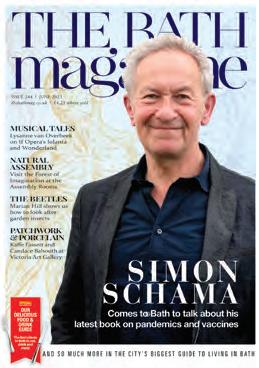 Emma Clegg, Editor
Emma Clegg, Editor
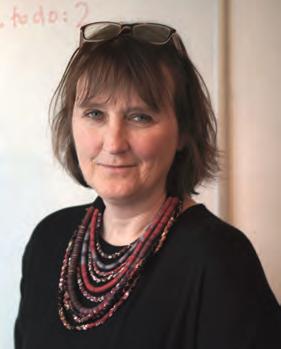

A documentary produced by a team from the University of Bath won two national honours at the British Universities Film and Video Council Learning on Screen Awards 2023. Cobalt Rush, a 20-minute documentary, tells the story of how cobalt used for batteries in electric vehicles is extracted from the ground in the Democratic Republic of Congo (DRC). Produced in-house by University development scholar Professor Roy Maconachie, filmmaker Simon Wharf and Dr Bossissi Nkuba (a specialist in mining governance), it won the ‘Best Educational Film Award’ and the prestigious ‘Premier Award’ at a ceremony which took place at the British Film Institute (BFI) in London. View Cobalt Rush on vimeo.com

The Bath Magazine 2 Princes Buildings, George Street, Bath BA1 2ED; 01225 424499 www.thebathmag.co.uk
Editor Emma Clegg 01225 424592; emma@thebathmagazine.co.uk
Financial DirectorJane Miklos jane@thebathmagazine.co.uk
Assistant Editor/Web Editor Alexis Herrington alexis@thebathmagazine.co.uk
Production Manager Jeff Osborne production@thebathmagazine.co.uk
Advertising Sales Liz Grey liz@thebathmagazine.co.uk
To advertise tel: 01225 424499
Publisher Steve Miklos steve@thebathmagazine.co.uk
Contact us at thebathmag.co.uk Follow us on Twitter @thebathmagazine and Instagram @thebathmagazine

The Bath Magazine and The Bristol Magazineare published by MC Publishing Ltd.
We are independent of all other local publications.
The Bath Magazine is delivered free, every month, to more than 15,000 residential addresses as well as businesses throughout Bath and the surrounding area. We also have special distribution units in many of Bath’s supermarkets.
© MC Publishing Ltd 2023
Disclaimer: Whilst every reasonable care is taken with all material submitted to The Bath Magazine, the publisher cannot accept responsibility for loss or damage to such material. Opinions expressed in articles are strictly those of the authors. This publication is copyright and may not be reproduced in any form either in part or whole without written permission from the publishers.
All paper used to make this magazine is taken from good sustainable sources and we encourage our suppliers to join an accredited green scheme. Magazines are now fully recyclable. By recycling magazines, you can help to reduce waste and contribute to the six million tonnes of paper already recycled by the UK paper industry each year. Please recycle this magazine, but if you are not able to participate in a recycling scheme, then why not pass your magazine on to a friend or colleague.





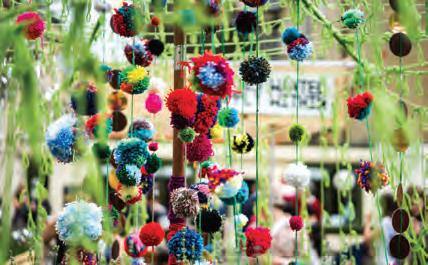
Festival of Nature returns to Bath and Bristol from Friday 9 to Sunday 18 June for its 20th anniversary event. Join the celebration with this year’s unmissable 10-day programme of vibrant city events, family nature parties, wildlife workshops, walks and talks, film screenings, spectacular performances, and digital activities across the week. Includes a bat walk at Bath City Farm, a talk about the discovery of wild beavers in the River Avon, a wildlife boat trip and a screening of the first episode of the brand new series of BBC’s Prehistoric Planet.


... to one of the stand out days in the Bath social calendar. Join fellow racegoers for a show of style and beauty on 17 June at Ladies Day 2023. The exciting racing combines with stylish outfits, ornate hats and of course, incredible food and drink to give you and your friends a day out to remember. Soak up the atmosphere in the Grandstand or celebrate a day in the sun with one of the hospitality packages. Children 17 and under go free when accompanied by an adult. Gates open 12am; first race 1.56pm.Bath Racecourse, Lansdown. bath-racecourse.co.uk
From 14 June until 14 July Bath’s awardwinning, free-to-attend contemporary arts event, Forest of Imagination, is back once again this summer – inviting adults and schoolchildren to ‘Assemble in the Forest’ and connect with nature in a host of imaginative ways. Spaces inside and outside will be transformed into a series of playful, nature-inspired art experiences with multi-sensory installations, soundscapes and sculptures, artists' workshops and a host of creative and community projects from artists, designers and businesses. Free entry for all. forestofimagination.com
bnhc.org.uk/festival-of-nature
Corsham’s joyous, warm and quirky family festival of the arts, Blue Sky Festival, is back at Pound Arts. This year it has taken on a distinctly aquatic theme, with the beauty and power of the ocean highlighted in the paintings of Kit Johns (see image), as well as a National Theatre Live screening of Life of Pi. Also, Corsham Lake provides the inspiration for an exciting new dance performance from the Pound Ballet School’s very own Debut Dance Company. Back on dry land, there’s a whole load of live music, family shows, comedy, workshops, film and visual art to keep you entertained and enthralled throughout the week –including a Father’s Day Extravaganza on 18 June. poundarts.org.uk/festival/blue-sky-festival-2023

The Vegan Platform, Bath’s new and exciting monthly market is located at Green Park Station and is a haven for all things plant-based and sustainable.
On the first Sunday of every month, The Vegan Platform offers a one-stopshop for all your vegan needs, from delicious plant-based street foods, clothing, beauty products, and even household items!.And the best part? It’s free to attend.
The Vegan Platform, open from 10am–4pm, is a space for small businesses that promote a healthy and sustainable lifestyle. By supporting these businesses, you are not only supporting the local community but also making a positive impact on the
environment. So come on down to The Vegan Platform at Green Park Station and discover a world of delicious, ethical, and sustainable products that will tantalise your taste buds and nourish your body and soul. theveganplatform.co.uk
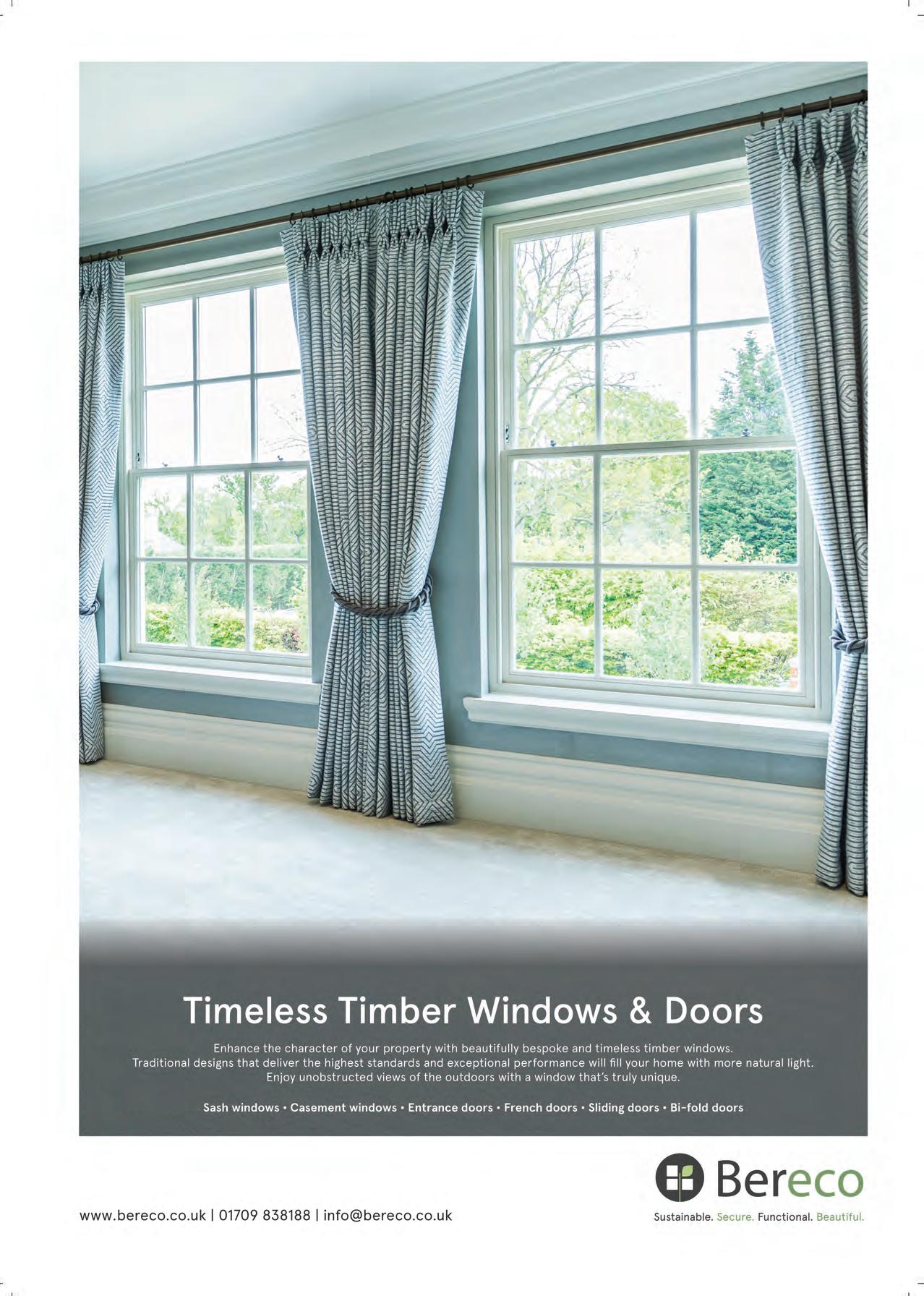
Folk artist Luke De-Sciscio is a singersongwriter of Italian heritage living in Bath. He is known for writing disarmingly honest contemporary folk songs. For several years he lived on a canal boat in Bath. He is performing at Chapel Arts on 8 June.
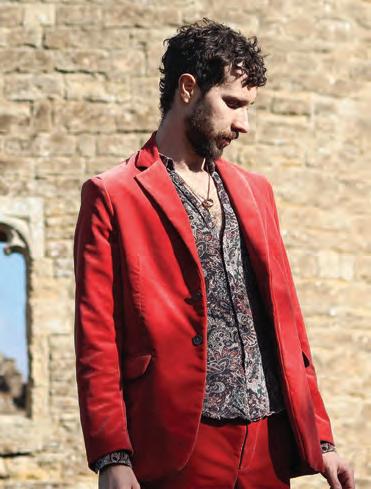
See also page 72
Name: British beetle/Oedemera nobilis Also called Thick-legged Flower Beetle or Swollen-thighed Flower Beetle Length 8–19mm
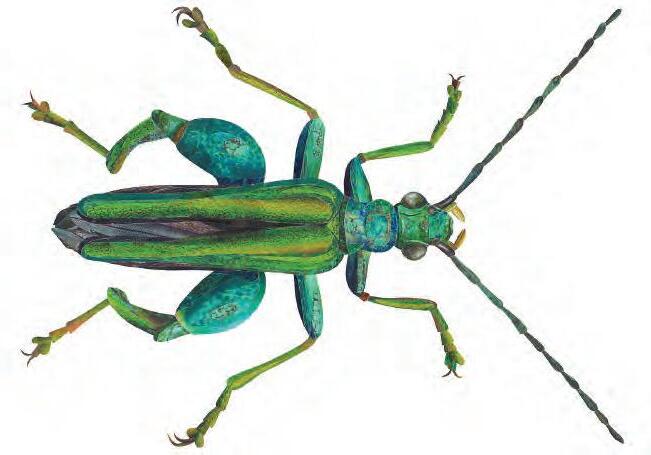
This shiny green beetle is an extremely useful insect. Abundant throughout June, it can be spotted eating pollen from open flowers such as daisies and buttercups which it pollinates in the process. The male beetles have much fatter legs than the females.
Eighteen Bath-based choirs come together on 10 June at Walcot Methodist Chapel to raise money for the Syria and Turkey Earthquake Appeal.
The choirs will sing in 9 x 1 hour concerts running back to back. Choirs include Bath Show Choir, Viva Vocals, Bath Community Gospel Choir, Horizons Choir, The Great Day Choir, Sasparella and the Walcot State Choir. The choirs will perform to the audience and also sit with them and support their peers.

Every choir singer and audience member will be asked to donate a minimum of £5 to perform or listen. It is hoped that 500 singers will take part and there will be at least 500 in the audience. The target is to raise £5000 for the Earthquake appeal. Reserve tickets in advance to guarantee a place at any of the hourly slots, which start at 12pm. Tickets can be reserved at: choirthon.eventbrite.co.uk.
Donations can be made at justgiving.com/page/choirthon. The event is part of the Bath Fringe Festival: bathfringe.co.uk/event/choirthon
Ammi majus (Queen Anne’s Lace), Cosmos, Gaura, Nigella, sweet peas and Phlox ‘Cherry caramel’
I was born just outside Swindon in a beautiful village called Stanton, on the very edge of a wildlife reserve. That upbringing has definitely influenced my relationship with nature.
I came to Bath for an education and what then felt like big-city vibes. I stayed because it’s the most beautiful city in the world.
My grandfather was a guitarist, so early on he was feeding that flame. I went on to study classical guitar, before getting an electric and spending a good few years in ‘rock bands’. It’s a little funny that it’s come full circle, because now I play a nylon string guitar like a rocker and for some reason we call it ‘folk’.
My grandfather played a 12 bar blues and playing this was just magical. The first time I remember hearing the lyrics to a song and thinking, ‘Oh I see, this changes the world’ it was Father and Son by Cat Stevens.
My music is defined by the pursuit to shed layers. To offer as much truth as I can. I’m really driven by the idea that I can chase fear into the light and make love of it.
I record the vast majority of my songs live. It keeps the songs like little time capsules, preserving the emotion as close to the source of creativity as possible.


I like to reach people. We all have access to one another through the internet, and ultimately it’s just about reaching one person. Music can just burn through the internet and once it strikes, that’s it. My game is just be grateful, be ready and when the match strikes, don’t drop the ball. I’m good at capturing lightning and recognising the moment when it’s here.
Living on a canal boat in Bath had its ups and its downs, in equal measure. And they were extreme, for which the dichotomy between summer and winter were the perfect metaphor. It was liberating and pure and changed my whole perspective on what’s important. We existed as a unit of three, Robyn and I and our boat, Rachel. Parting ways was one of the hardest things we’ve had to do. But I needed to establish myself
musically and it wasn’t fair to expect Robyn to maintain the boat and the life it entails when I was so often away. Boats, particularly a 100-year-old one like ours, are totally alive. Withering, constantly changing. What we had was unforgettable. The summers were so potent. Impossibly close to paradise.
I wouldn’t change a thing about where I’m at musically. I’ve come a long way to know precisely what I’m here to offer, how I contribute to the tapestry. I wouldn’t have reached this point in any other city… I’m grateful for Bath, infinitely.
I love Bath’s proximity in every direction to the most beautiful nature you can imagine, such as the river at Bathampton in the summer.
I have performed in many countries, and travelling and singing are the most incredible gift. I adore meeting new people and when you’re standing on stage you get to see everyone in their best light. I’ve had the joy of experiencing cultures I can’t imagine having reached if not for songs. The Polish are beautifully spirited and generous, but they drink like they’re trying to kill you. The Swiss seem reserved but have this emotional readiness that music can just ignite. The Australians just immediately seem like family.
My next Bath show is at Chapel Arts Centre. I’ve hired out the venue and am taking the responsibility of success or failure on my own shoulders. I’ve organised the most incredible support, Ella Clayton, and I just know that she is gonna bring the best performance out of me.
As a show like this gets closer I will wind more and more into this bundle of incoherent intensity, but as soon as stage time happens it will all melt away. I’ll offer my songs in the light they were born for. It’s a wild game and I’m honoured to play it. But these songs are every bit as much because of Bath and the people as they are to do with any influence I’ve had over them.
Luke De-Sciscio, Chapel Arts Centre, 8 June, 8pm. Tickets £12/£14. Instagram: @lukedesciscio
• Naturally insulating
• Hard-wearing
• Easy to care for
• Sustainable
• Hypoallergenic
• Fire resistant
• Available in a wide variety of colours and patterns

The American Museum & Gardens in Bath has been selected to house part of the relocated show garden America’s Wild, presented by Trailfinders and Visit
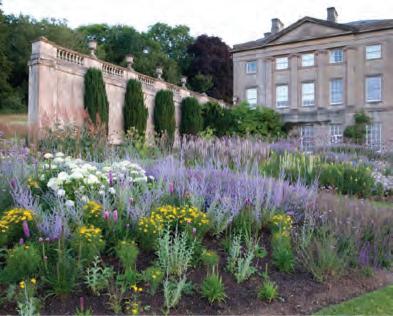
The USA at the RHS Hampton Court Palace Garden Festival from 4–9 July.
The show garden, designed by Jude Yeo, Emily Grayshaw and Imogen Perreau Callf from Inspired Earth, is an intimate experience taking in the sights, sounds and smells of America’s breathtaking landscapes. From the dusty Californian desert to the fiery Aspens of the Colorado forest and wildflower prairies of North Carolina’s sweeping plains. After the Garden Festival, the show garden will be relocated to the US Embassy in London and the American Museum & Gardens in Bath. The trees of the ‘forest’ will be transplanted to create a new Aspen grove on the hillside at the American Museum & Gardens, and the desert and prairie planting will be housed in both existing collections. americanmuseum.org
The Cleveland Pools Trust has won national recognition for ‘Restoration project of the Year’ at the Museums and Heritage Awards as the pools move one step closer to opening for the summer season 2023.

The judges acknowledged the ‘grit and determination’ of everyone involved in the 20-year campaign to save the pools. They recognised the unique challenges of the site and the exceptional community support and involvement that has made this restoration project possible. This recognition follows a challenging few months for the Cleveland Pools after winter floods and ongoing contractual negotiations. Works to install the pontoon and Water Source Heat pump, that will heat the pool water, are currently underway. The pontoon will enable pools’ visitors to access the site via the river and reinforces the Trust’s commitment to improving access for the community while encouraging the use of greener travel options. The Cleveland Pools restoration project is supported by the National Lottery Heritage Fund. clevelandpools.org.uk
Bath World Heritage Centre in York Street has recently celebrated its first anniversary. Supported by The National Lottery Heritage Fund, the centre is a springboard for people to engage with the city’s culture, history and heritage and explore popular Bath landmarks as well as lesser-known places around the city.
Since opening on 9 May last year, the centre has welcomed more than 72,000 people through its doors, from local people wanting to find out about the heritage on their doorstep, to visitors from as far afield as India, the United States, Australia and New Zealand.
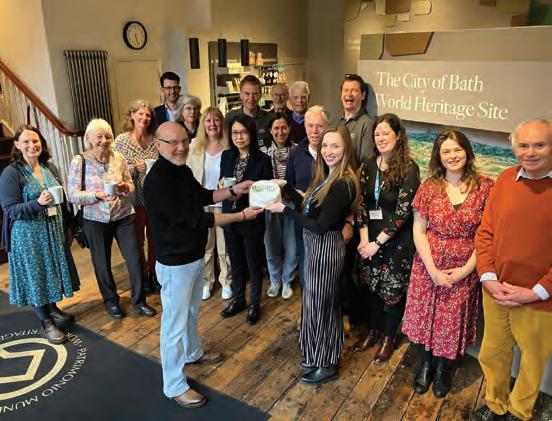

Preparations are well underway for the UIPM Laser Run and Modern Pentathlon World Championships taking place at the University of Bath from 19–28 August.
The Laser Run World Championships combine running and shooting in dynamic and fast-paced races. Ticket-holders for the Modern Pentathlon World Championships will see elite athletes fence, show-jump and laser shoot and run, live from their seats in an outdoor arena, while the swimming section will be broadcast via a large video screen in the stadium. All five sports take place in a new, action-packed 90-minute format making it the ultimate mental and physical challenge for athletes and even more exciting for spectators.
You don’t need to be a die-hard sports fan to enjoy the World Championships. Alongside the thrilling competitive events, an exciting programme of family entertainment is planned including a family day on 22 August where all tickets cost just £5. Trial sessions and great music will ensure everyone has an unforgettable day out. More information and tickets at wch2023.org
The centre features a host of interactive exhibits and displays designed to inspire, excite and inform. Friendly and knowledgeable staff and volunteers are on hand to answer questions and help people make the most of their visit. There are free walking trails and guides to help visitors to the city explore all it has to offer, as well as a specially designed mobile app with lots of fun features.
Find out more about the Bath World Heritage Centre here: bathworldheritage.org.uk/worldheritagecentre


The second edition of Photo | Frome, an inclusive festival dedicated to showcasing and celebrating local, national, and international levels of photographic endeavour and filling the creative south-western England community of Frome with photos, runs from 24 June to 12 July.
The 2023 theme, 'Decolonising Environments', explores the complex and often conflicting relationships between

human communities, places, and the natural world. Encompassing a range of styles, subjects and genres, Photo | Frome invites photographers and audiences to contribute to discussions around the social and environmental impacts of long-standing political, cultural, and economic ideas about our world.
The Festival is taking over 14 of Frome's venues with exhibiting photographers –including Gideon Mendel, Gobinder Jhitta, Jesse Alexander and Keerthana Kunnath –representing some of the most exciting and
captivating voices working in this space. There is also a two-day symposium, a miniexhibition outreach through town retailers, student awards, an open book call, workshops, various community-focused involvement and an outdoor installation. The latter sees large-scale photographs displayed in prominent outdoor locations to reflect the festival's core concept of bringing photography to the local community.
The festival's enhanced content for 2023 represents the three strands to Photo | Frome's curation approach: thoughtprovoking national and international work, photography showcasing the history of the south west, and representation of regional photography.

Photo | Frome has been created by Frome-based photographers David Chedgy, Mick Yates, Martin Bax, and Joao Diniz Sanches, and is supported using public funding by the National Lottery through Arts Council England.
photofrome.org; #PhotoFromeFestival

FAR LEFT: Drowning World, Submerged Portraits Series, Jeff & Tracey Walters, Staines-UponThames, Surrey, Gideon Mendel 2014 LEFT: Five-year old Yamily, El Alto, Bolivia, Celia D Luna 2022



Jewellery has the power to tell a story, capture a moment or honour a loved one. It acts as a window into our personality and has the power to transform the way we feel, on the inside and out.
Josie Mitchell has a passion for all things unique and creating jewellery that acts as a bridge between mental health and affordable luxury. Seeking out the perfectly imperfect forms found in nature that inspire her work, Josie is inspired by ancient worlds and unburied treasure, a childhood of storytelling and imagination. Elements of Josie’s work are inspired by Greek mythology underlying a strong pull towards mental health, two very different inspirations that she manages to capture so beautifully.
Josie started her jewellery business in 2018 in Bournemouth before setting up shop in her hometown, Frome in July 2022. Amongst the chaos of the pandemic, Josie’s mental health along with so many others suffered. But instead of allowing her anxiety to dictate her life, she decided to lean into it and create jewellery with tactile features and organic texture to help calm her everyday anxiety’s. This became a pivotal focus that led her to create jewellery with a tactile and organic nature, inspired by Greek mythology and the surrounding world, to help everyone connect to a deeper sense of calm through the mindfully hand crafted treasures, even Fearne Cotton has been seen wearing a number of her creations!
heirloom re-designs, allowing her customers to re-imagine their passed down jewellery into a new treasure that captures the wearers individuality while paying testament to their loved ones.
You can visit Josie in her Frome studio/shop and see her work in person, or get in touch to discuss a bespoke consultation.
Want to learn how to make your own jewellery? Josie offers intimate jewellery making workshops! Head over to her website to learn more and book your tickets.

“For me, creating jewellery that not only tells a story, but has the power to transport our minds to a place of calm is irreplaceable. In a world of constant stress and anxiety, having something tangible you can hold in your hands is incredibly grounding and instills a wonderful sense of presence” - Josie
Josie is best known for her exquisite bespoke engagement and wedding rings that are inspired by unearthed treasure, each one full of delicate details and timeless textures that capture the beauty of the stones it holds.
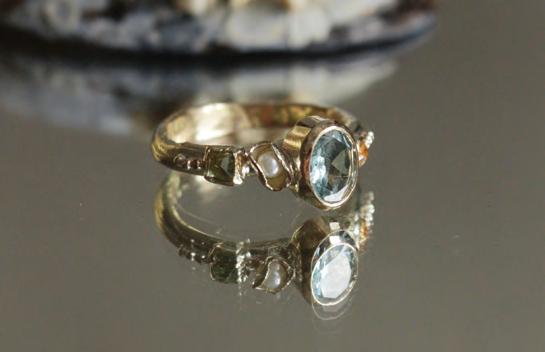
Working with her customers in a collaborative relationship, Josie is able to capture her clients ideas with her creative expertise. She works closely with her clients to re-imagine their unworn jewellery, or create the perfect engagement ring, ensuring the customer is a part of the journey.

Living by the coast for 4 years had a profound impact on Josie’s work and inspired many of the organic and unique textures that are seen in all of her creations. The Siren scale pattern has become a customer favourite and evokes a truly ethereal and mystical appearance that mimics a mermaid tail.
Not only does Josie offer a bespoke bridal service, she also specializes in
Josie Mitchell has a passion for all things unique and creating jewellery that acts as a bridge between mental health and affordable luxury.

Columnist Richard Wyatt loves roving around the city where he takes pleasure in the city’s green spaces. So he went to talk to Team Manager Keith Rowe at the Council’s Parks Department to ask how they are created and maintained
Those who know me well will be aware that I can’t stand plastic flowers and shudder every time I pass a Bath-based business doorway festooned with them.
I know it’s the cheaper option to have continual and attractive colour to lure your punters in, but give me a trough or flower bed filled with the real stuff and I (and all nectargathering insects) am much happier.
June is the month the city’s flower beds, troughs and baskets should be coming into their best. Much of what we see around Bath –in places like Royal Victoria Park and Parade Gardens –is down to the work of the local authority’s Parks and Green Spaces department. Bath has had quite a reputation for its floral displays over the years and collects silver and gold medals frequently from its showing in both South West in Bloom and Britain in Bloom, which celebrates its 60th birthday this year.
Most of our city green spaces are managed by the council’s Parks Department under its Team Manager, Keith Rowe, and I asked him some questions:
Q: How big is the challenge?
A: I have a team of approximately 60 people at any one time, including seasonal staff, and every year we are involved with more and more green space across B&NES which puts pressure on staffing levels and budgets.
Q: How many plants are used each year?
A: Our Victoria Park nursery will grow in the region of 100,000 plants per year –all now grown in peat-free compost and without the use of pesticides.
Q: Which is the most important season?
A: Spring certainly, within the nursery, but it can also be the most difficult with the widely varying temperatures. This is the season when all our plants are grown on –either by plugs, seeds or cuttings. If we have a cool spring, then our displays will not be ready for installation for the beginning of June. It’s not quite Chelsea but its a real challenge when you have fixed dates like a Jubilee or Coronation which need displays at their best.
Q: Are there trends in flowers and designs and how does climate change affect planting?
A: We are using more drought-tolerant plants such as geraniums, Echeverias and Angelonia
in our displays and choosing plants that are single flowers to encourage pollinators. We have introduced reservoir hanging baskets now to all locations in the city, which greatly reduces the cost and supply of water. An old-style wire planter made in moss will need to be watered 3–4 times a week, the new style (in an average British summer) only once per week.
Our newly planted trees are mulched with bark to suppress weeds and retain moisture and a Gator (bag) is fixed to the stem for the first few years to help with watering. The bag is filled with water and it slowly releases it in a controlled manner.”
Q: Most of our parks now have hard-working groups of volunteers who become ‘Friends’ of the green spaces. How important are they?
A: Friends groups contribute significantly to parks and open spaces right across the B&NES area and their offers of help range from regular gardening sessions and litter picking, to fundraising and running events and activities.
Keith’s Parks Department gets help from another direction too. The Bath BID works closely with them, especially at this time of the year when the BID buy plants from the nursery for their street displays which add to the city’s floral character.

A: We lease the bottom end of the RVP nursery to a social enterprise called Urban Garden who run a small plant nursery and offer horticultural therapy and training courses. The plants that they grow within the Parks greenhouses via the course and therapy sessions are then sold in the garden centre. We also host another charity at the RVP site. More Trees B&NES grows native stock trees from seeds gathered in the wild. These seeds are germinated and grown on for the first year on the site at RVP. The group are currently setting up a number of Community Nurseries across BANES and the young trees will then go out to these nurseries to grow on and eventually be planted out around the district.
Last year more than 7,000 trees were germinated and are now heading out to the various nurseries.
Good news indeed Keith. Long may Bath, and your nurseries, bloom. n
Tacked on to the department’s nursery at Royal Victoria Park is a garden centre that claims to be the smallest in the area. I ask Keith to tell me more.

Simon Schama recently came to Bath to speak about his new book at Topping & Co. Emma Clegg took the opportunity to catch up with him and find out why the historian –who has written a host of award-winning books, including Citizens and A History of Britain –settled on pandemics, vaccines and the health of nations as his latest subject

We know about pandemics; we have lived through Covid-19. But Covid was just the most recent chapter in a long history of outbreaks of infectious disease including plague, cholera, flu and severe acute respiratory syndrome coronavirus (SARS-CoV). Historian Simon Schama with his specialisms of art history, Dutch history, Jewish history and French history might not be the obvious contender for writing a book about pandemics. Yet a historian with a brilliant, enquiring mind and an unerring ability to snare his readers’ attention with the drama of his themes can take on any tranche
of history that captures his imagination, as Schama proves with his latest book Foreign Bodies: Pandemics, Vaccines and the Health of Nations.
Covid interrupted Schama’s book Turn of the Tribes, which he was then writing, about the culture of populated nationalism. As he says, “When the pandemic happened I thought that this was one moment when national borders cease to have much relevance as viruses and bacteria cross them. We needed states to collaborate with each other in the production of vaccines … although ‘dream on’ was the answer to that.”
With our lives engulfed by the pandemic
we all came across the World Health Organisation (WHO), as did Schama, but he went further and investigated its founding in 1948 and then went to their history archive to read about the Sanitation Conferences from the 1850s, which encouraged collaboration between states to deal with cholera in infected populations. “I thought, ‘Wow, this is the first transnational organisation to do something other than to make war or peace’,” he says.
One of those featuring in the first part of the new book is French epidemiologist and hygienist Adrien Proust (1834–1903) – the father of novelist Marcel – who played a crucial part in the understanding of epidemics. In the 19th century, he was one of the major proponents of social distancing and quarantine –which he called ‘sequestration’ –for cholera, the plague and yellow fever, all infectious diseases causing widespread deaths at the time. “Proust was one who saw how epidemics could be so easily spread,” says Schama. “and questioned what sense there was for nations to deal with contagion just within their own territory.”
“This was the last generation who didn’t know about germ theory. They had never seen a virus; even though there were reviews about it, they hadn’t been seen under the microscope. Nobody had really thought, especially in Britain, the world’s greatest trading nation, that disease could be spread by travel. And you could simply pick up cholera by getting into a carriage – either a railway carriage or a horse-drawn carriage –and putting your hands on the upholstery, not knowing that cholera is a vibreo with a particular type of microbe. Proust understood that there was this brutal paradox between our increasing embrace of modernity, and our developing knowledge about microbiology, which made us more likely to be fatally vulnerable to these pathogens.”
Not only did Proust systematically contain those affected and recommend frequent face and hand washing, he focused on the importance of hygiene in transport, and the interruption of communications by land or sea to stop the diseases spreading. We understand this now, but then it was anathema to government and the populace. “It was through the movement of humans,
Nobody had thought, especially in Britain, the world’s greatest trading nation, that disease could be spread by travel
Proust wrote unambiguously, that pandemics spread their fatal net… This all now seems self-evident, but in the 1870s and 1880s it was anything but,” says Schama.
In his research Schama also came across Waldemar Haffkine (1860–1930), a Russian-French bacteriologist known for his pioneering work in vaccines, but whose name had become hidden within history, surprisingly unrecognised in the modern world. He worked at the Pasteur Institute in Paris, and is recognised as the first microbiologist who developed and used vaccines against cholera and bubonic plague, in the case of cholera a vaccine that he introduced in India for mass inoculation. Notably he first tested the vaccines on himself. He is just one of several Jewish scientists mentioned in Schama’s book who worked with disease and whose religion often held back the acceptance of their ideas, due to the prejudice of those responding to them.
balance disturbed and its life threatened by sustained and negative human interactions: “[History] has been circumscribed by what we have done to nature and what it has done to us,” says Schama in the prologue.
While his book is about the history of disease and inoculation there are also many strands of contemporary observation about Covid and the modern world. “Much of the hostility to our Covid-19 vaccine and to Fauci and others was because the new methodology uses a molecule called Messenger RNA (mRNA). […which is not part of an actual bacteria or virus]. Somehow this themes to our very conspiracyminded social media madness between sinister, inexplicable things –where people don’t really want to learn the science, even though it is at a level that is perfectly understandable by laypeople. Suddenly you develop all these mad paranoias where you have 5G chips inserted into your arms or a plot by Bill Gates or George Soros.”
“There has been a lot of talk in newspapers such as TheNew York Times about the need to institutionalise what we have understood from the experience of Covid. My book is about episodes in the past and I wanted to let readers feel the resonance that it has for us now. That’s why the opening chapters [including references to Covid-19 and the disruption of the natural world] are what they are.
“When a writer like me gets a sniff of a really interesting story with a very unlikely character in the middle of it, that’s what sets me off,” says Schama. You’ll certainly feel a sense of injustice as you read his words about Haffkine’s pioneering work and his unfair and unfounded suspension by the authorities from the laboratory he had established at Byculla, Mumbai, in 1896 – later named the Haffkine Institute – which is told grippingly within the book.
“The heart of the matter of this subject, one that I grasped quite early on, was really the paradox we all live in, with humans being extremely ingenious, resourceful and scientific and at the same time a bundle of primitive impulses, paranoia and anger… so it all came out of that.”
On the one hand you have the scientists and bacteriologists on the frontline of evolving medical discoveries; on the other you have the politicians, business leaders and decision-makers with quite different reference points who can be unaccepting and obstructive to new scientific findings. In the UK during the pandemic politicians and medical experts seemed to work relatively harmoniously together; in the US not so well with the renowned infectious-disease expert and public health leader Anthony Fauci demonised for much of his commentary, and Schama brings Fauci into the debate at the end of his book. Go back 125 or so years to a time when epidemics and viruses were not properly understood by most of the medical community and there is a raft of opportunity for confusion and conflict. We know that vaccines introduce infected foreign matter into a healthy body, and that this triggers an immune response. But in the late 19th century this was a hard truth to promote.
“Haffkine was an unknown young bacteriologist and he became an extraordinary practical kind of evangelist. He became famous by always inoculating himself first in public in a demonstration that used a live vaccine and not a sterilised vaccine – so you can see why people would have needed a lot of persuasion,” says Schama.
“It was quite clear that people in this period treating public health policy in countries like India didn’t understood how vaccines worked and they were very reluctant to take on board germ theory when it became published in the 1880s. They literally didn’t have time or didn’t want to understand it. Everything was taken care of by the massive army and the extensive disinfection policies with carbolic acid and limewash. Haffkine of course would make all that unnecessary. But he had to persuade people that putting a little bit of the poison that would otherwise kill someone would actually save them, not kill them.”
I wouldn’t describe Schama as quietly observational about the stories he recounts. He is invested in the characters he describes, in what they achieved, and in the way that developing science has not always been understood, recognised or heeded by those in power. And in how pandemics indicate that the natural world is out of kilter, its

“When you get to be a really old person, as I am, you either go off and play golf and treat history as a happy stroll down memory lane, or you become a bit urgent about writing the kind of histories that might move the needle a tiny bit towards something better. And I’m not interested in golf.” n
Foreign Bodies: Pandemics, Vaccines and the Health of Nations by Simon Schama, Simon & Schuster, £30
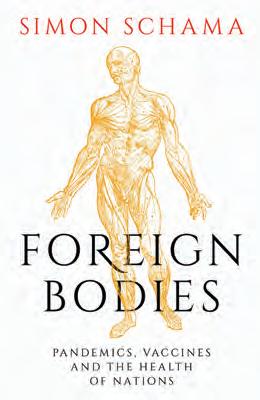
My book is about episodes in the past and I wanted to let readers feel the resonance that it has for us now
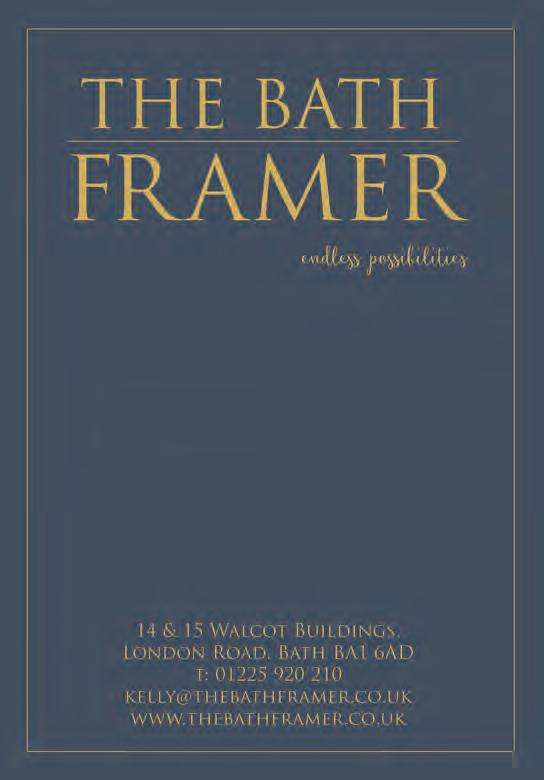







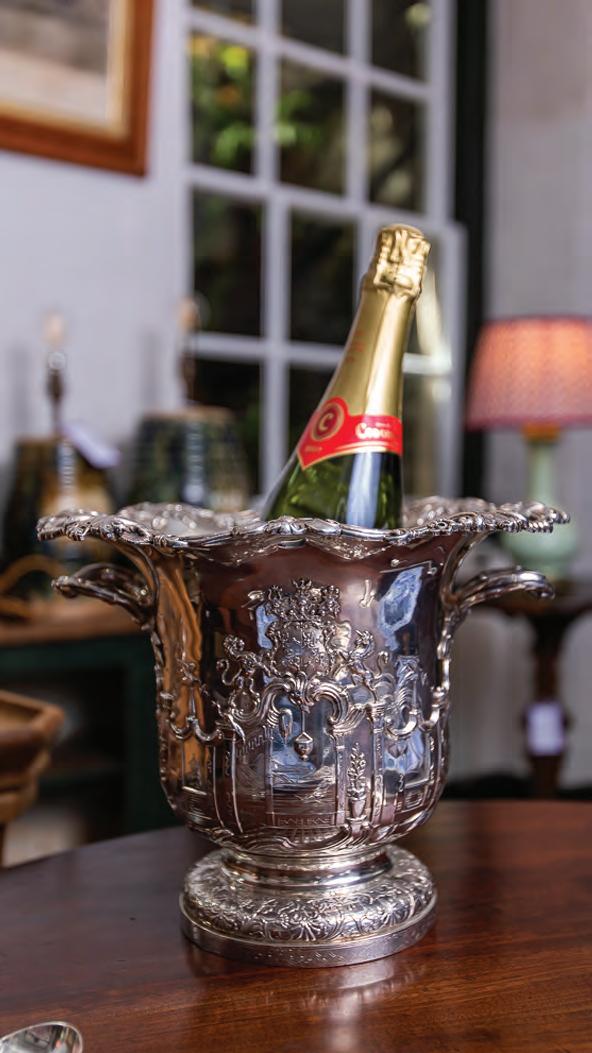
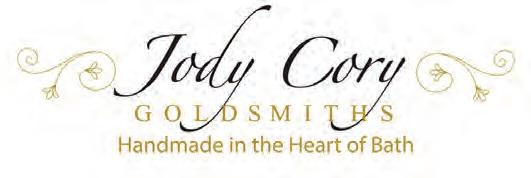








Late 19th Century Persian Khatam Kari Marquetry Tombak Drum.


SOLD £8450 incl. premium

Pair of Chinese Silk Embroidered Lacquer Fans, Qing Dynasty.

Japanses Porcelain Double Gourd Carp Vase, Makuzu Kozan (1842–1916).


SOLD £5980 incl. premium
Set of Nine Chinese Famille Rose Porcelain Graduating Cups, Late Qing Dynasty.
SOLD £7800 incl. premium David Hockney (b.1937) - ‘Red Square and the Forbidden City’ (1982), Lithograph.





SOLD £2600 incl. premium
SOLD £5980 incl. premium








Chinese White Jade and Russet Water Pot, Qing Dynasty.




SOLD £3640 incl. premium

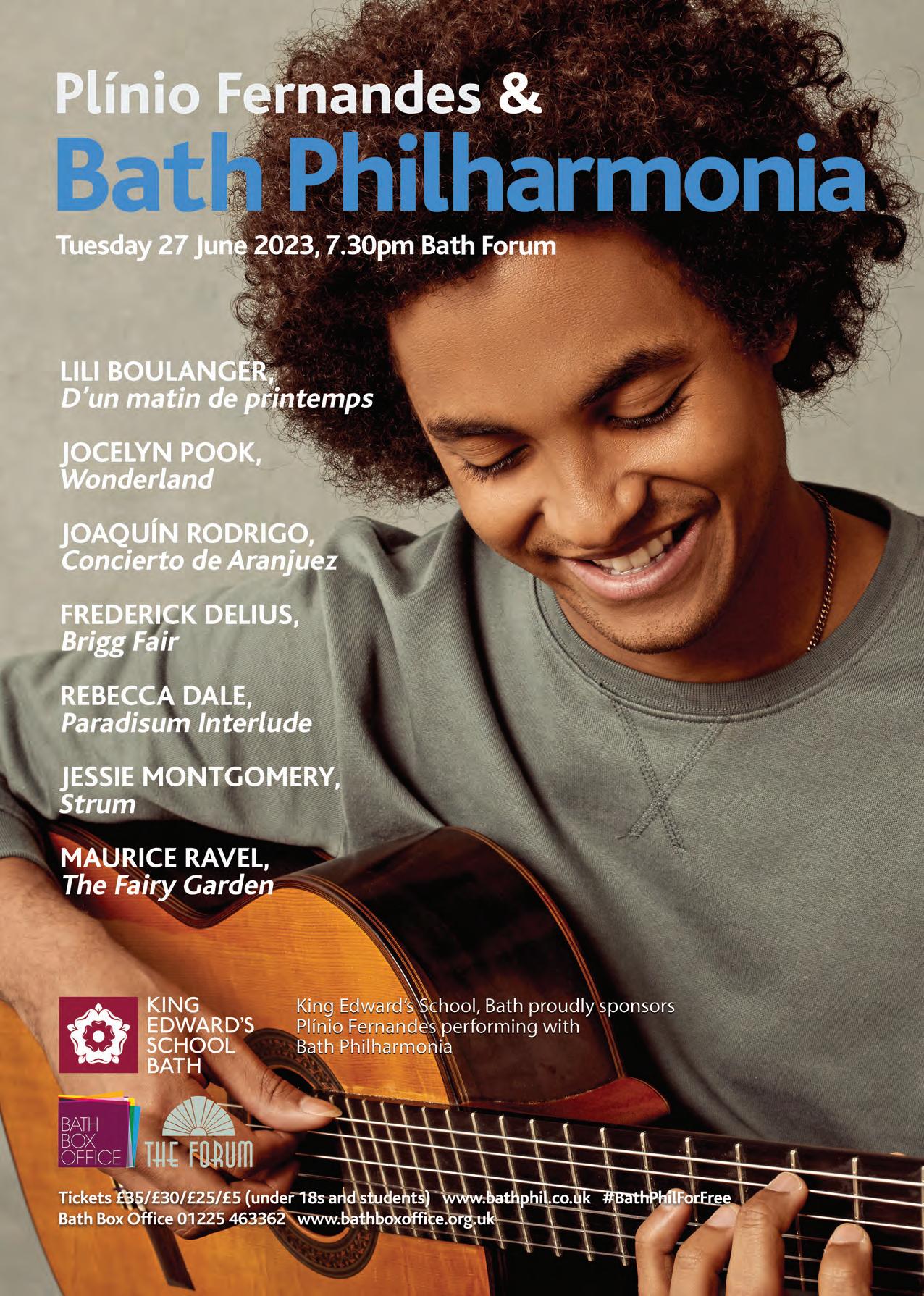
As two-tone ska revival band The Selecter prepares to take the stage at Bristol Sounds on 24 June, we sit down with lead singer Pauline Black to talk four decades of making music…
 Photograph by Dean Chalkley
Photograph by Dean Chalkley
The Selecter’s frontwoman Pauline Black and the band are on tour with Jools Holland after having just finished a UK run of their own, promoting their sixteenth studio album, Human Algebra, released on 21 April. Black is also in the midst of making a documentary based on her 2011 autobiography, Black by Design, and she’s days away from playing the first of many festivals that The Selecter are booked for this summer. Some 44 years after their inception, the seven-piece two-tone band from Coventry, who gave us On My Radio and Three Minute Hero, are busy and showing no signs of slowing down.
In May 1979, the same month that Margaret Thatcher became Prime Minister, The Selecter first appeared with a self-titled track on a shared record with The Specials. With Black and Arthur “Gaps” Hendrickson on vocals, the release marked the birth of what would become one of the most prominent acts of the ska-punk movement, which was named after the independent record label that signed them – 2 Tone Records, set up by The Specials’ Jerry Dammers. Others on the label included Madness, The Beat and the Bodysnatchers.
Two-tone paired energetic Caribbean ska rhythms with conscious lyrics that reflected the struggles of working-class Britain. The Selecter used their politically charged, hook-laden songs to spread their antiracist, anti-sexist mantra and, in turn, unite youth tribes: skinheads, mods, punks, rude boys and rude girls. The Selecter’s 1980 debut album, Too Much Pressure, tackled the social issues of the time and found its way into the top 10 the year it was released.
“Through the power of music, we wanted to show that different cultures, people from different backgrounds and different classes could come together and find common ground,” Black tells me. “If you don’t start conversations when there are problems – and obvious problems – they will never get solved. I feel that we started the conversation about racism, about sexism just by existing and in the way that we presented ourselves in the charts.”
influenced by female musicians like Joan Armatrading, Joni Mitchell and Joan Baez, Black was always drawn to those that “had something to say, people like Bob Dylan” and, once she started making the journey towards two-tone, people like Bob Marley.
“The person who made me think ‘maybe I could do that’ was Poly Styrene from X-Ray Spex,” says Black. “I saw her on Top of the Pops when they had released Germfree Adolescents and thought she was absolutely amazing. It was the first time that I'd seen a woman of colour, somebody who looked a bit like me in a band that I could relate to, telling her truth.
“I liked the idea of punk; I liked that do-it-yourself culture, mixing up genres and coming up with something different and I feel very much that The Selecter achieved that.”
Black’s career to date is varied and venerable. After The Selecter split up in 1982, the singer went on to become a TV presenter before trying her hand at acting, winning Time Out’s best actress in 1991 for her stage portrayal of Billie Holiday. In 1992, however, a third wave of ska music began to sweep across America. Artists and bands, including the likes of No Doubt, were calling for the reformation of The Selecter.
“America’s young artists were saying, ‘Hey, come over and do a tour’ and so we reformed another version of band. My life has very much been like that and I’m grateful for it,” says Black. “Just when you’re coming to the end of one thing, a door suddenly pops open and it’s something new and different to do.”
After the US tour and a few hiatuses during the nineties and noughties, The Selecter began to pump out new songs in 2011, their sound ever-evolving but their success standing the test of time. How do they account for their longevity?
More than four decades on, their messages are just as relevant and their music continues to move audiences. Their latest album focuses on knife crime, fake news, the environment, Brexit and war, and questions and challenges today’s politics. Most notably, the title track includes a particularly evocative chorus hook, “Mama’s so blue”.
“Everybody knows that a lot of our youth are stabbing each other on the streets but no one is coming up with any answers to solve it. It seems to me that we’re doing a tremendous disservice to the young people in this country – and in others as well – and that we’re more or less condoning that this is some way to settle an argument. We’re all horrified by it, but completely powerless to do anything about it.
“What I wanted to do in that song was highlight a mother’s grief and how that radiates out through an extended family. It’s not just the perpetrator and the victim, everybody becomes affected by it and then the community becomes affected by it. It seems like we’re in a state of paralysis at the moment without the necessary tools to figure it out.”
Human Algebra was finished in July 2022 – the day that Prime Minister Boris Johnson resigned – “it was a wonderful arc,” laughs Black, always striving to be an antidote to the wave of conservatism –whether it be 1979 or 2023.
As one of few women in the two-tone scene – and often referred to as “the Queen of Ska” – Black was awarded an OBE in the 2022 New Year Honours. Pushing the boundaries in music and fashion, the singer had to find where she fitted into the industry. Heavily
“As young as we were back then, we were channelling some kind of truth that needed to be said. I think all of the bands [from the twotone movement], to my knowledge, are still in existence. There is still a version of The Specials, The Beat, Bad Manners, Madness, The Bodysnatchers. That speaks volumes about what we had to say.”
As for the artists of today, Black champions those “carving a different path”. “I went out on tour with Gorillaz back in 2018. I did a track for their album and Damon Albarn invited me out to South America, which was really joyous. Little Simz was there and no matter where she went, she bought the house down. I really like what she has to say and I respect what she’s doing. I also like Kendrick Lamar; his Glastonbury performance was second to none.”
The Selecter will be gracing the stage at Bristol Sounds on 24 June, supporting chart-topping folk-rock band, the Levellers. “We’re absolutely honoured to be asked by the Levellers to play. I love their way of working and it chimes completely with ours.”
“There is something about playing to an absolutely bursting-atthe-seams venue where your feet are sticking to the floor, the audience is practically on top of you and they’re all just going mad for the music. There is nothing better than that.” n
The Selecter will be playing at Bristol Sounds on Saturday 24 June, supporting Levellers. For more information and to book tickets, visit: bristolsounds.seetickets.com
 Photograph by Michael Wharley
Photograph by Michael Wharley
Through the power of music, we wanted to show that people from different backgrounds and different classes could come together and find common groundBristol Sounds, photograph by Paul Box
MUSIC AT GREEN PARK BRASSERIE
n Green Park Brasserie, Green Park
Enjoy live jazz/funk/soul/swing at Green Park Brasserie on Weds and Thurs from 6.30–8.45pm and Fri and Sat from 6.30–9.45pm. Music includes dynamic duos, modern trios and a Hot Club style quintet. greenparkbrasserie.com
BATH FRINGE FESTIVAL
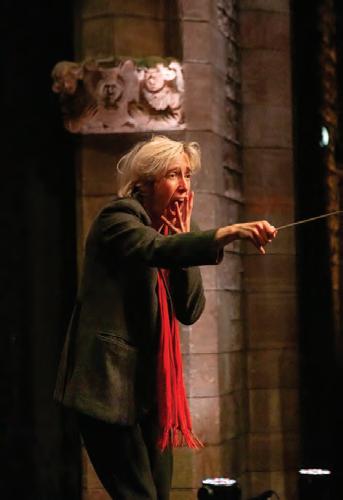
n Various locations
Until 11 June
The Bath Fringe is a festival of all the arts, with few rules as to what should be in or out – it’s what people want to do, and what venues in Bath want to put on. It all happens for two long weeks and three weekends. Includes comedy, theatre, dance, music, and art with Fringe Arts Bath (FaB). See the website for full details of all the events in store. bathfringe.co.uk
EXHIBITION: AMERICA IN CRISIS
Until 4 July
n The American Museum & Gardens, Claverton Down
The American Museum & Gardens are hosting a major American photography exhibition on its first and only showing outside of London. The exhibition features over 80 photographs from 39 top American artists – both contemporary and historic – as well as an interactive immersive experience that explores image classification and consumption. americanmuseum.org
RICHES OF THE EARTH: THE BEAUTY OF MINERALS
Until 7 October
n Bath Royal and Literary and Scientific Institution, 16–18 Queens Square, Bath Riches of the Earth reveals the beauty of minerals through the astounding forms and vibrant colours of more than a hundred carefully selected specimens from the BRLSI collection. The exibition is free to attend. brlsi.org
ALLIUM MONTH AT THE AMERICAN MUSEUM & GARDENS

Throughout June
n The American Museum & Gardens, Claverton Down, Bath
Experience hundreds of alliums blooming in succession through the gardens, in a beautiful display loved by bees and visitors alike! This is one of the many seasonal highlights of one of the best gardens to visit in Bath, created by garden designers Oehme, van Sweden. Admission to Gardens and American Garden Deli £10/£7. americanmuseum.org
UNLOCKED –CONTEMPORARY DANCE PERFORMANCE

1–2 June 7.30pm
n Mission Theatre, 32 Corn Street, Bath Nova Grace Productions presents Unlocked, as part of Bath Fringe Festival. From bedroom to stage, four contemporary dancers reflect on life in and out of lockdown. This unique project reflects on the whole ‘Covid-19’ experience and aims to help people talk about what lockdown was for them. Jumping on beds, climbing through windows, rolling in duvets and dancing with mops, this moving performance will take you on a journey back in time. You can also join the post-show Q&A. Tickets £14/£8 bathboxoffice.org.uk; missiontheatre.co.uk
THE ROYAL BATH & WEST SHOW
1–3 June
n The Showground, Shepton Mallet, Somerset BA4 6QN
Come and enjoy a Great British family day out. The show will feature interactive activities, fast-paced excitement in the Main Ring and an enhanced food hall experience. Meet the producers of the finest food and
drink in Britain, ranging from funky street food to ‘sit, eat and enjoy’, to the finest produce you can take home to cook and share with all the family. bathandwest.com/tickets
AN HOUR IN FRANCE
4 June, 7.30–8.30pm
n Mission Theatre, 32 Corn Street, Bath Come on a musical journey across a country with a rich and complex musical history. Countertenor Joe Levy and pianist Peter Adcock provide a concert exploring the classical tradition of French music. Taking place within one hour, this is a lively snapshot of French classical music. Part of the Bath Fringe 2023. Visit bit.ly/hourinfrance for tickets

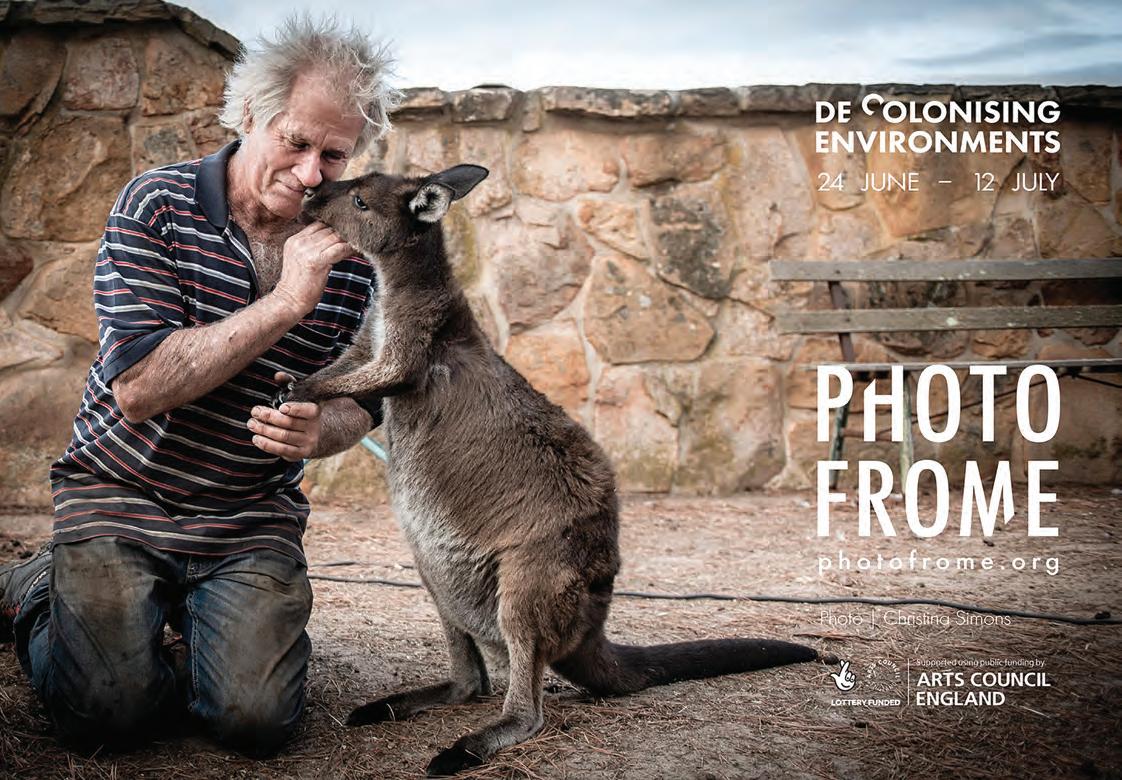
THE ARTS SOCIETY BATH | WEDGEWOOD
5 June, 11.30am
n Widcombe Social Club, Widcombe Hill, and live-streamed
Lecturer Jane Gardiner explores the contribution of Josiah Wedgwood to the history of world ceramics. To attend as a guest (£10 in venue or £7 on Zoom), reserve a place by emailing bath@theartssociety.org by 2 June. theartssocietybath.com

6 June
n Milsom Place, 41 Milsom Street
Pookie Blezard of Pazuki, one of the fabric designers for DiGuardo, will be in the shop to talk about her work. Her still life paintings are the source of colours and pattern that evolve into prints for her Pazuki collections. diguardoboutique.com
PROTECTING YOUR SKIN AND UNDERSTANDING THE SIGNS AND SYMPTOMS OF SKIN CANCER
6 June, 6.30pm–8pm
n Sulis Hospital, Foxcote Avenue, Peasedown St John, Bath
Staying safe in the sun is the most effective way to protect against skin cancer. Consultant Plastic Surgeon Mr Dominic Ayers, explains how to stay safe whilst enjoying the sunshine. He will explain
skin cancer in detail and talk through the three major types of skin cancer explaining how to detect suspicious changes early. Prebook by contacting vicky.botsford@ sulishospital.com or call 01761 422288 to confirm your place. sulishospital.com
LUKE DE-SCISCIO PLUS ELLA CLAYTON
8 June, 8pm
n Chapel Arts, Lower Borough Walls Bathonian songwriter Luke De-Sciscio is embarking on his first headline tour of UK theatres. His deeply introspective lyricism and elastic voice have garnered comparison to Nick Drake, Leonard Cohen and Jeff Buckley, yet eschew expectations. Tickets £14/£12. chapelarts.org
GARDEN GROOVES

9 June, 5.30 pm–9.30pm
n The American Museum & Gardens, Claverton Down
Enjoy an evening with the Iain Ballamy Trio, who will be performing their favourite jazz standards, with a few Brazilian numbers as well. Soak up the views across the Limpley Stoke Valley, and choose from light supper and refreshing drink options at the Deli. Tickets from £13. americanmuseum.org
FAMILY FUN DAY AT ROYAL HIGH PREP SCHOOL
10 June
n Royal High Prep School, Lansdown Road
Enjoy a fun family day out at Royal High Prep School’s beautiful Cranwell House with food and drink, charity stalls, games and activities, bouncy castle, zorbs and more. Drop in between 1pm and 4pm for icecreams, cakes, drinks, stalls and a whole host of activities for all ages. Book tickets for free in advance or for £1 adult/50p child on the door. royalhighbath.gdst.net/
BATH SPA DEGREE SHOW 2023
10–17 June, 10am-6pm
n Bath Spa University, Locksbrook Campus Locksbrook Road
An exhibition showcasing the work of Art and Design students from Bath Spa University where members of the public are invited to go along to see the work. bathspa.ac.uk
LANSDOWN OPEN GARDENS
11 June 2pm–5.30pm
n Various gardens
The annual Lansdown Open Gardens sees six gardens open across Lansdown as well as a plant sale on the St. Stephen’s Millennium Green with teas and home-made cakes. Proceeds go towards the upkeep of The Millennium Green. Tickets £5 (children free). Purchase tickets on the day at the Millennium Green or at the gardens or in advance at millenniumgreen.org.uk/ opengardens23
ALDRIDGE’S OF BATH AUCTION
13 June, 9am–12pm
n Online Decorative and household sale, including Victorian, Edwardian, 20th-century and modern household furniture and furnishings, decorative china and glass, pictures and

prints, mirrors, rugs, etc.; also garden furniture, tools and general household goods. aldridgesofbath.com
THE SAVIOURS
16 June, 7pm
n Komedia, 22–23 Westgate Street
The Saviours Collective brings an evening of well-known R&B soul hits to Komedia to dance the night away and celebrate the joy of live performance. Formed in 2015, the band comprises local musicians from Bath and Bristol. This performance is in aid of Genesis Trust. Tickets (standing) £15. komedia.co.uk
STARSTRUCK: 20 YEARS OF THE HANDFUL
24 June 7.30pm
n St Mary the Virgin, Bathwick
The Handful’s 20th anniversary concert sees the choir showcasing a new commission alongside a selection of pieces from the past two decades. At the core of the programme are two works: Stargazer by Alec Roth, four with close harmony partsongs, and Eric Whitacre’s Five Hebrew Love Songs with spine-tingling harmonies. The choir will also perform a world première of a new commission, This Union, by award-winning composer Kerensa Briggs using text by Hafez, a 14th-century Persian poet. For this performance the choir is joined by two local musicians, pianist Jamie Hamilton and violinist Sara Stagg. Tickets £15/£5 concessions. bathboxoffice.org.uk
PLINIO FERNANDES AND BATH
PHILHARMONIA
27 June. 7.30pm
n The Forum, Bath
A summery evening of sumptuous orchestral music and dazzling seasonal colours including Delius’ Brigg Fair and featuring brilliant, young Brazilian guitarist Plínio Fernandes performing Rodrigo’s iconic guitar concerto –Concierto de Aranjuez. £25–£35/£5 concessions. bathboxoffice.org.uk; bathphil.co.uk



IFORD MANOR JAZZ FESTIVAL
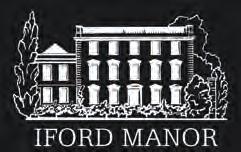
29 June - Antonio Forcione & Adriano Adewale in the Cloister (limited availability)
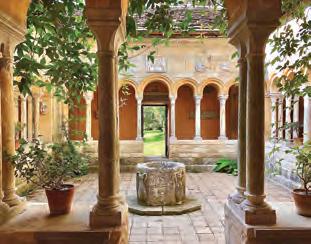
30 June - Summer Garden Soirée: Georgina Jackson & band, and more...

1 & 2 July - 3 course lunch with BBC Young Jazz Musician of the Year (SOLD OUT)

1 July - Garden Jazz with Ronnie Scott’s All Stars feat. guest Claire Martin, & more.... (SOLD OUT)


JOHN RUTTER WITH THE OXFORD PHILHARMONIC ORCHESTRA AND MIDAM CHOIR
27 June. 7.30pm
n Bath Abbey
An unforgettable evening of beautiful music at Bath Abbey. Featuring talented members of the Oxford Philharmonic Orchestra, composer and conductor John Rutter will be leading the orchestra and conducting a thrilling programme that includes his own works Magnificat, Te Deum, and Requiem, each a masterpiece in its own right. The concert will feature participating choruses from around the world. Tickets £7–£30. bathboxoffice.org.uk
IFORD JAZZ FESTIVAL
29 June –2 July
n Iford Manor, Iford
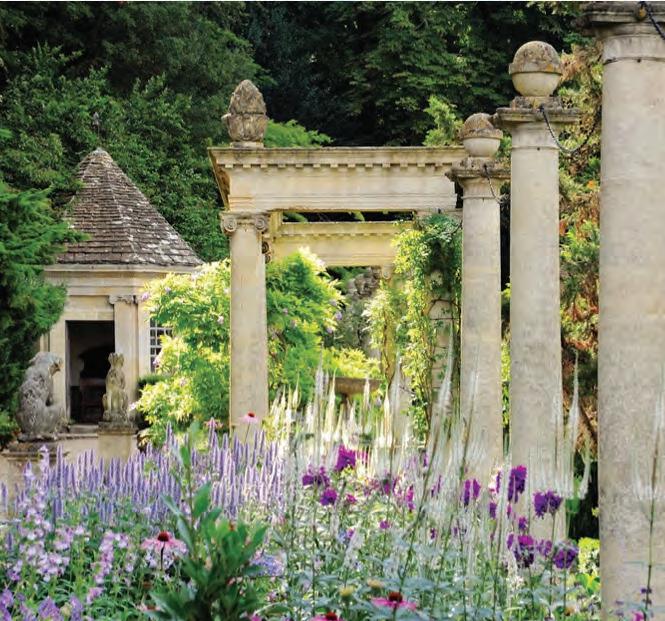
Iford Manor Jazz Festival 2023 is open for bookings! A series of jazz events over four days. The opening night on 29 June sees Antonio Forcione join Brazilian percussionist Adriano Adewale to form a duo which blends soul-jazz and Brazilian guitar with African and Latin rhythms. Garden gates open at 6.30pm, first set 8pm. For more information visit ifordmanor.co.uk n
ACROSS THE POND
1 July 7pm
n Bath Abbey
The Abbey anticipates the festivities for 4th July American Independence Day and celebrates the ‘special relationship’. Music is inspired by the vibrant and unique cultural bond between the UK and the USA. Featuring composers such as Leonard Bernstein, Aaron Copeland and Moses Hogan and celebrating the cross-cultural influences on the creativity of others such as Benjamin Britten.
Tickets from £10. bathboxoffice.org.uk
SHAKESPEARE LIVE: THE MERCHANT OF VENICE
3–8 July 8pm
n Cleeve House, Seend, SN12 6PG
The contemporary Venetian setting in this passionate production directed by Andy Cork taps into the themes of money and greed, love and betrayal, the role of law, religious conflict, revenge and mercy, and the failure to forgive, all as relevant today as they were in the 16th century. You can get numbered tiered seats in the covered stand and some groundling spaces. Visitors can picnic in the gardens before the show, food and drink is available, and on Saturday evening there is a Gala with live entertainment before the show.
Tickets £13–£18. shakespearelive.com
U3A MONTHLY TALK: WITCH FINDER OF THE WEST COUNTRY:
JOSEPH GLANVILL
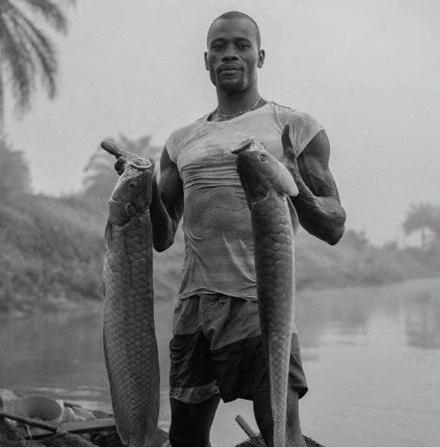
6 July, 9.45am coffee, 10.30am talk
n Bath Pavilion, North Parade Road
Historian Tony McAleavy will describe the extraordinary career of Joseph Glanvill (1636–1680) who was the rector of Bath Abbey and played a prominent role in the persecution of local women accused of witchcraft. Glanvill was a prolific writer and wrote books promoting the authenticity of witchcraft and attempting to reconcile belief in witchcraft with modern science. Admission is free for members and a donation of £2 for non-members. u3ainbath.uk
FROME FESTIVAL
7–16 July
n Various locations
During this week Frome will come alive with music, art and culture as the Frome Festival returns for its 22nd year. With over 200 events taking place across 10 days, the Festival aims to celebrate the best of Frome, with events and activities taking place in many places and spaces across the town - from venues and galleries to pubs and parks. Get the full listings and book tickets at fromefestival.co.uk
FEASTS AND FABLES
8 July, 7.30pm
n Wiltshire Music Centre, Bradford on Avon
Bath Minerva Choir presents Coleridge-Taylor's colourful and wildly popular cantata Hiawatha's Wedding Feast. Also songs from young tenor Joseph Spratt, and closing with Bob Chilcott’s attractive and entertaining Aesop’s Fables. Tickets £20/£15. wiltshiremusic.org.uk
BATH BACH CHOIR:
MENDELSSOHN'S ELIJAH
8 July, 7pm
n Bath Abbey, Bath
Mendelssohn’s much-loved oratorio Elijah narrates the biblical story of the Old Testament prophet Elijah in the form of recitatives sung by the soloists interspersed with Bath Bach Choir singing various airs and choruses. Mendelssohn was influenced by both Bach and Handel, adding his own enthusiastic and dramatic style that captures the audience’s interest from the opening to the final chorus. Baritone Matthew Brook is singing the part of Elijah. he choir will be accompanied by Southern Sinfonia, with Marcus Sealy playing organ continuo. Tickets £11–£30. bathbachchoir.org.uk



If Opera’s 2023 programme –which runs from 24 August to 16 September –brings opera back to the entrancing natural surroundings of Belcombe Court as well as to Wiltshire Music Centre in Bradford on Avon. Emma Clegg talks to Lysanne van Overbeek who is directing two productions –Alice’s Adventures in Wonderland and Iolanta –and discovers there are connections between these two out-of-this-world tales


You’ll find fantastical tales, stories of intrigue and tragedy, talking animals and a high executioner in If Opera’s summer programme this year. Lysanne van Overbeek, who is directing two of the productions –Alice’s Adventures in Wonderland with music by Will Todd and Iolanta by Pyotr Ilyich Tchaikovsky – has two very different pieces on her hands. One is an amalgamation of Lewis Carroll’s two endlessly reinvented Victorian nonsense stories, recently produced as an opera (2013), and one is a lyric opera sung in Russian in an established classical canon.
Lysanne, however, does see similiarities between the two: “In a way, Iolanta is quite similar to Alice in that both of the main characters need to gather the strength within themselves to move on in their own lives.”
Female empowerment is indeed a strong theme in both works. We know Alice from Lewis Carroll’s books as self-possessed and as a character on a challenging journey, but the narrative in Opera Holland Park’s specially commissioned version – which If Opera are using – is adapted to give a sense of Alice, rather than just her reactions to her surroundings and those she meets. “With Alice’s character it’s highlighted from the very beginning that she wants to travel; she wants to go to Honolulu and to Timbuktu. Halfway through the opera, Alice sings I Flew High in My Dreams, which leads her to find the courage to save her friends. We wanted to use this image and empowerment within that for the design and concept”, says Lysanne.
Reinventing established tropes in creative works can change the pace, emphasis and impact of a story, and is the pivotal energy behind restaging existing productions. With Alice’s Adventures in Wonderland this is perhaps especially necessary because we all take for granted the familiar image of a girl in a blue dress who meets a white rabbit and goes down a rabbit hole, and a creative reimagining provides news ways of engaging with the Wonderland story.
Lysanne explains, “The beginning of Alice is set up a little bit differently in this version. Alice arrives with her family in a pet shop and becomes entranced by a rabbit – she ends up in her own dream world and the rabbit starts talking to her. She helps the rabbit get out and then they fall down the rabbit hole.”
The characters Alice encounters form a smaller cast than are in the books, but there are all the big characters we know and love: the White Rabbit, the March Hare, the Mad Hatter, the Cheshire Cat, the Caterpillar (who sings the rumbling Wonderland blues), the Dormouse, the White Knight and the pantomime dame Queen of Hearts. “Each character has their own scene to guide Alice on her journey. The White Rabbit has an eery but exciting aria trying to explain what is actually happening in Wonderland.
“At this point the Queen of Hearts has arrived and it’s causing turmoil. This is one of my favourite moments in the opera where we also see four characters called The Victorians who are the chorus within this piece. The Victorians help us go from one scene to the next, change the set and they sing with the rabbit in this
aria. It is a beautiful piece – haunting and full of expectation and it sets up the story really well.”
It’s not a surprise to discover that this production has got something for everyone, especally a younger audience. Lysanne says, “It’s going to be colourful and the story will be easy to follow. The orchestra is central – I always notice how children love watching the orchestra as well as what’s happening on stage, so I want to involve the music and get children the opportunity to look at the music as well as the action.”
Lysanne’s approach to If Opera’s Iolanta – and all her operas, including Alice – is to connect with the narrative and focus on the story that she wants to tell. “Iolanta is about a princess who is blind but doesn’t know it and she is homed in this beautiful paradise garden where she is looked after and protected by her father until he can find a way of helping her and healing her.”
In true fairy-tale style a prince and a count arrive, the second of whom Iolanta falls in love with, and he then accidentally reveals to her what sight is. “Despite the revelatory and life-changing news, Iolanta absorbs it all and explains that she sees the world in a different way to him. She opens up his world explaining that you can be in touch with nature without seeing it. The piece has a strong ending about coming to terms with your own strength and your own life whilst connecting to nature, to the world that we live in. Kindness and care is really important in this piece and I love that.
“My favourite section is when Count Vaudemont and Iolanta have their duet together. He tries to explain about what colour is and she opens up his world by showing him how to see without seeing. It’s so beautiful because it’s not just about ‘let’s fix you’ but about how everyone’s way of viewing the world is valid, and how can we learn from each other.
“That is the beauty of fairy tales – they allow you to connect to any time period and have got a moral that we can learn from.”
Lysanne studied musical theatre but quickly shifted her career towards opera. “Ever since I was a child I knew I wanted to work in the theatre and I was particularly keen on music and musical

theatre, especially linked to old Rodgers and Hammerstein, Irving Berlin and Cole Porter, the style I loved, and this period represents the transition period from opera to musical theatre.
“I worked on one production as an actor where I was captivated by the company mindset of working with everyone together to create a piece and I realised that that was the bit that I loved, working with people and creating something together, not the standing on stage myself. So that’s when I looked at directing.”
Lysanne’s experience at If Opera has certainly captivated this thrill. “If Opera is such a lovely company to work for and it is incredibly empowering. Michael Volpe (Executive Director) and Oliver Gooch (Artistic Director) are so trusting of the people they work with and they want to help you make your creative vision happen and will support you with your ideas – and even if something is not possible they help you to find a different way.
“What I love about the experience at If Opera is working with one company for a whole summer, on a variety of productions. What’s special about this is that you get to know and trust each other so well that you get a different dynamic and spark of magic.”
These sparks of magic, which also include Umberto Giordano’s Fedora, Gilbert and Sullivan’s The Mikado and a Picnic Prom, are being performed at Belcombe Court in Bradford on Avon within its special saddlespan marquee with dates in late August and early September (“The grounds of Belcombe are just stunning – it’s part of the experience,” says Lysanne.) This is with the exception of Iolanta which is at the Wiltshire Music Centre in Bradford on Avon. See the If Opera website for the full programme details. n
Bath Box Office: 01225 463362; ifopera.com
Alice’s Adventures in Wonderland: 27 August at 1.30pm and 5pm; Iolanta: 13, 15 and 16 September at 7pm. The gardens at Belcombe Court are open for exploring and picnics before each performance of Alice’s Adventures in Wonderland

That is the beauty of fairy tales –they allow you to connect to any time period and have got a moral that we can learn fromLysanne van Overbeek Silent Noon by John Byam Shaw, used as the promotional image for Iolanta. Courtesy of Leighton House, Royal Borough of Kensington and Chelsea
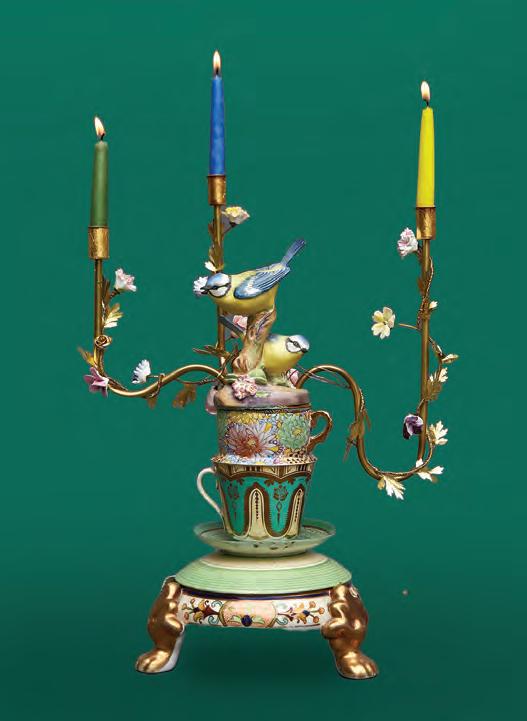
Victoria Art Gallery has taken two colourfully creative American friends and given them an exhibition. It’s not the first time they have exhibited together in Bath, with previous shows pulling in big crowds. We ask artist and textile designer Kaffe Fassett and artist and mosaicist Candace Bahouth to tell us more about their work, their collaboration and the forthcoming shows Kaffe Fassett: Timeless Themes – New Quilts and Candace Bahouth: Enchanted Visions.
Which came first, your Timeless Quilts book or the exhibition? And what was the idea behind the theme of Timeless Quilts?


The book came first. It’s been almost two years in the planning and in the making and photographing of the quilts. When I look back over our 20 odd years of quilt-making and designing fabrics, I saw that we returned over and over to certain themes – vases and baskets of flowers, and stripes both classically regular and more quirky, and organic has been a recurring theme. I felt that emphasising the various themes would be a stimulating way of helping makers to refresh their imagination with a good visual starting point.
There are 23 large new quilts in the exhibition. That sounds like a lot of work!
It is indeed a lot of work, which delights me. I never asked for an easy life and feel most alive when tackling a new project. The quilts in the exhibition cover themes including stripes, circles, geometrics, botanicals, wild paisleys and retro zig zags.
You used your archive of photographs to research the quilts you used. Are photographs your first point of inspiration as a designer?
We have an extensive archive of photos. Brandon, my partner, and I travel for about a third of each year and he photographs many of the great ideas we encounter around the world. Photos are a great inspiration and a reminder of the good ideas we spot, but we also bring home objects like ribbons, fans, beaded items and decorated china.
You are especially known for your quilting. What is it about this art form that thrills you?
I am very drawn to patchwork and quilting – mostly because it is quick to construct and very expressive of the colour passion I experience and try to communicate to my audience. I wouldn’t say it is my only or even main means of expression. I still knit a lot and find it a great therapeutic way of communicating colour ideas. I also do many needlepoint designs each year and also find mosaic is a great medium for colour and pattern.
How have the quilts in your new book been photographed?
I choose any background to photograph my quilts against that helps people to experience the colour in a juicier way. We search the world looking for colourful backgrounds to enhance our quilts. In the book it was mainly a colourful street in the East End of London and the tile panels of Rupert Spira. I hope you agree that the backgrounds help you see the colours better in the quilts.
How do the early stages of planning a quilt work?
Designing is a very organic process. Sometimes the prints lead the way. Mostly we have a colour mood to follow or a good quilt layout from a vintage quilt book. I try to keep the layouts as simple as possible and let our intricate prints do the work.
If you had to create a quilt with just one motif, what would it be?
I would say that flowers are my most returned-to theme as they carry such lush colour and beautiful forms.

In my Enchanted Visions showthere will be 10 Rococo mirrors and 15 fanciful candelabras. The recurrent theme for these pieces is ‘Moments of Poetry’. As Virginia Woof said, “Arrange whatever pieces come your way.”

My influences are instinctive and eclectic… and all around me. I absorb themall: nature, found objects, provocative art works. I just get on with the work… I don’t plan but I do collect, arrange, think and imagine, and I believe that all will evolve. And I trust my eye.It’s organic and now it’s second nature.
When I proposed the exhibition, I wanted it to reflect our passions, interests and enthusiasms.It has evolved since, but retains the essence of our inspirations.
When my son was young, we would walk to the village stream and find and collect blue and white shards of china. We covered an outside windowsill with the fragments, because that was as high as my son could reach … (he’s now 6ft 6in). A Moorcroft director saw the windowsill and commissioned me to do a mosaic picture of the Stoke-on-Trent factory with wine bottle chimneys using old Moorcroft shards.It was serendipity…as was meeting Kaffe.
I don’t pay much attention to current trends – I work in my own world. But I delight seeing what other artists are creating. Especially with ‘rubbish’, like Nick Cave and Philippa Barlow. I delight in transforming discarded ceramics into something playful, works that create and bring joy. I create freely and only please myself!
When I work with others on a commissionit propels me in another direction –such as with an exhibition like this one.
ABOVE: Bloomers Quilt, a celebration of the flowers of every scale in Kaffe’s prints
CB: Kaffe and I met decades ago, and our work continually overlaps with needlepoints, mosaic and sophisticated colour. We complement each other and share essential elements… We travel the same road.
CB: We met through Hugh Ehrman, the King of Needlepoint. The connections between Kaffe and I seem endless –we are both American, positive personalities, we love beauty in all its forms – flowers, rugs, faces – and are both fans of outsider art.
CB: Kaffe has such an optimistic approach. With a bold sense of colour and pattern he taps into the long tradition of old world crafts, knitting and quilts, and he speaks eloquently and powerfully to his audience.
KF: Many people come visit my studio but few actually ‘see’ what I’m trying to achieve. About 20 years ago Candace visited and I had the unique experience of watching someone who really got what Brandon and I were trying to do in our work. When I visited her in her treasure trove of a studio house, I knew she was a kindred spirit. We did a book together after she taught me how to mosaic.
KF: I’d like anyone who comes to our show to feel inspired to create their own flight of fancy after seeing how exciting the very doable crafts of mosaic and patchwork can be, and how gorgeously expressive. n
See Kaffe Fassett: Timeless Themes – New Quilts and Candace Bahouth: Enchanted Visions at Victoria Art Gallery from 1 July –1 October. victoriagal.org.uk
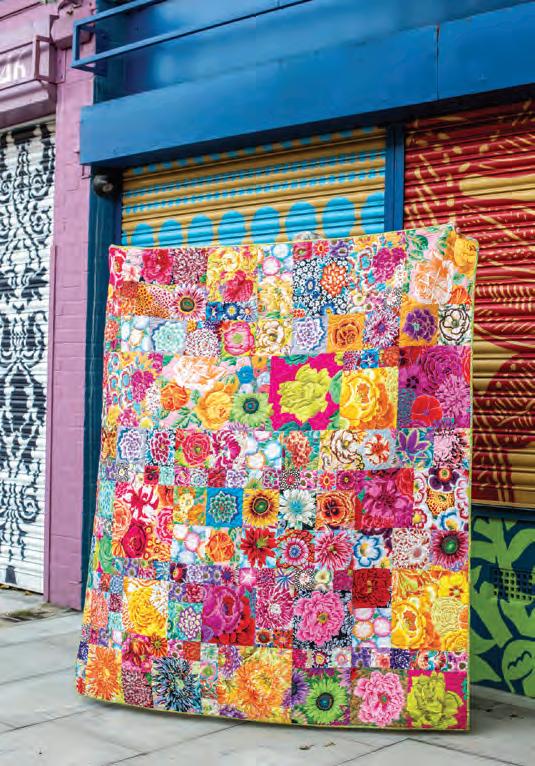

Antiques have long been associated with an older generation, evoking images of dusty, outdated objects that hold sentimental value for the elderly. However, in recent years, there has been a notable shift in the perception of antiques among young people. Contrary to popular belief, many under 40s come to our shop ready to invest in quality pieces even if they are still renting their homes. One of them said, “Cheap furniture is no longer cheap if you have to replace them every couple of years.”
One of the main reasons young people are embracing antiques is their desire for individuality. In an era of massproduced goods and fast fashion, owning something with a rich history and character makes their living space feel unique. Antiques offer a sense of exclusivity and authenticity that cannot be replicated by modern items.
Moreover, antiques are green! They serve as a sustainable alternative to the disposable culture that dominates today's society. With growing environmental concerns, many young people are actively seeking ways to reduce their carbon footprint. By purchasing and using antiques, they contribute to recycling and repurposing existing items instead of supporting the production of new ones.
Furthermore, antiques can be a source of inspiration and nostalgia. Young people often look to the past for ideas and inspiration in fashion, design, and art. By incorporating antiques into their living spaces or personal style, they create a unique blend of old and new that reflects their taste and personality.
The rise of online marketplaces and social media platforms has also made antiques more accessible and appealing to young people. They can easily discover and explore a wide range of antique items from around the world. Furthermore, social media influencers integrate antiques into contemporary lifestyles, inspiring young individuals to do the same.
It’s good to know that young people are increasingly attracted to antiques. In my observation, the popularity of antiques among young people is likely to continue to grow. I look forward to seeing the beauty of the past live on for many generations to come. n
beaunashbath.com; info@beaunashbath.com; 01225 334234 @beaunashbath

Beth
Beaux Arts is exhibiting two of its most eagerly anticipated artists as it brings together sculptor Beth Carter and painter Bobbie Russon with ceramics by Paul Wearing. West country artist Beth Carter exhibits her work worldwide, with galleries in New York, Brussels, Paris and soon the Louvre in northern France. There is always a buzz around Beth’s minotaurs and assorted dream-like shape-shifters.

Bobbie’s show ‘Quiet Comfort’ speaks to the solitary and quiet place in the soul. Her paintings are humorous and joyful, the subjects caught between childhood needs and adult mores, sometimes appearing vulnerable, at other times mischievous and in total control. beauxartsbath.co.uk
Maxine Foster at sandrahiggins.art
Sandra Higgins Art is pleased to exhibit Graffiti Ice Cream, a series of unique prints inspired by Bristol Harbourside. Maxine Foster’s joyful montypes scream hot summers’ days: blue skies, twinkling water and melting ice-cream.
Visit Sandra Higgins’ online gallery to see more or email to view, in person, by appointment.

sandrahiggins.art; sandra@sandrahiggins.com
Jonathan has been on his travels, painting the landscape in locations including Bath, New York, Amsterdam, Lyme Regis, Branscombe and his hometown of Bradford on Avon.

Jonathan’s show includes city paintings, a new subject for him. The qualities of the paintings are the result of his penetrative vision and an understanding of picture making. His paintings demonstrate his obsession with the qualities of light which forms a strong link across a broad repertoire.
The West Barn is adjacent to the 14th-century Tithe Barn in Barton Farm Country Park.
Instagram: @mulvaneyjonathan
Widcombe Art Trail, 17–18 June, 10.30am–5pm
Various locations in Widcombe
The Widcombe Art trail, which has been running since 2007, is an opportunity to meet local artists and talk about their work. There’s an impressive range of media, including painting, printmaking, drawing, illustration, photography, jewellery, ceramics, glasswork, textiles and graphic and digital art. Entry is free and most of the work is offered for sale at affordable prices. The trail includes private homes and studios and larger locations such as the Natural Theatre Company on Widcombe Hill and the Widcombe Baptist Church. Refreshments available. The suggested (walkable) route of the trail is available on the website: widcombearttrail.com
England to Savannah: Exhibition of New Watercolours by Moish Sokal
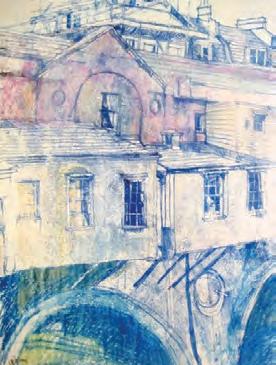

3 June –22 July, Tuesday to Saturday, 10am–5pm
Malthouse Gallery, East Lambrook Manor Gardens, Silver Street, East Lambrook
Artist Moish Sokal has just returned from his painting adventure safari trips to the wildlife parks of Tanzania and Kenya. His trip took in the Tarangire National Park, the huge crater of extinct volcano Ngorongoro and a coffee plantation in the foothills of Mt Kilimanjaro. As well as paintings made on his travels there are also paintings of more local scenes in the UK. Entry to the exhibition is free and you can visit without paying to see the gardens.


Spring Exhibition
Gallery Nine, 9B Margaret's Buildings, Bath, until 31 June
Gallery Nine’s Spring Exhibition welcomes ceramics by Justine Allison and new jewellery by Susie Hines and Zsuzsi Morrison, and a mixed print show including works by Jonathan Gibbs, Phil Greenwood, Paul Cleden, and Merlyn Chesterman.
galleryninebath.com
Bath Contemporary Artists’ Fair, Sunday 11 June, 10am–5pm Green Park Station, Green Park Road, Bath
The award-winning monthly Bath Contemporary Artists’ Fair (BCAF) is back on Sunday 11 June. Committed to bringing the best of contemporary art from the city and beyond to the heart of Bath, the fair has created a regular space where artists can network, share ideas, connect with the public, and where the public can connect with art. Visitors can browse the works of local artists and admire fine art, photography, sculpture, textiles, ceramics and much more, all under the vaulted glass roof of Green Park Station. For updates and exhibiting artists visit the website: bcaf.co.uk
Styled by Design: Modern Masters including Pablo Picasso, Henry Moore, Elisabeth Frink and Sonia Delaunay, until 30 June David Simon Contemporary, 37 High Street, Castle Cary BA7 7AW

Gray M.C.A presents an outstanding exhibition of framed 20th-century Modernist textiles that brings together a collection of rare and limited-edition works by significant and renowned artists including Pablo Picasso, Alexander Calder, Henry Moore, Barbara Hepworth
and Patrick Heron. In response to the collection, David Simon Contemporary has curated an exhibition of original artworks and multiples by many of these 20th-century masters, creating a fascinating survey exhibition, which explores the artists’ journeys from the easel and the translation into textile. Highlights include a significant and rare linocut by Pablo Picasso, Peintre Dessinant et Modéle Nu au Chapeau, created in 1965; and John Piper’s stunning screen print commissions for both Arthur Sanderson and David Whitehead.
Open Monday –Saturday (except Wednesday), 10am–5.30pm.
davidsimoncontemporary.com
POUR ROBIE, original etchingby Pablo Picasso, 1950

Colours of Summer
Paintings by Mary Liddell
22 June –22 July, 12pm–5pm
44AD Gallery, Abbey Street, Bath
Colours of Summer is an exhibition of recent oil and watercolour paintings by Bath artist, Mary Liddell, with a vibrant and colourful selection of still lifes, landscapes and portraits on display.

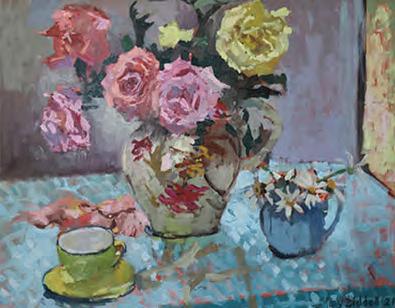
"I grew up on a farm in Southern England and now live and paint near Bath in the beautiful Chew Valley. My artistic journey is an exploration in colour and tone; a consideration of the effects of light on flowers, familiar objects in still lifes and garden pictures, and the shifting light of skies and seas in landscapes. I frequently like to work en plein air in the landscape.”
maryliddellartist.com
Queens and Monsters: Paintings and Sculptures by Ray Wirick
13 May –13 June, Tues-Sat 10am–4pm Lansdown Stores, Lansdown Road, Bath BA1 5EE
Ray Wirick is an American-born artist now working from his Marshfield studio near Bath. Ray’s work has been exhibited and collected extensively in the US, Berlin, London and Hong Kong. His work deals primarily with the human form, both physical and allegorical. In his studio Ray investigates his relationship with worlds both real and imagined, sacred and profane. Often, the human form is dissected, deconstructed and manipulated while investigating its purpose. It is then re-assembled, specific to a new environment and telling a new story. raywirick.com

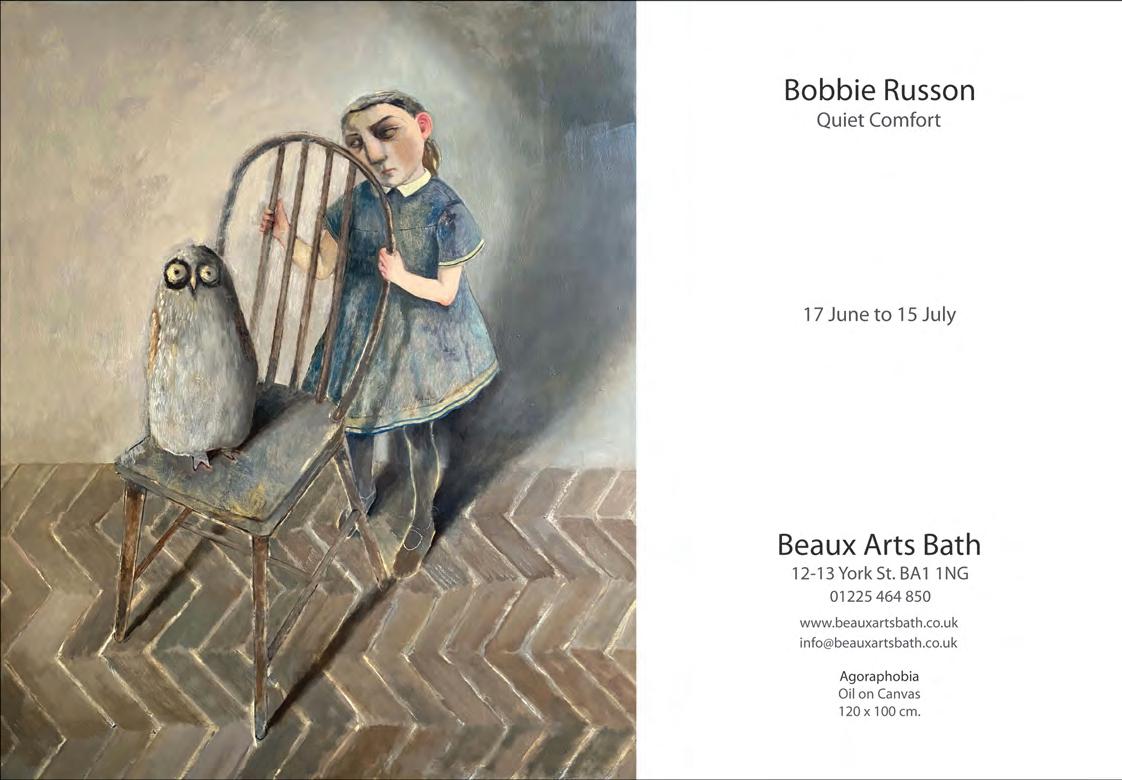


Bath Society of Artists 118th Annual Exhibition, until 24 June
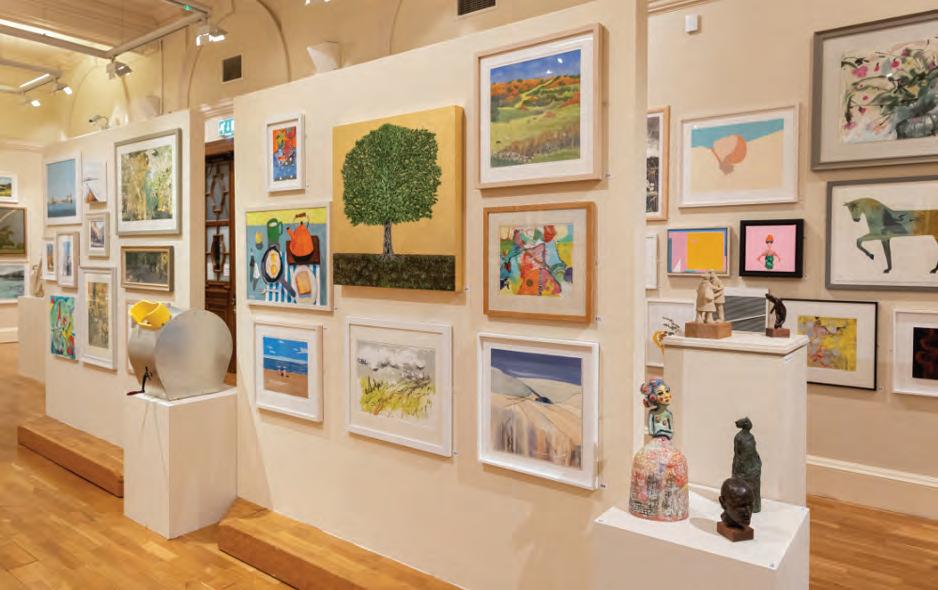
Victoria Art Gallery, Bridge Street, Bath
This exhibition showcases the best of the region’s artistic talent through many different forms, including paintings, drawings, prints and sculpture. Many distinguished 20th-century painters have exhibited with the Society in the past, including Walter Sickert, Mary Fedden and Howard Hodgkin. Whatever your taste, you are sure to find something among the 400 or so works on display to delight and intrigue.
victoriagal.org.uk
The Holburne Museum, Great Pulteney Street, Bath
Painted Love: Renaissance Marriage Portraits, until 1 October
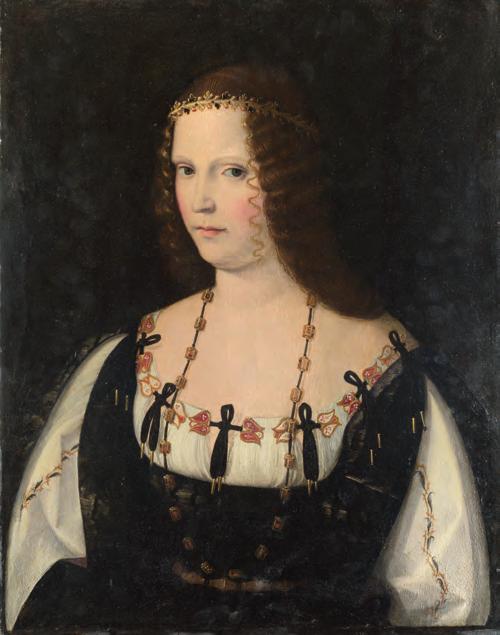
This lavish exhibition explores the role of portraiture in the process of marriage in Renaissance Europe. Marriage portraits not only documented the legal union of spouses, capturing that key moment in the sitters’ lives, intimate and personal as well as public and formal, but also celebrated the union of families, their wealth, power, land, and the forging of political alliances.

Painted Love: Renaissance Marriage Portraits will explore the way marriage portraiture reflected the complex politics of 15th- and 16th-century Europe. Wedlock was often the culmination of years of negotiations, with portraits of eligible women and men being in demand and circulated from an early age. The show will also consider the combination between idealism and realism in one
likeness. In addition to paintings, the exhibition includes objects associated with the rituals of marriage: love tokens, rings, gifts and commemorative tableware. The exhibition includes prestigious loans from the National Gallery, the British Museum, the Royal Collection Trust, the Ashmolean and the V&A, alongside numerous works from important private collections.
Michael Simpson: Drawing towards painting – selected works on paper, until 17 September
Winner of the prestigious John Moores Painting Prize, this exhibition from Michael Simpson is the first to focus exclusively on the artist’s work on paper, exploring his approach to drawing as a route to what a painting might be.
holburne.org

I’d like to ask how you started in the auction world?
I read History of Art at the University of St Andrews and graduated in 1986, determined that I wanted a job somewhere in the auction world. Lo and behold, the art market was booming and auction houses were recruiting keenly so, for once, my timing was perfect. I walked through snow on January 5th 1987 to begin my first job as a trainee picture specialist at Sothebys saleroom in Chester. I have never had a dull day’s work since then. Who are Lawrences?
We are Fine Art Auctioneers and Valuers, based in Crewkerne in Somerset and with a team at Westbury in Wiltshire. Since last autumn, we are part of the pan-European network of salerooms run by Auctionet. In Crewkerne and in Westbury, we have specialist departments and valuers with over 350 years of combined experience in this endlessly fascinating, fascinatingly endless business of valuing and auctioning anything from pearls to pistols. We have sold lots for over £350,000 but prices start at just £25 in our online auctions and we offer a personal, professional service across the West Country and far beyond.

What is it really like up on the podium?
Auctions are our principal business and so the successful, accurate transaction of any item is our principal endeavour. The rostrum is the focal point at which most of our lots are tested for their appeal; there really is an adrenaline rush when interest in a lot gathers momentum. The excitement of testing bidders’ determination from the rostrum is a thrill that never diminishes and, of course, we are always ready for an unexpected surprise when two bidders ‘lock horns’. With numerous dealers and collectors in the room, on telephones and bidding live via a number of auction platforms online, we draw in buyers from all around the world. Although we still have these traditional rostrum auctions with an auctioneer, our timed online sales are entirely orientated towards the collector on the internet, but all our auctions can be viewed in person.
What is popular right now/What is a modern antique?
Jewellery, especially good diamonds, and gold is very popular. Modern design – in silver, ceramic, bronze, glass or furniture – catches collectors’ eyes. 20th Century pictures and prints, rare first editions and toys in exceptional condition can command very strong prices. As a picture specialist, I foresee sustained growth for scarcer, fine quality post-War artists’ pictures and prints.
Advice for someone who never been to an Auction?
Examine the item to your satisfaction before you bid (if you cannot get to the viewing itself, we can assess it for you and answer all your concerns with additional photos etc). Ask us questions so that you are better informed. Set yourself a limit and, if you can justify it, pledge not to exceed it by more than 10%. If you plan to start a collection, view a lot of auctions before you buy a single thing in order to better gauge the market and where its strengths lie. Focus upon the sort of lots that you can live with so that, should they not rise in value, you still have items that you can treasure. A profit may be a bonus but the most important thing is to enjoy buying at auction - and it can be an addictive passion once you start. Until you start browsing you will never know where your real interests may lie. I’ve even heard of a man who collects rare and unusual gas cookers.
Where I can find out what’s up for auction etc?
See our website – www.lawrences.co.uk – for details of our past sales, our current sales and our future sales. Email or phone us if you have questions - we love to welcome new collectors of any age to Lawrences.
FREE Valuations are available with specialists at the Crewkerne and Wessex salerooms. Also available Online | Email | WhatsApp
Home visits are also available without charge or obligation.
Entries are invited for our Summer auctions to include:
Silver | Vertu | Pictures | 19th/20th Century Design | Ceramics
Oriental Works of Art | Jewellery | Watches | Furniture | Clocks | Rugs
Militaria | Coins | Medals | Collectors | Sporting | Textiles | Wine | Spirits
Books | Maps | Manuscripts | Photography
South Street, Crewkerne, Somerset TA18 8AB. T: 01460 73041 E: enquiries@lawrences.co.uk
What is it? A soft, fresh Italian cheese typical of the Puglia region of southern Italy; expect to encounter a cricket-ball sized shell/pouch of buffalo mozzarella wrapped around a luxurious, oozing mixture of cheese curds and cream.
What does it taste like? Mild, soft and rich in decadent buttery overtones (burro is the Italian word for butter), with just the right amount of cheesy sourness to balance the creamy load.
Nutritional know-how: High in fat and calories, Burrata is not an everyday cheese. It is, however, high in protein and calcium, and the mozzarella casing is laden with probiotics. How should I use it?
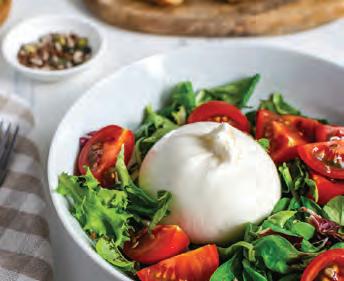
Burrata is delicious simply drizzled with a little balsamic vinegar and served with Italian charcuterie, Italian bread and Italian olives as part of an antipasti selection. Or, try it on bruschetta, topped with a smattering of pesto and a sprinkling of pine nuts. It also works really well served on a bed of lightly dressed salad.
Omar Allibhoy’s new book on Paella –The Original One-Pan Dish: Over 50 Recipes for the Spanish Classic has recently hit the bookshops. The book by the Spanish chef and Tapas Revolution founder has over 50 recipes and these include the classic chicken and rabbit variation of Paella Valenciana, Arroz de Carrilleras (beef cheek, carrot and chickpea paella), Arroz de salmonete y calamar (red mullet and squid paella) and Arroz de tupinambo, setas y castañas (wild mushroom, Jerusalem artichoke and chestnut paella). Best of all, you discover that paella is a one-pan wonder, and it’s simple to cook and very affordable because the bulk of the dish consists of humble rice.
Paella by Omar Allibhoy, Quadrille, £18
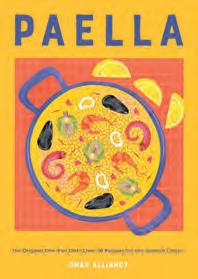
Black pepper is native to the Malabar Coast of India (present day Kerala). A single cargo ship in the 2nd century would pay the annual salary of around 7000 soldiers to bring back black pepper from India to Europe. It had nutritional properties and was used as a cure for many ailments. So popular was pepper that it was referred to as ‘black gold’ and ‘king of spices.’
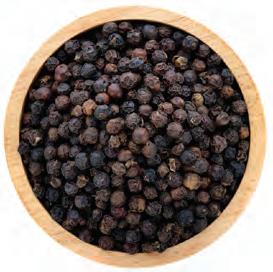
Rosa’s Thai Cafe, which has recently opened in Bath on Cheap Street, has brought out a new cookery book, Rosa’s Thai Cafe: The Vegetarian Cookbook written by the company’s founder Saiphin Moore. The book includes over 100 recipes for vegetarian Thai dishes, from Pad Thai and Jungle Curry to Coconut Soup and Tofu Satay with Peanut Sauce. Using fresh, healthy ingredients, many of the dishes come together in a matter of minutes, making them perfect for a quick and satisfying weeknight meal – and many can easily be made vegan. And if you’re not sure which dishes to pair together, follow the menu planners to make a feast to share with family and friends.
Rosa’s Thai Cafe: The Vegetarian Cookbook by Saiphin Moore, Octopus Books, £20


Vegetarian; serves 2
recipe by Saiphin Moore
Amazingly quick to make, this soup is fantastic on a cold winter’s night, not that we ever have those in Thailand. This recipe is based on a coconut soup my auntie, who had a lot of coconut trees on her property, taught me to cook. The galangal adds a unique flavour to this satisfying soup, which should be salty and sour, with just enough heat to make you feel warm inside.
200ml (7fl oz) coconut milk
200ml (7fl oz) water
1 lemongrass stalk, sliced diagonally

5 slices of galangal
3 red bird’s eye chillies, sliced
1 teaspoon sea salt flakes
4 coriander roots (or stalks)
3 lime leaves

150g (5oz) oyster mushrooms, broken into pieces
2 tablespoons light soy sauce
3 tablespoons lime juice
5 cherry tomatoes, halved handful fresh coriander leaves
Method
1 In a small pan, bring the coconut milk and water to the boil. Add the galangal, lemongrass, lime leaves, chillies, coriander root or stalks and salt.
2 Leave to bubble away over a medium heat for 2 minutes, then add the mushrooms, lime juice and soy sauce while stirring constantly. Cook for a further two minutes, then stir in the coriander leaves and tomatoes.
3 Remove from the heat and serve immediately.

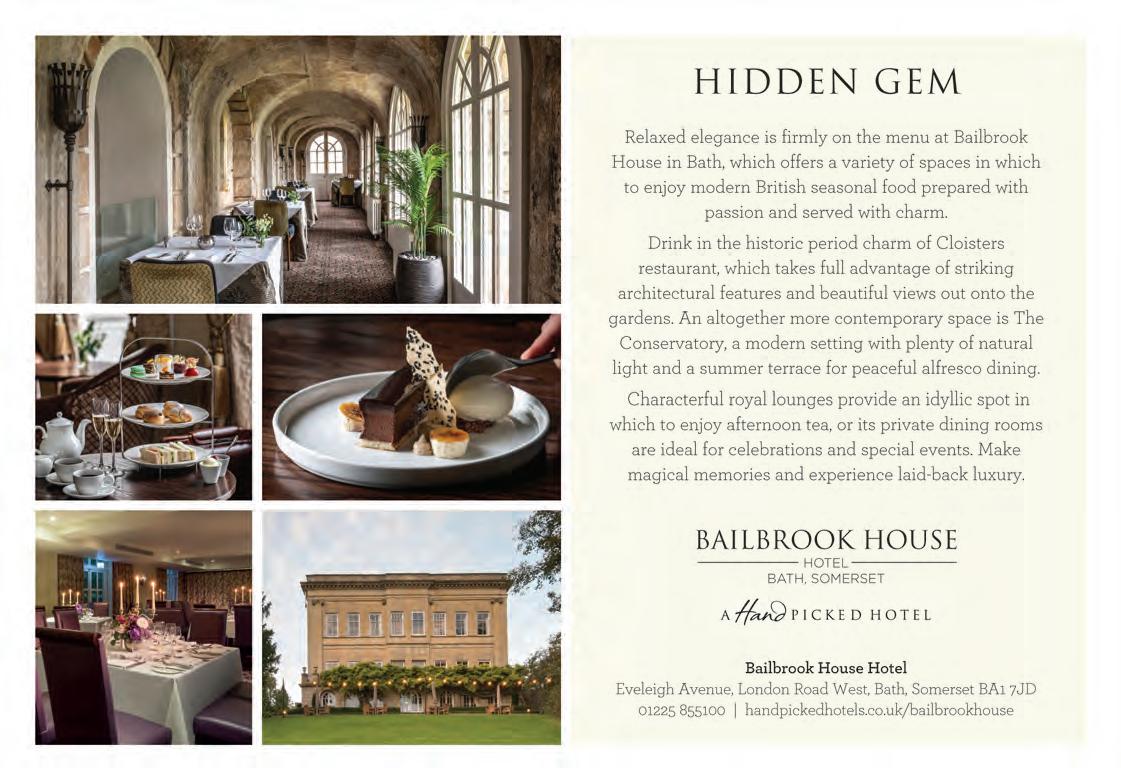
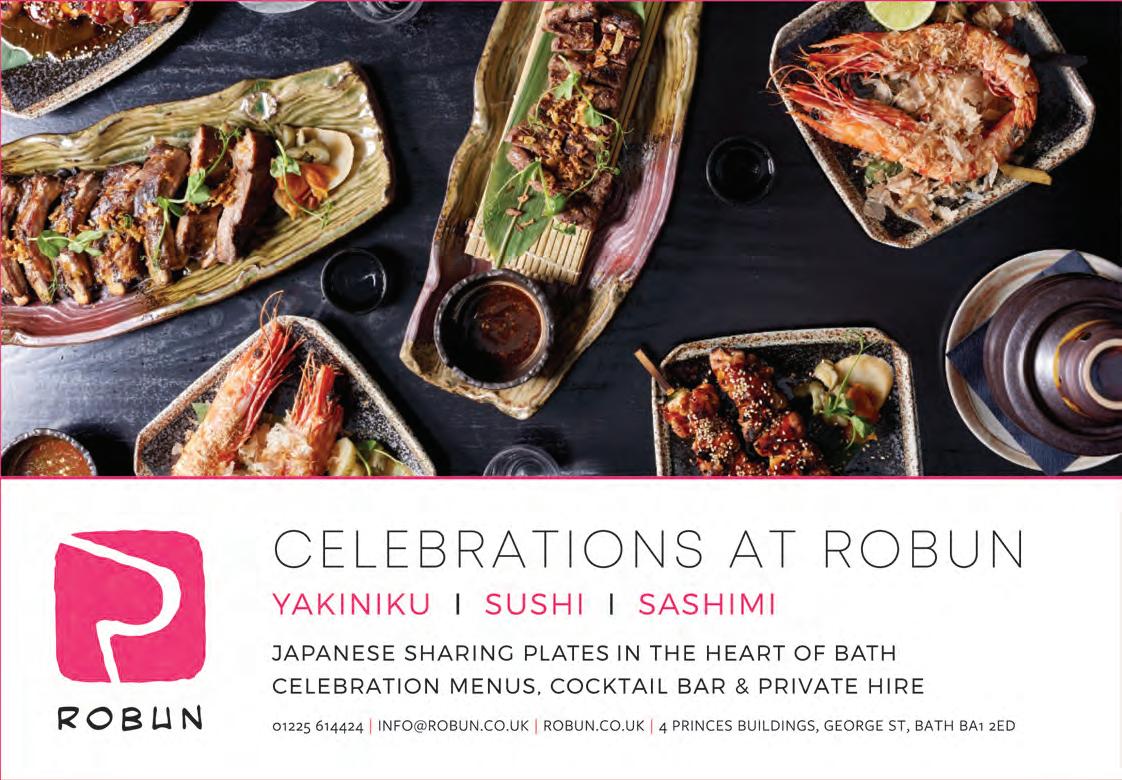



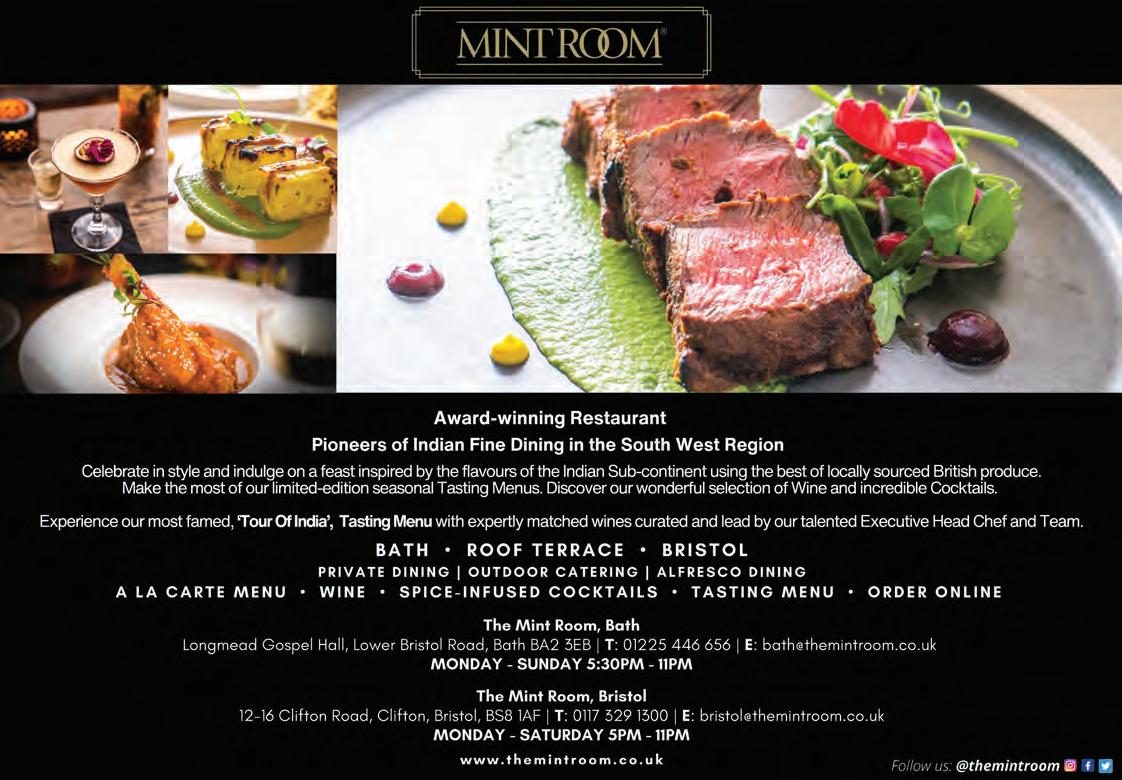
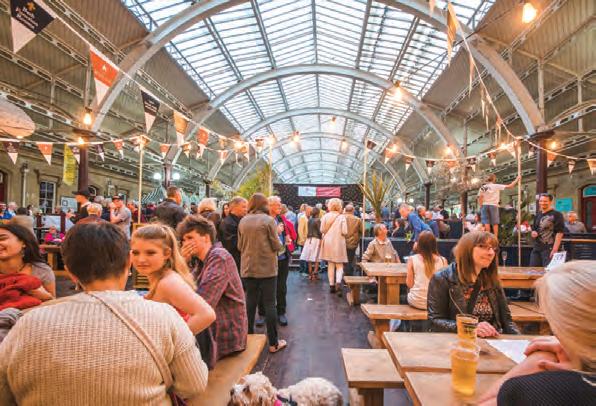
It’s the first delicious part (continued in July) of our list of local food superstars covering every possible experience – from time-saving tasty take-outs and wholesome food to prepare at home; to restaurants and cafés where you can revel in seasonal dishes, order a special bottle for a celebration and share good times with friends and family. From Chinese, Thai and Japanese to French, Italian and British gastro – and plenty of options for vegan, veggie and gluten-free – you’ll find a host of national cuisines, and all manner of food from burgers and pizza to small plates to share and award-winning gastronomy.
There are some superb haunts here – those we love to return to again and again – as well as a fresh tranche of new businesses offering amazing vision and foodie adventures.

As well as individual listings, you’ll also find a selection of food news and zazzy little editorial snippets with a food agenda – as usual, it’s clear that there’s a dazzling array of food knowledge in our city – read on to find out more…















Green Park Station, Bath BA1 1JB
Tel: 01225 588886 Web: bathpizzaco.com




Bath’s favourite pizzeria landed the 2nd place spot at the National Pizza Awards in 2022, cementing their status as one of the city’s most popular eateries. Home to the good times with incredible pizza (freshly made in front of you), fizz, cocktails and craft beer, Bath Pizza Co is set in the funky historic setting of the old Green Park Station – where the last train left in 1966. Don’t miss out on soaking up the atmosphere on the terraces all year round, which are perfect for kicking back and watching the world go by, with cosy heaters for the cooler months. The menu includes classics and also offers great flexibility with a popular ‘make it yours’ option where you can create your own pizza with the pizzeria’s outstanding ingredients. Don’t miss out on their weekly Specials which are inspired by their talented team. Vegan, vegetarian and gluten-free options also form a core part of the menu. Take away is available through click and collect.


6 Green Park Station, Bath BA1 1JB Tel: 01225 338565 Web: greenparkbrasserie.com
A must-visit restaurant with live jazz/funk/soul/swing four nights a week, Green Park Brasserie showcases locally sourced produce and is home to a buzzing atmosphere, filled with locals and visitors to Bath. This is one of Bath’s best restaurants and one not to be missed. Fiercely independent since 1992 and known for their local steaks, Green Park Brasserie sits in the historic booking hall of the old Green Park Station and featured in the Sunday Times’ ‘Sexiest Restaurants in the UK’ 2021 as well as picking up recommendations from The Guardian and Rough Guides. With Two for £12 cocktails from 12–5pm every day the sunlit terraces are perfect for people-watching and soaking up a few drinks. Book a table for indoor dining and live music or just rock up for a more casual bite to eat and drink on the terraces (no booking).

the
7 St James’s Parade, Bath BA1 1UL Tel: 01225 552582 Web: noyaskitchen.co.uk

Noya’s Kitchen serves up delicious Vietnamese home cooking in a stylish and beautiful Grade II listed building in central Bath. Voted one of the UK’s Top 5 Independent Restaurants by Gousto in 2021, and judged Bath’s Best Restaurant in 2022, advance bookings at weekends are essential! Vietnamese food lovers can enjoy delicious dishes like Pho, Vietnamese curries and summer rolls on Tuesday–Saturday from 12–3pm, and Wed, Thurs and Sat evenings from 6–9pm. There’s always something new and delicious on the Specials board in the restaurant, or tune in to the social feed for Noya’s Kitchen to hear about them. The menu changes regularly depending on locally sourced ingredients, the weather and Noya’s inspiration. Book online, or call in. You’ll be warmly welcomed and the garden is lovely on a sunny day.
Hunstrete House, Hunstrete, Pensford, Bath BS39 4NS Tel: 01761 490490 Web: thepighotel.com
THE PIG-near Bath is a buzzing restaurant with rooms – with the Kitchen Garden at its heart – nestled between Bath and Bristol on the edge of the village of Hunstrete. With a serious commitment to the community and surrounding area, THE PIG-near Bath celebrates all things Somerset. The food is driven by home grown clarity of flavour, true to the seasons and influenced by location. The Garden and Kitchen teams work hand-in-hand to create the restaurant’s 25 mile menu, which is supported by passionate local farmers and small producers, who supply anything that the team cannot grow or produce themselves. This commitment not only supports their local suppliers, but means they can be 100% honest on the provenance of their ingredients.

My favourite ingredient to use on my menu at the moment is Pembrokeshire crab, from Littlehaven. It is caught by an amazing fisherman from a small boat off the stunning Pembrokeshire coast where I spend a lot of time with my family. I just love the flavour and quality of the crab –it is the most superior crab meat I have ever used. We serve it with a sauce made from the crab shell and let the flavours speak for themselves.

 ROB CLAYTON, CLAYTON’S KITCHEN
ROB CLAYTON, CLAYTON’S KITCHEN
34 Brock Street, Bath BA1 2LN Tel: 01225 466020 Web: thecircusrestaurant.co.uk
A small, very busy, muchadmired family-run business, The Circus Restaurant is one of Bath’s sparkling culinary gems, serving seasonal, locally sourced, freshly cooked English food. It has a carefully chosen wine list, and exceptionally welcoming staff. Set in a fine Georgian house –between The Circus and the Royal Crescent –you will find sensible and honest prices, and you’ll leave wanting to return some time soon. Voted number four in the UK in The Times’ 20 Secret Restaurants That Foodies Love. Open Monday to Saturday, 10am to midnight (closed Sunday). Booking is advised.
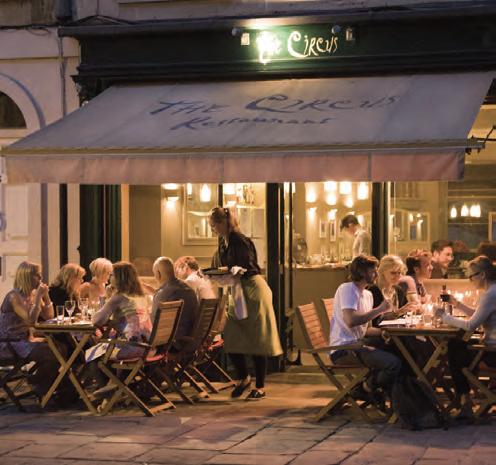
15 Argyle Street, Bath BA2 4BQ
Tel: 01225 463482 Web: chezdominique.co.uk
Ever popular, Chez Dominique is a family-run restaurant serving local and seasonal French and European food. Included in the latest Good Food Guide, it has been granted a certificate of achievement from Hardens for its highquality food. This cosy, casual bistro is ideally located on the beautiful Argyle Street just over Pulteney Bridge, and the private dining room –comfortably seating eight –overlooks Pulteney Weir. Chez Dominique offers a prix fixe menu at lunchtime, an à la carte dining in the evenings, and there’s also a very carefully chosen wine list. Bookings - lunch: Monday to Saturday 12-3pm, Sunday 12-3.30pm. Evenings: Sunday to Thursday 5-9pm, Friday & Saturday
5-9.30pm Enjoy great food and drink in a relaxing and friendly atmosphere.
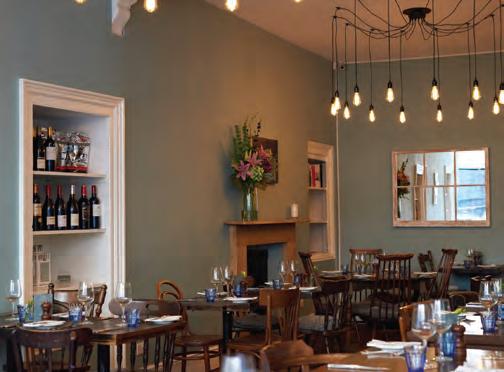
1–2 New Street, Kingsmead Square, Bath BA1 2AF Tel: 01225 466377 Web: pekingrestaurantbath.co.uk

Since opening in 1985, this family-run, independent restaurant is the number-one choice for local, authentic Chinese food. The master chef has created an extensive menu of fresh, healthy and innovative dishes selected from Cantonese, Szechuan and Peking cuisines, using local ingredients wherever possible. As well as the traditional flavours of sweet and sour, ginger and spring onion, Peking also offers much-loved lobster and crab dishes. The chef also prepares special dishes on request. The friendly, skilled staff at Peking strive to provide a genuine Chinese experience with a promise to put their hearts and souls into everything they do.
4 Princes Buildings, George Street, Bath BA1 2ED Tel: 01225 614424 Web: robun.co.uk
Robun is a celebration of authentic Japanese food and drink, specialising in a modern take on Yakiniku – the art of grilling meat, seafood and vegetables over a traditional charcoal fire.

The menu features a range of meticulously crafted dishes using only the freshest and finest ingredients. From delicate sashimi and perfectly grilled wagyu beef, to artisanal sushi rolls and exquisitely presented small plates, each dish is a work of art that showcases the skill and creativity of Robun’s talented chefs. To accompany your meal, there’s an extensive selection of premium sake, Japanese whiskey, and cocktails, handpicked to complement the cuisine. For something special, Robun’s Afternoon Tea swaps sandwiches for sushi and scones for bao buns. This beautifully presented Afternoon Tea features some of the standout dishes from Robun’s menu. Upstairs at Robun, a private dining room and bar is set to host celebrations, events and meetings. The space can accommodate 40 seated or 50 standing guests, with set menus available for parties of eight or more. Set in the heart of Bath, Robun offers an informal yet refined environment to share freshly prepared sharing plates and pairings.
Many of Bath’s best restaurants offer pre-theatre supper deals, and early bird set menu bargains abound between 5.30–7pm, including elegant Bath institution Woods, the brilliant Chez Dominique, Dough Pizza (which has dough choices including turmeric, hemp and seaweed) and not forgetting the tempting gastro menu at Green Park Brasserie, housed in the restored train station ticket hall.

29 Milsom Place, Bath, BA1 1BZ Tel: 01225 984834 Web: thegaffrestaurant.co.uk/bath
The Gaff is an independent restaurant based in Milsom Place, Bath, just off Broad Street. It specialises in carefully crafted small plates using the best quality ingredients. The restaurant offers a friendly and relaxed atmosphere whether it be at the Chef’s table enjoying a specially designed tasting menu, in the restaurant sharing dishes from the A la Carte Menu or at the bar enjoying inventive cocktails and snacks.The Gaff’s owners, Dan and Dan's Michelin Star background and experience shines through in their execution and attention to detail.
5 Chapel Row, Bath BA1 1HN Tel: 01225 423417 Web: corkagebath.com
The lavish Georgian wake-up calls so beloved of Jane Austen still impact on life in Bath today.
Breakfast and brunch are big; from almond croissants, healthy yogurt/fruit compote/granola combos, and bacon butties to eggs Royale, Florentine and Benedict, shakshuka, passionfruit pancakes and prosecco. Try the Ivy for traditional, Boho Marche for a super shakshuka, or Bandook’s bottomless brunch with freeflowing Prosecco at weekends... Yes!


Corkage is an award-winning independent restaurant, bar and bottle shop in central Bath. Think creatively cooked, locally sourced seasonal plates and daily specials, with a broad range of exquisite wines from around the world, by the glass and bottle. You can sip crisp English fizz in the garden with a plate of pasta or day boat fish, or go for a multi-course experience, featuring the likes of charred asparagus with hummus and dukkah, confit duck with freekeh, panelle & fennel salad and burnt Basque cheesecake with poached strawberries. With a beautiful heated, covered terrace and secret courtyard garden, it’s one of those special places that manages to transport you to sunnier climes, year-round.

15a George Street, Bath BA1 2EN Tel: 01225 724386 Web: claytonskitchen.com
Clayton’s Kitchen is a firm favourite with locals and a must for visitors to Bath seeking a wonderful culinary experience. This charming, relaxed and stylish restaurant is led by chef-patron Robert Clayton, who has achieved two Michelin Stars while running retaurants in Bath. Inspired by Mediterranean and modern French cuisine, Robert creates uncomplicated but sublime dishes; prepared, cooked and perfectly presented using the freshest, highest quality ingredients. To reflect this, the beautifully compiled menu changes seasonally and is accompanied by an excellent wine list. Enjoy a fantastic lunch or dinner –you’ll want to return.
Open Wednesday to Sunday. Weds–Thurs: 12–2.30pm and 6–9.30pm. Fri–Sat: 12–2.30pm and 5.30–10pm. Sun: 12–3pm and 5.30–9pm.
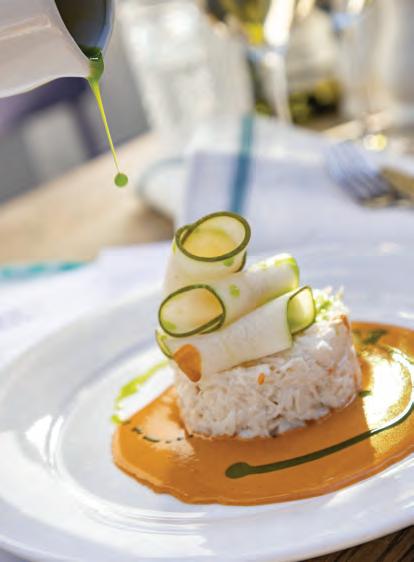
Church Street, Lacock SN15 2LB Tel: 01249 730230 Web: signoftheangel.co.uk
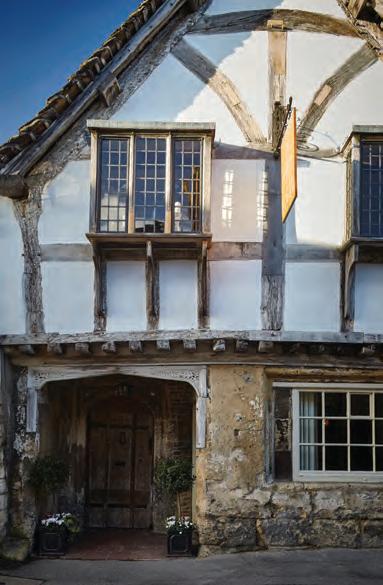
Sign of the Angel is a 15th-century coaching inn that encompasses the key elements of a traditional inn. It provides great tasting food and drink in front of large open fires with warm, homely rooms for those staying overnight. Located in the National Trust village of Lacock, on the edge of the Cotswolds, this superb pub is only a short distance from Bath. The kitchen uses fresh, seasonal ingredients in order to serve stand-out dishes from honest foods. Sign of the Angel sources produce from local suppliers in the west country to ensure that the food process is traceable, and from sustainable farmers, growers and butchers. In the summer months, there is a beautiful garden where you can enjoy a cream tea next to the stream, along with a paddock, which helps subsidise the produce for the kitchen. Sign of the Angel has received two AA rosettes and is considered a 4* AA accommodation.
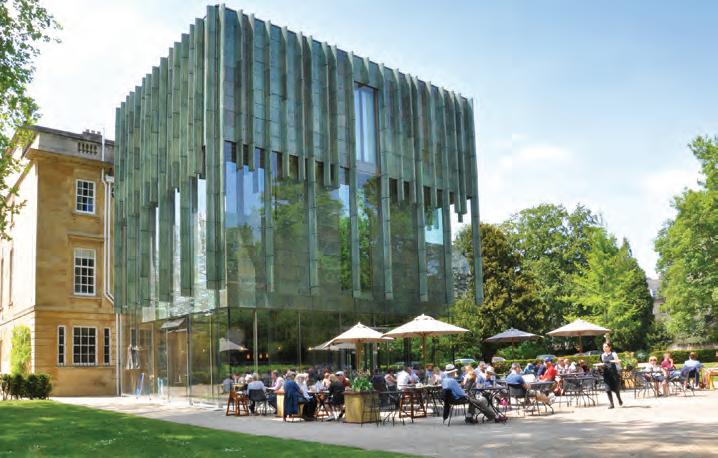
The Holburne Museum, Great Pulteney Street, Bath, BA2 4DB Tel: 01225 388572 Web: holburne.org
Set within the grounds of the Holburne museum you will find the Holburne Café. The menu has a focus on both seasonal British ingredients as well as using produce from local suppliers, reducing both their food miles and making the most of what Bath and the surrounding area has to offer. The menu includes house made sandwiches using sourdough from Bertinet bakery, beautiful hand-crafted patisserie , and amazing local ice cream from Marshfield Farm ice cream, using fresh milk from their own herd that’s transformed into delicious ice cream. Look out for a brand new look in the Café this summer, when they will also be launching Bridgerton inspired afternoon teas for visitors.

Serves 2
These are just awesome. give em a go!
YOU NEED
10 asparagus spears
10 pancetta slices
4 medium eggs
Knob of butter
Salt and pepper to season
Snap off and discard the woody ends from a generous bunch of asparagus. Wrap each spear in a slice of Pancetta, leaving the tips peeping out at the top. Bring a medium-sized saucepan of water to the boil, reduce to a simmer, gently lower 4 medium-sized free-range eggs into the water and cook for 5 minutes. Meanwhile, heat a knob of butter in a frying pan over a medium heat and sauté the pancetta-wrapped asparagus for around 4-5 minutes, or until the asparagus is just tender and the pancetta is turning crisp and golden. Serve the soft-boiled eggs in egg cups, with the asparagus 'soldiers' on the side, for dipping; or alternatively serve on plate with beautifully runny poached eggs.
22 Monmouth Place, Bath BA1 2AY
Tel: 01225 420928
Web: thescallopshell.co.uk
The Scallop Shell is a much-loved AA Rosette fish restaurant, serving lightly battered and grilled fish and chips and seasonal seafood. Flying the flag for a fresh, sustainable catch from UK waters, the menu changes daily depending on the coastal landings, with fish and shellfish displayed for customers to see in an ice-filled roll-top bath. Go for classic Scottish haddock fillet served with mushy peas and homemade tartare sauce or make it more of a foodie experience with sublime shellfish plates and fish to share, complemented by delicious wine or fizz by the bottle or glass. There’s also a beautiful Upper Deck on the first floor, with its own dedicated chef, relaxed menu and holiday feel, available for walk-ins in the evenings and weekend lunch.
9 Kingsmead Square, Bath BA1 2AB Tel: 01225 422320 14–16 The Corridor, Bath BA1 5AP Tel: 01225 443686 Web: doughpizzarestaurant.co.uk

Proudly independent, family-run pizzerias, with venues in Kingsmead Square and The Corridor, Dough combines years of expertise and the best ingredients to bring you first-rate pizza, every time. With a focus on pizza for everyone, Dough offers 12 alternative health-giving bases, from kamut to hemp, grano arso, multigrain and more, alongside traditional sourdough. Gluten-free and allergy friendly pizzas are a particular speciality. You’ll find all the classics from margheritas to marinaras alongside pizza parcels, calzones and gourmet specials such as La Gina with ‘fior di latte’ mozzarella, caramelised onion, crispy speck, olive pâté, ricotta, pistachios and parmesan discs, based on turmeric dough. Warm, family-friendly service, dough-spinning entertainment and plenty of Italian charm ensures that any visit to Dough is an enjoyable one.
3-7 Milsom Place, Bath BAI IBZ Tel: 01225 300600 Web: bandookkitchen.com

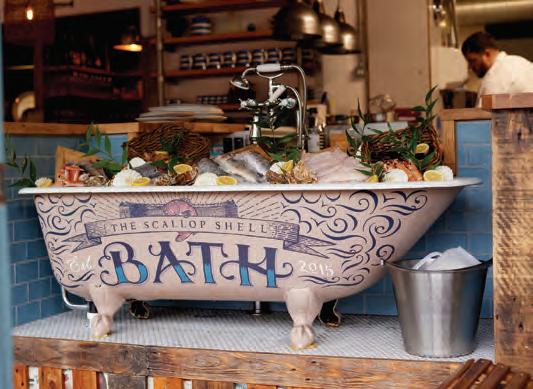
Margherita pizza was named after a queen. In 1889, King Umberto I and Queen Margherita of Italy visited Naples and asked for pizza as a way of escaping the fancy food she was used to eating. She found ‘pizza mozzarella’ delicious, a pie topped with soft white cheese, tomatoes, and basil. So the Margherita pizza came to be.
Perched in Milsom Place, just off Milsom Street in central Bath, Bandook offers an oasis of superb Indian street-food and hospitality. The story began when the team behind the award-winning fine dining Indian restaurant Mint Room had a vision to create a modern, casual dining, Indian street-food restaurant, one that would be fun and relaxed and yet create a 'wow' factor with its cooking. Bandook is the perfect offthe-beaten-track spot to dine and enjoy drinks in a stylish interior inspired by the colonial era. As well as the great food, keep an eye out for the special jazz nights, bottomless brunches at weekends and much more. This is a vibrant, fun, and really great place to enjoy excellent Indian food... Just fantastic!

Longmead Gospel Hall, Lower Bristol Road, Bath BA2 3EB
Tel: 01225 446656 Web: mintroom.co.uk
Described by The Michelin Guide as ‘a smart, spacious restaurant with a distinctly modern, glitzy style,’ Mint Room provides daringly different, high-end dishes, made with first rate British ingredients. Founded by Luthfur Rahman in 2011, the restaurant's menu places emphasis on distinctive, adventurous dishes inspired by traditional and modern Indian cuisine - from the rich tomato and lamb-based dishes of the north and east, to the coconut milk and mustard seed flavoured seafood of the south. Combined with an uplifting ambience, chic surroundings and first-rate service, the dining experience here is a memorable one.
Eveleigh Avenue, London Road West, Bath, BA1 7JD
Tel: 01225 855101 Web: handpickedhotels.co.uk
Relaxed elegance is firmly on the menu at Bailbrook House in Bath, which offers a variety of spaces in which to enjoy modern British seasonal food prepared with passion and served with charm. Drink in the historic period charm of Cloisters restaurant, which takes full advantage of striking architectural features and beautiful views out onto the gardens. An altogether more contemporary space is The Conservatory, a modern setting with plenty of natural light and a summer terrace for peaceful alfresco dining. Characterful royal lounges provide an idyllic spot in which to enjoy afternoon tea, or its private dining rooms are ideal for celebrations and special events. Make magical memories and experience laid-back luxury.

15 Great Pulteney Street, Bath BA2 4BS Tel: 01225 807015 Web: guesthousehotels.co.uk
In the easy-going elegance of The Restaurant at No.15 by GuestHouse, Bath you’ll find refined comfort food, fun food and never-tried-that-before food, using ingredients sourced seasonally, ethically and (where possible) locally. The restaurant offers an odyssey of flavours for breakfast, proper lunches, full-course dinners and the beloved weekly feast, Sunday lunch. Open all week for breakfast, lunch and dinner. Alternatively head to the bar for morning coffee, a playful take on afternoon tea, cocktails made with the best British ingredients or elevenses and snacks. No.15 showcases the flavours and influences of the country’s highlands, lowlands and all its in-between lands.


Nothing cheers up a day that’s lost its buzz than the prospect of a cosy, treatsome afternoon tea – and variations of the afternoon delights theme are abundant in Bath. Go grand at the Pump Room in Abbey Churchyard, dive into a huge pot of tea and a massive slab of homemade scrumptiousness at Café Lucca in Bartlett Street, or escape to the refinement of the Royal Crescent Hotel with its finger sandwiches, delicious cakes and a glass of fizz for the perfect special occasion. There’s a cool alternative too... if you want to spice things up a little then try Robun in George Street; the ceremony of afternoon tea fuses with a full selection of Japanese treatsthink bao buns, sashimi, oriental inspred cakes and ice cream, great tea (naturally) then add a prosecco –that’s gotta be fun.

Web: bistrochef.co.uk
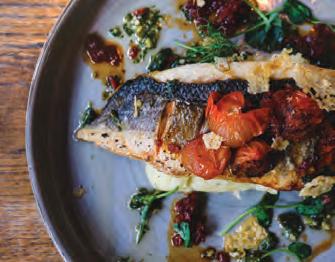
New from one of Bath’s favourite chefs…try Bistro Chef’s delicious dine at home dishes. If you love authentic French flavours and enjoy the convenience and ease of a prepared meal then Bistro Chef is for you. The meals are hand-made in Bath to authentic French recipes, with the finest ingredients and fast frozen to lock in flavour and goodness. Delivered to your door, the dine-at-home dishes include Award winning Boeuf Bourguigon, traditional Coq au Vin, Tarte au Citron and and many more mains, sides and desserts. Popular for the busy working week, a weekend treat or a dinner party. Simply order online for a taste of France at home.

Rode Hill, Somerset, BA11 6AG
Tel: 01373 673112
Web: themillatrode.com
Just a short ride from Bath, The Mill at Rode is nestled amongst some of the best countryside that Somerset has to offer, with outdoor sun-trap terraces resting over the tranquil River Frome, and a pinnacle for local village life. Serving elevated pub classic meals, well-kept ale, refreshing local cider and classic cocktails. The Mill is steeped in history and the old mill wheel is visible from the games room, and the romantic ‘Loom Room’ is the perfect location to say “I do”, along with a padlock to seal the deal on the love bridge. Beautiful in the summer and cosy in the winter this is a great all-year round destination for relaxed gastro-pub dining or special occasions.
Iford Manor, Iford BA15 2BA
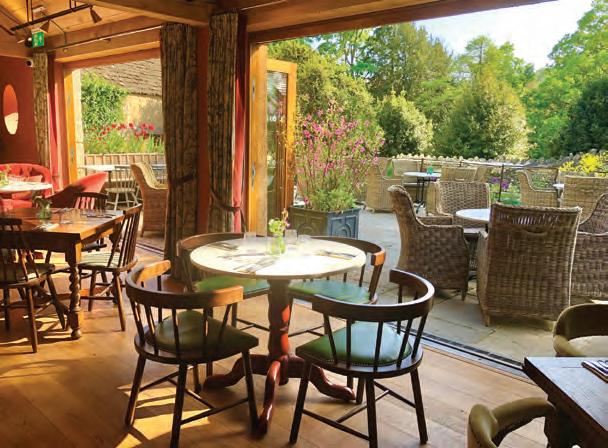

Tel: 01225 863146 Web: ifordmanor.co.uk/restaurant
Just 15 minutes from the centre of Bath in picturesque countryside, Iford Manor Kitchen is headed up by awardwinning Head Chef Matthew Briddon. Seasonal menus celebrate the best of local foods, much of which is grown, reared or foraged from the Iford Manor Estate & walled garden. This integrative approach, linking into the farm and walled garden, means their chefs gain a deeper understanding of terroir, flavour and what it takes to create excellent dishes direct from farm to fork with the freshest of flavours. Please visit the website for opening times and to book. Advance booking essential for jazz lunches or supper clubs.
Monmouth Street, Bath BA1 2AP
Tel: 01225 302829 Web: thegriffinbath.co.uk
Drink, eat and sleep in the heart of Bath. A Georgian Inn with uncommon quality, The Griffin has been welcoming locals and visitors to Bath for nearly 300 years. Tucked a stone’s throw away from the bustling city centre, the pub offers a lively, but laid back space to unwind – over a pint, over a meal or overnight. It’s got outstanding beer, wine and spirits behind the bar, with no end of cosy corners to enjoy them. The food is eclectic and contemporary, and the daily changing menu will be grounded in honest, locally sourced ingredients. Discover The Griffin’s inviting rooms, each thoughtfully designed to provide a peaceful retreat for its guests.
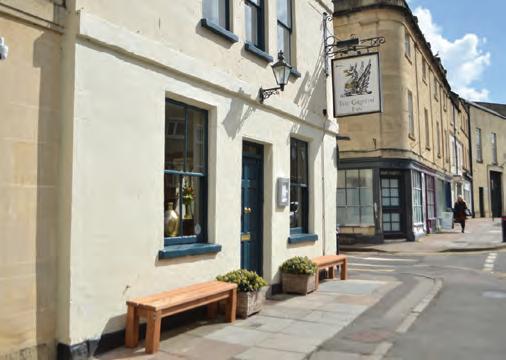
Tel: 01373 830426 Web: chatleyfarmbrownies.co.uk







Pure chocolate brownie love! If there’s one thing that Chatley Farm know well, it’s that chocolate makes everything better. Since 2006, Chatley Farm Brownies has been bringing chocolate love to Somerset, handmade in their professional kitchens on a beautiful farm, near Bath –and you may have seen them at Bath Christmas Market. Choose from 13 delicious flavours, including rich chocolate, chocolate orange, salted caramel, mini egg, rum and raisin, white chocolate and raspberry, and biscoff, to name a few, as well gluten-free options. They also have a selection of Chocolate Brownie Hampers which make the perfect chocolate gift. All brownies are made using the best Belgian chocolate and locally sourced ingredients to create delicious squares of heaven. Delivered by post via Royal Mail, the brownies have a shelf life of three weeks and can also be frozen. Buy online from the Chatley Farm website.



2 -3 Cleveland Place East, London road, Bath, BA1 5DJ
Tel: 01225 322810 Web: refillable.shop

This fantastic independent and female driven local business is the ultimate shopping experience. Refillable is a great place to refill all your everyday essentials, immersing yourself in the true meaning of experiental retail. Their ethos is to offer a different platform of grocery shopping, one that reduces unnecessary plastic packaging. But not just a pretty Refill shop, we’d say! Refillable is the first shop in Bath to offer an alternative to take out disposable coffee cups and bowls: the Edible selection. Yes, you can have your coffee and eat your cup! The cups and plates have become “thetalk-of-the-town” must try product with great feedback from customers. Made from bran wheat they also pack a good nutritional punch. Pop in at the Refillable shop for your daily refills, have a great coffee or cake and enjoy being part of a community that is making a difference to the environment.

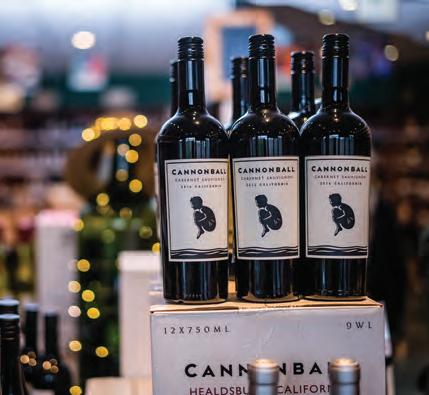
Wells Road, Bath BA2 3AP Tel: 01225 322810 Web: greatwine.co.uk
The Great Wine Company shop has been nestled at the bottom of the Wells Road for almost 40 years, but remains a true find for those who turn into the car park. Described by customers as an Aladdin’s cave of wines and spirits (or an adult sweet shop) the shop holds over 1,000 wines and 450 spirits with new discoveries on every visit. We love its modern, friendly approach, backed up by old-fashioned service and advice. Wines and spirits are always open to taste, and experienced staff are great at finding the perfect wine for you at any budget. More recently, the company has become a specialist agent/importer for some of the world’s great wines, including Trimbach, Frescobaldi, Planeta, Ken Forrester and Seresin. Prices at every level are competitive and there’s always a good selection of special offers. Watch out for the bin-ends for the best bargains. The website and mail-order service is just as good for those further afield. You’ll find its wares in the countries best restaurants hotels and pubs, and it also supplies Bath Rugby and the MCC.
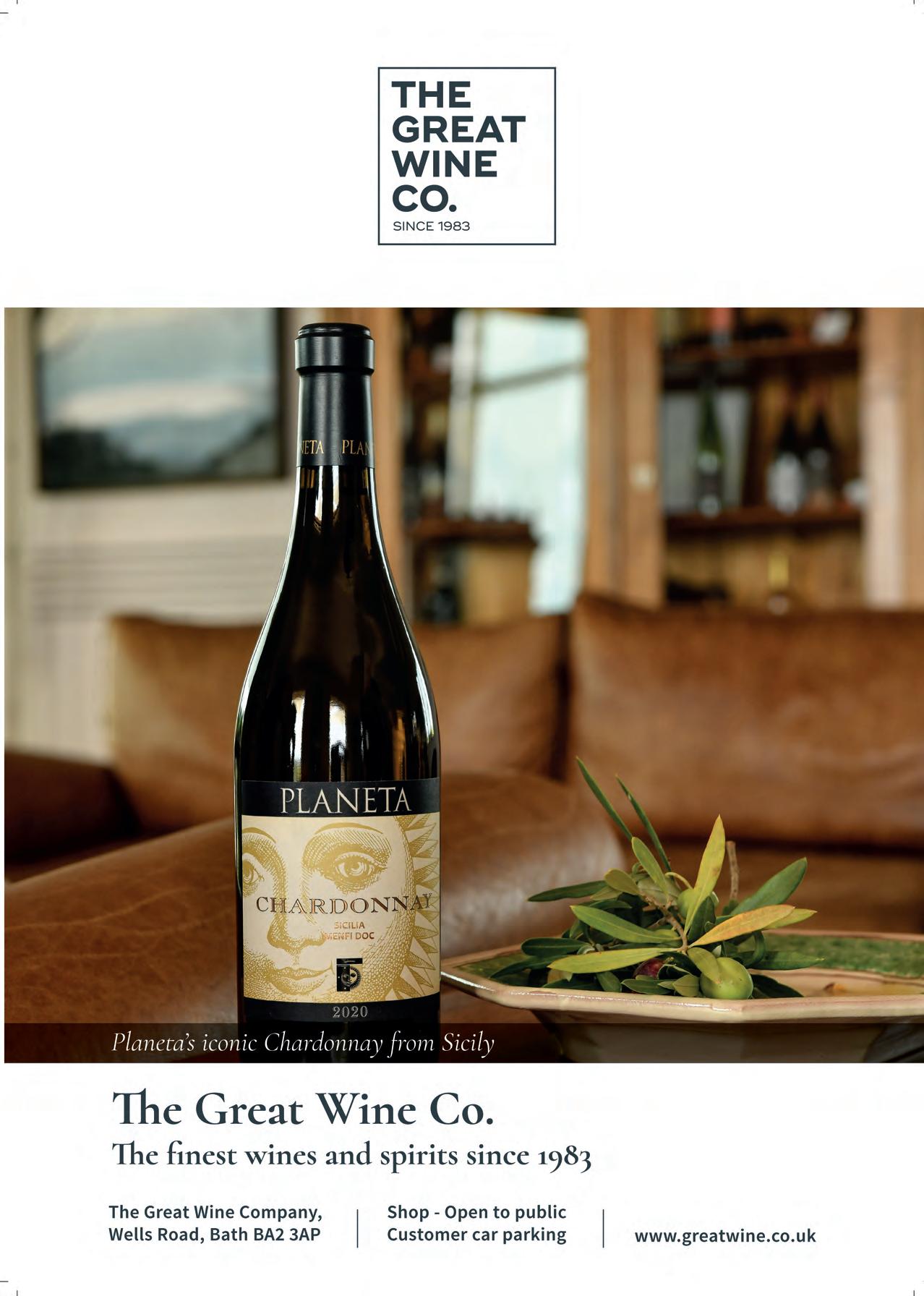
Have you ever wondered what life might look like in 2050 for yourself, your children, and grandchildren? Human advances in technology, healthcare and living standards continue to enrich our experience of life, but what lies ahead? A new series of talks from BRLSI starting this month address some of the key issues

16 June: How to think about the future
Hamish McRae, author and award-winning journalist
Hamish McRae wrote The World in 2020 30 years ago, anticipating Brexit, a populist revolution in America, and the dangers of a global pandemic. He revisits these themes and analyses the forces for change: demography, the environment, trade, finance, technology, and global governance.
23 June: The global economy
Barret Kupelian, Director of Strategy, Price Waterhouse Coopers Barret Kupelian explores which of the global economies will grow fastest, and how natural resources and technology will be key to their resilience in a time of such great flux.
30 June: Climate impact on human health
How do we create the best future for ourselves and our families? Human advances in technology and healthcare continue to enrich us, so could it be that, far from facing a dystopian nightmare, the future offers more grounds for optimism than we think?
The World in 2050 talk series at BRLSI, running on Friday evenings between 16 June and 4 August, enlists an exciting roster of speakers providing insight into the future; asking what we need to understand today to ensure the world continues to thrive tomorrow. With topics covering the global economy, society, politics, governance, the environment, technology and AI, the series is designed to shed light on the key societal features that will form the brave new world before us.
As a precursor to the series, students from Bath Spa University will consider what their major hopes and concerns are for the future which lies before them (16 June at 2pm). The series of eight talks, chaired by Andreas Wasmuht, will each explore different aspects of The World in 2050, demonstrating the interrelated and interdependent dynamics of the world in which we live. Kicking off with a keynote lecture from author and award-winning journalist Hamish McRae and culminating with a very timely lecture on artificial intelligence, the series invites the audience to become the change they want to see in the world and, in the process, pass on a better world to future generations.
The World in 2050 – are you ready for the future?
Dr Eunice Lo, Research Fellow in Climate Change & Health, University of Bristol
How do we mitigate the consequences of extreme weather on human health? Dr Eunice Lo looks at the longitudinal health effects of a warmer climate and how we recalibrate our health systems to meet new challenges head on.
7 July: Society
Victoria Ward, Codirector, Jigsaw Foresight
Victoria Ward considers how investment practices, governance and policy and shifts in human behaviour can have the biggest impact in how we transform society in a positive way.
14 July: Politics and governance
Dr Christian Krys, Roland Berger Global Consulting
The challenges of today’s VUCA (volatile, uncertain, complex and ambiguous) world have never been greater. Dr Christian Krys joins virtually to dissect the current geopolitical scene.
21 July: Global environmental challenges
Elisa Lanzi, Senior Economist, OECD, Environment Directorate
Elisa Lanzi joins via live stream to provide an overview of how projected socio-economic trends to 2050 link to changes in the state of the environment.
28 July: Technology and Innovation
Dr David Born, Roland Berger Global Consulting
Dr David Born joins BRLSI from Germany via live stream and takes a closer look at frontier technologies and the relationship between humans and machines.
4 August: AI and the future of humanity

Professor John Lennox, Emeritus Professor of Mathematics, University of Oxford
John Lennox introduces the key developments in technological enhancement, bioengineering, and artificial intelligence, and elucidates on the new technologies which will transform our lives.
The eight World in 2050 lectures will take place BRLSI, 16–18 Queen Square, Bath on the dates shown below, 7.30pm–9pm, in person or online, tickets £4 members £8 non members; brlsi.org
Across the private, public and not-for-profit sectors, today’s leaders are facing the most challenging operating circumstances for generations. In this landscape of global uncertainty, leaner workforces, budget cuts, and reliance upon digital communications and the competencies needed to lead organisations successfully have shifted. Leaders now need to be skilled at crisis management, dealing with uncertainty and high-level strategic leadership. Due to the continued success of the University of Bristol's part-time Executive Masters in Strategy, Change and Leadership, applications are now open for the eleventh cohort commencing in September 2023. This challenging and rewarding programme is designed for those aspiring to, or holding senior manager and leadership positions and will fit around the demands of a busy, professional leadership role. This bespoke master's degree in Strategy, Change and Leadership is aimed at providing senior managers with the tools and techniques they need to navigate their organisations through demanding times. By attending the programme, you will learn how to improve your ability to manage change and uncertainty; increase your leadership impact; understand organisational complexity and issues affecting success; make better choices about growth and strategic direction. Programme Manager, Cheralyn BainesDark says: “We are delighted to be recruiting our eleventh cohort of executive students to this successful and practical master’s programme. Excellent leadership is vital when facing a challenging and uncertain future, and organisations from all industries recognise the importance of investing in their future Leaders and Managers by developing their management and leadership teams in unpredictable times. This practical master's degree offers value for money and will offer a return on investment from day one.”
If you would like to have a chat about the programme please contact Cheralyn Baines-Dark, Programme Manager by phone 01179546694; or email: mgmt-scl@bristol.ac.uk


To find out more or to apply for September 2023 entry, please visit; www.bristol.ac.uk/strategy-change-leadership-2023


Unlimited is an adjective with power. It’s been adopted in Bath over the years, in 2020 by Bath Unlimited, a project and brand set up to represent and promote a group of highachieving, imaginative and innovative world-leading Bath-based companies. Here’s what it’s like to be unlimited...

Bath Unlimited: the brand Kevin suggested the idea because he felt that people weren’t aware of the great companies in Bath, and therefore when the city marketed itself to attract other companies, people didn’t always come. “People come driven by a herd mentality – they go where there are lots of businesses. So that was the genesis of the idea,” says Kevin.
“We needed to create a brand. The name ‘Bath Unlimited’ was the idea of Chris Stephens, director of the Holburne, because he had been thinking about an exhibition with that title to do with Bath’s outstanding talent. The name was the glue that brought some of these amazing firms together, those that think in a very imaginative, creative way.”
The Bath Unlimited project currently features 27 businesses that fit the Unlimited brand, shown on the opposite page.
“The idea was not only to profile the individual companies but to get over that Bath is not just a leisure and retail economy; it’s a city with five major sectors. All these companies account for about £2.3 billion of revenue. And they provide around 5,000 jobs locally (and 50,000 worldwide), so employment from these stand-out companies accounts for a significant proportion of our region’s jobs. Knowing that we’re really strong in all these sectors, the people of Bath can feel confident about the economy.”

The reasons that these businesses are not necessarily well known in Bath is because their market isn’t local. “We have lots of successful small local businesses who appear everywhere locally. But with a company like Rotork, much of their business is in the US, so they only have a limited amount of time and money to develop a presence here. L&C Mortgages, too, need to win new customers from all around the country so their resources are not spent on local advertising.”
To fulfil the criteria for being ‘Unlimited’ companies have a minimum turnover of £2 million and at least 25 employees. They can have offices elsewhere in the world, but the main office has to be in Bath. They all also need to have something about them that supports the Unlimited story. “The project has to be curated so that these firms are global leaders or they are doing something different,” says Kevin. “We want to get more companies over time but we are not prepared to compromise.”
Unlimited is a word with a strong character, because (adding more ‘un’s), it is unrestrained, unfiltered and uncompromised. Most of all it offers the potential for exploration, discovery, and moving beyond what we see and know for certain.
In 1966, Bath based inventor and entrepreneur Jeremy Fry established Unlimited as an antidote to the exclusivity of the art world by producing unlimited editions of work by some of the leading international artists of the day. This initiative meant these artworks were accessible and affordable to the wider public – and for the first time in over 50 years, co-ordinated by the Holburne Museum, the works have been reunited and displayed as Art for Everyone in the 1960s in Bath’s Assembly Rooms (the exhibition runs until 4 June).
Over the past few years ‘unlimited’ has become embedded within the city of Bath and has been spreading positive vibes all around us. That’s because of Bath Unlimited, a group of outstanding Bath businesses launched in 2020, and its founder, Kevin Peake, Head of Brand at Standard Life. At the start of lockdown, he joined the Economic Recovery Board led by B&NES Council to come up with ideas to activate the renewal of the local economy, and to rebuild confidence in the area as a safe, sustainable and green place in which to visit, study and work.
Bath Unlimited shouts about the vision, industry and achievements of these big local companies that help to drive our economy. As a business group they embody the city’s versatility and its influence. They also reflect the assets it holds – offering present, active and demonstrable skills, innovative problem solving, mastery of a brand and specialist knowledge that is valued and sought after all over the world. These businesses support regional employment and attract new visitors to the city through employees and their friends and family.
. as much or as many as is possible; not limited in any wayFCB Studios have won the most RIBA architectural awards in the UK
Cross Manufacturing produce precision, bespoke engineered sealing solutions for challenging applications

One of the latest recruits to Bath Unlimited is The Good Economy (TGE), the UK’s leading, independent social impact advisory firm, at the forefront of a rapidly evolving market. It has become the ‘go to’ provider for investors who are committed to making a positive social impact. especially in social housing. Founded in Bath by Bathonians, Sarah Forster and Mark Hepworth, TGE has deep roots in the Bath community and is working with local stakeholders to find solutions for affordable housing in Bath through its PBII Innovation Lab.
Others include StatsBomb, the world’s fastest-growing sports data company, using data analysis teams to ensure sports organisations have access to the best data sets ever created. Also Network N, the fast-growing media business focusing on gamers, gear and esports, reaching over 60 million unique users per month across their network. Another notable recruit is Shakeup, just one year old and the leading men’s cosmetic brand with vegan-friendly and cruelty-free products made in the UK. BB cream is one of its flagship products, and one of these is sold every eight minutes in the Chinese market.
Bath Unlimited has also set up an under 35s networking club called Unlimited Potential to help young professionals connect and share resources in Bath. The network combines educational networking with guest speakers and fun social activities. It is open to all under 35s, no matter where they are in their career. Unlimited Potential is celebrating its first birthday in July. For more details check out the Bath Unlimited social media on LinkedIn, Twitter and Instagram (@BathUnlimited).
There’s yet more unlimited potential going on because the not-forprofit organisation TEDx Bath –an independent part of the global TED organisation –has adopted the Unlimited theme for their annual event on 14 October at the Forum, with inspiring live talks and performers from invited individuals, all thinkers, doers and ideagenerators. Curator Geoff Rich says, “TEDxBath is for everyone and anyone who is interested and enthusiastic about ideas for the future of Bath and its community, both now and in future.” Among the speakers last year were 12-year old schoolboy Max Woosey, widely known as ‘The Boy In The Tent’; world-famous pioneer of zero carbon architecture Yasmeen Lari; and social entrepreneur, creative, public speaker and polymath George Obolo.

Talking about TEDx and its Unlimited theme, Professor Andy Salmon from Bath Spa college said: “Wallace Stevens states that ‘the imagination loses its vitality when it ceases to adhere to what is real’. Furthermore, he defines the ‘imagination as the sum of all our faculties’. For me this is the essence of a great TEDx talk, where what we imagine as tantalisingly possible is constantly brought into contact with tangible actuality of our lived experience. Unlimited Inspiration indeed.”
It’s the same with Bath Unlimited and its 27 companies – they provide imaginative solutions for the real world – driven by collaborative individuals who care deeply about what they do and dare to dream of what can be achieved. n
Bath Unlimited company Main business
Actual Experience
Avon Protection
BMT
Buro Happold
Complete Control
digital strategy business analytics
life critical personal protection systems
naval architects
engineers, consultants and advisors
children’s animation studio
Cross Manufacturing sealing solutions
FCB Studios architects
Format Engineers
structural engineers
Future publisher
Grant Associates
Horstman Group
Inspecs
L&C Mortgages
Lovehoney
Mayden
Network N
Novia
landscape architecture
military suspension
fashion eyewear
mortgage broker
sex toys and wellbeing products
healthcare technology
games and media
financial services
Play Sports Network cycling media
Rocketmakers
Rotork
Shakeup
StatsBomb
Storm
Truespeed
The Good Economy
University of Bath
Zynstra
softward development for elite athletes
mission critical flow control and instrumental
men’s cosmetics
sports data
digital agency
broadband provider
social impact advisory firm
commercial innovation
software
bathunlimited.org; tedxbath.co.uk
After seven years of providing private dentures to the public, JB Denture Clinic has officially changed its name to JB Dental & Denture Clinic. The clinic will now be taking on new private patients covering all aspects of dentistry.

The clinic wants to offer patients an all-round dental treatment as well as dentures while also maintaining a warm family feel to the business. Many of the clinic’s denture patients would often ask if there was an inhouse dentist they could see to make their treatment easier and finally this is possible. JB Dental’s dentistry services come without long waiting lists and range from hygiene appointments, to Invisalign and all dental treatments for adults and children. jbdentureclinic.co.uk
A crane recently lifted a specially commissioned ‘Swifts’ sculpture into place at the Dyson Cancer Centre. The artwork was created by internationally renowned sculptor Hamish Mackie, who was on site to oversee the careful installation of the 80 kilo bronze sculpture at the Royal United Hospitals Bath NHS Foundation Trust (RUH). ‘Swifts’ was specifically designed for the Dyson Cancer Centre, as a symbol of hope and optimism, and will form the focal point of a first floor courtyard. ruh.nhs.uk
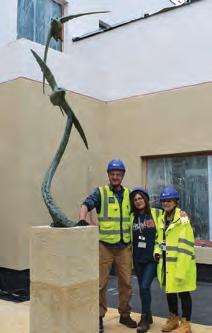

Ring Out, a bell-founding and ringing celebration project will take place at Frome Festival, thanks to a grant from the Heritage Fund. Ring Out, a new project from Rook Lane Arts Trust and Artmusic, which is a celebration of bell-founding and bell-ringing has been awarded a grant by The National Lottery Heritage Fund. Funding has also been awarded by Frome Society for Local Study and Frome Town Council (The Mayor’s Fund 2022). The project is also made possible with the collaboration of many local partners: bell ringers from Somerset and Wiltshire, Poetry in Motion, Frome Museum, St John’s Church, Matthew Higby & Company Ltd, and The Silk Mill and Frome
FM Community Radio.
Ring Out will form part of this year’s Frome Festival (7–16 July) with 13 events taking place across the event’s 10 days, including walks, talks, concerts and tours. For details of events visit fromefestival.co.uk
Sean Price has been appointed to take over from Greg Taylor as the new head teacher of the Junior School at King Edward’s School, Bath.

Sean joins King Edward’s from Westonbirt Prep School where he has been headmaster for the last seven years. Sean is a hugely passionate educationalist and continues to be an enthusiastic hands-on teacher. After gaining a degree from Cardiff University in English Language Studies, Sean worked in the sales industry before completing his PGCE at the University of Bath. He has since honed his skills and experience across both the state and independent sectors.
Sean also holds various roles within IAPS, the Independent Association of Prep Schools, of which the Junior School is a member, including serving as the National Sports Committee Chair and Director. Sean joins the Junior School at the beginning of the Spring Term in 2024. His appointment follows the decision by Greg Taylor to step down as head teacher of the Junior School after a long and distinguished career at KES. kesbath.com
Cllr Dine Romero will be elected the 796th Mayor of Bath during the meeting on 3 June of the Charter Trustees at Bath Abbey. Dine has 20 years of service as a Lib Dem councillor for Southdown ward and is a former leader of B&NES Council. mayorofbath.co.uk
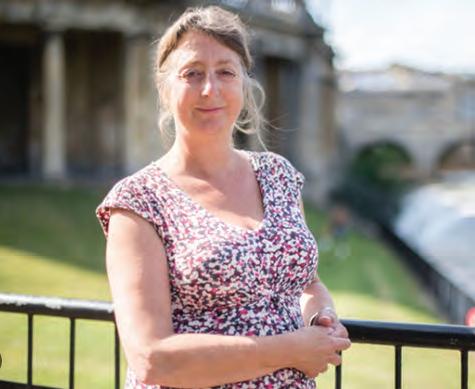

Before 6th April 2017, as a landlord you were able to offset rental finance costs against the rental income generated, thus reducing your rental profit and your tax liability.
However from 6th April 2017 onwards, measures were gradually introduced to restrict relief for finance costs on residential properties.
Finance costs includes mortgage interest, interest on loans to buy furnishings and fees incurred when taking out or repaying mortgages or loans. No relief is available for capital repayments of a mortgage or loan.
Landlords are no longer be able to deduct all of their finance costs from their property income to arrive at their property profits but that doesn’t mean tax relief is not available.
Instead landlords receive a basic rate reduction from their income tax liability for their finance costs i.e. 20% of your mortgage interest. This figure is deducted from your overall tax liability.
If you are generally a basic rate taxpayer, it is likely these changes haven’t affected how much tax you pay on your rental profits each year. Although the tax relief calculations have changed, the tax position for most basic rate taxpayers is the same before and after the rule change.
The landlords most affected by the change are those that are higher rate or additional rate taxpayers. Under the old rules you would have received 40% or 45% tax relief when the mortgage interest reduced your rental profits before your tax was calculated.
Now the mortgage interest is not deducted when calculating your rental profits; your rental profit will be taxed at 40% or 45% and you will instead receive a reduction to your tax liability of 20% of your mortgage interest cost, therefore losing out on 20% or 25% of the tax relief that was available prior to 6th April 2017.

The tax reducer cannot generate a tax refund but all is not lost if you do not earn enough in the year to utilise your mortgage interest; it will be carried forward until you are able to use it.
The changes do not apply to furnished holiday lets or commercial lets, mortgage interest relief is still available under the old rules in those cases.
For tax saving tips contact us – call Tristan Wilcox-Jones, Samantha Taylor or Lucas Knight on 01225 445507



Separated parents with children who are at school will often need to make decisions about secondary schools.
With secondary schools varying so much and parents having access to league tables, choosing schools for children is hard enough let alone if you are no longer together with the other parent.
Schools are selected by parents on the basis of school’s ethos and attention to certain types of ability (whether that is traditional academic subjects, arts or sport and on the basis of their religious affiliation.)
If you are unable to agree as to what type of education you think is right for your child then having an informal discussion with your child’s teacher could be useful.
Insight into how other’s see your child’s strengths and weaknesses and what drives them at school could help to determine what environment your child will thrive in and therefore what school would suit and benefit them.
If having discussed matters with your child’s teacher you are still not able to agree with the other parent as to what would suit your child in relation to their education, then you could consider mediation or family counselling. Both will assist you and your ex-partner to consider and discuss the various options available to you and hopefully allow you to choose a school for your child, which would be best for them. It is worth noting here that as your child is approaching 12 their wishes and feelings will need to be considered in the decision making process and many counsellors and mediators have the ability to meet with your child and help them in expressing their views.
If you are still unable to agree then either party can make an application to the court for a specific issue order. Parents involved in these disputes will often cite school tables as a way of asserting their position however the court will be reluctant to suggest one school in the community is better than the other. The court is only interested in what is in the best interest of the child, and more importantly it will consider the child’s wishes and feelings over any aspirations of the parents.
The situation is made more difficult when disagreeing parents do not live near each other. A geographical distance between separated parents will mean that it is no longer feasible for the child to live or share their time between both parents. In the situation the child will need to attend school and live with one parent and have contact with the other. The decision as to which parent a child will live with will not be made on the basis of who lives near the best school but which is the most appropriate parent to look after the child.
If this is an area that you are struggling with and need assistance to reach a solution please get in touch with Family Solicitor Simon Walker on 01225 750000 or email simon.walker@mogersdrewett.com we are here to help.






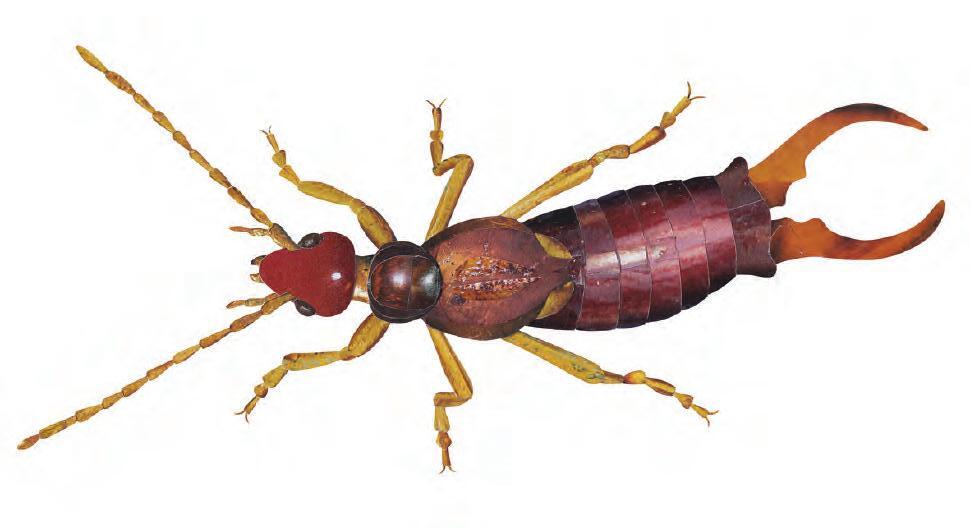
The threat to our environment from climate change can feel overwhelming. But there are many things you can do to protect not just wildlife, but the insect species who work to keep your garden in balance. I met up with illustrator Marian Hill to find out more
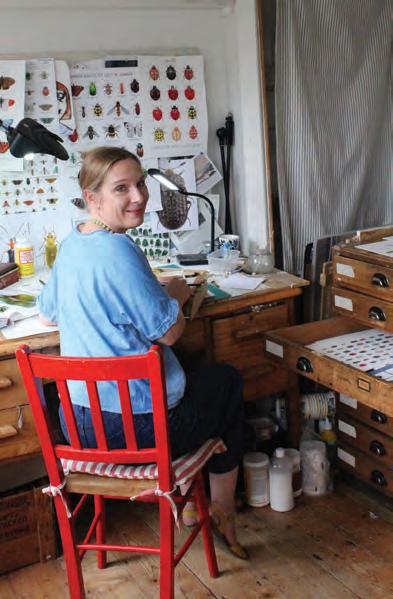
We used to spend hours crawling through long grass to play. I hated ball sports, so for me cut lawns meant formal picnics and ball games and long grass meant freedom and fun.”
So says artist illustrator Marian Hill who spent her childhood in the landscape of the Mendip Hills. This connection returned to her years later after having worked for a long period as a professional illustrator when she took her illustration students at UWE to the Natural History Museum collection in London. “They have 80 million specimens in the vaults of the museum and they are photographing them to get them online as a research resource. We had a tour and Gavin Broad, the Principal Curator In Charge of Insects, gave us a talk in the insect department. He touched on why digitisation is important and why insects and the environmental habitat need to be recorded. That set something off in my head. A year or
so later I started illustrating insects in the garden. I thought I could act as a mini version of what the National History Museum are doing by recording everything and telling everybody what’s there –then people might care about it, look after it and adopt nature friendly gardening techniques.
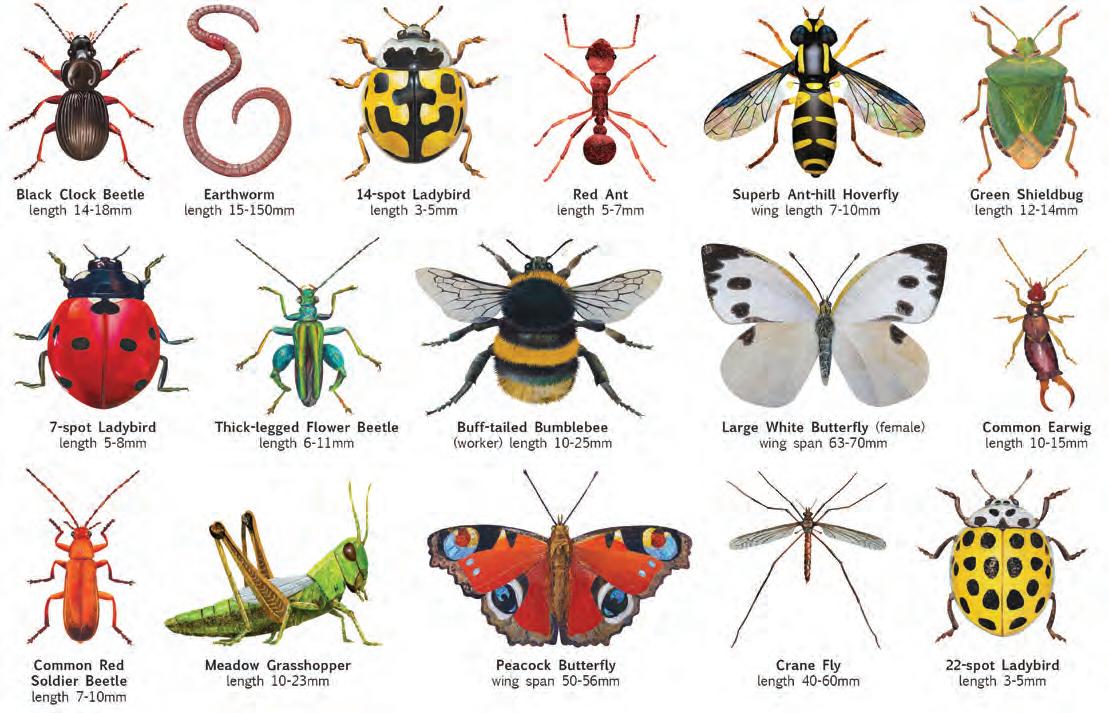
“I thought it would take me two or three weeks to record the insects in the garden. I just had no idea. I’m way over 200 illustrations in and I’ve barely started. I’d say at least half of those are in our garden, and many more are really local.”
Marian’s insects are not painted, but are collaged from cut-up magazine pages and other papers (see image on opposite page). This means it is a technique that children can easily use, something that Marian takes full advantage of by running children’s workshops. “I do think if you hook kids in the grown-ups follow. The best feedback I had was when I was putting the rubbish out and a lady stopped me on the street and said,
Insects that thrive in long grass and wild flowers
‘Are you the beetle lady?’ And then she said, ‘Since you put your posters up I’ve stopped squashing things in my garden, and now I look at them.’ I think that’s it –that’s what I’m trying to do.”
To maximise the potential for insects Marian transformed the management of her garden from regular lawn mowing and keeping neat beds to something more freeflowing. “I’ve just let the garden go a bit, not completely, but by not digging, and not mowing as much as possible. I trim the grass so we’ve got a sitting area but I do that by hand because we’ve got slow worms and I don’t want to hurt them.” Other garden strategies are creating stick and log piles, having a tiny pond for water insects, and leaving piles of roots and dead sticks around.
“I have got really attached to my insects. Things like grass bugs which have started to thrive in the garden because I’ve let the lawn grow and seed. And we’ve got tortoise beetles nesting in the mint –they are so beautiful. They chomp through my mint but they don’t kill it. I’m going to plant extra mint this year to feed my beetles.”
Marian has been working with Bathscape (who promote the natural landscape around Bath) on what she calls her Buzz and Scuttle project. They put her in touch with local entomologist and ecologist Mike Williams who has an encyclopaedic knowledge of insects and local history. “Mike gives me species lists for local insects, I send him photographs and he’ll identify insects, checks my illustrations and points out any errors. I soon realised that entomologists get rightly frustrated when artists make obvious blunders when illustrating insect species, so I try and get details right and welcome feedback from experts.”
With Mike’s help Marian creates posters of groups of insects and works with Bathscape to get them into parks and schools. “I cannot believe the positive response from the community. My main problem is I haven’t got enough hours in the day.”
ABOVE: A Cabbage Bug created from collage by Marian Hill OPPOSITE, above: Common Earwig (Forficula auricularia)
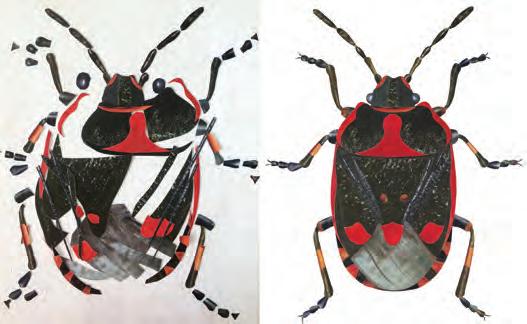

The posters cover themes such as waste disposal, pest control and pollinators, showing how useful insects are to a garden. “Many people don’t realise that insects are doing jobs for us. They think they need to destroy them because they get out of control, but pests don’t get out of control if you’ve got insects in the garden to help maintain the balance naturally.”

Marian is also contributing to Bee Bold, a WECA funded pollinator project, working in collaboration with Bath Parks Department and Blooming Whiteway to redesign eight sites across B&NES to create pollinator habitats. “Working in partnership with local communities, these open spaces should become better places for both people and insects. “We are aiming to communicate to residents why long glass and wild flower verges are so important for wildlife. With insect numbers falling so radically, it’s vital that we all help to create insect habitat wherever possible and maintain green spaces in a way which nurtures wildlife.”
Marian explains, “My insect project is working because I’m trying not to preach too much. It has to come from people understanding and loving insects.”
Here is how to make a difference in your own back garden. n

Marian will be running a workshop on 11 June at the Festival of Nature in Bristol (9–18 June); bnhc.org.uk/festival-of-nature/events; marianhill.co.uk; buzzandscuttle.com; bathscape.co.uk
Marian’s garden
I’ve got really attached to my insects. We’ve got tortoise beetles nesting in the mint - they are so beautiful
Summer holidays are on the horizon and if you’re looking for exciting days of activities for young ones, then The Paragon School in Bath has the answer. Led by teaching staff, with a focus on learning new skills, its growing portfolio of clubs guarantees an inspiring day away from screens.

Camp Teepee: adventure and learning in the great outdoors
Eight acres of stunning woodland and grounds are the setting for Camp Teepee – think Swallows and Amazons-style adventures, where children aged 6-11 can explore, make dens, learn to light fires safely and cook delicious concoctions (nachos and apples dipped in caramel sauce are a firm favourite) or brew a hot chocolate to enjoy in the dappled shade. Amble through a stream and make rafts for a Jelly Baby crew, play team games with newly found friends, or make maps to lead your chums to buried treasure.
when they will bake unicorn-themed cake pops, whizz up a magical strawberry milkshake and craft savoury magical wands. It goes without saying there will be an abundance of edible glitter throughout the day. Always hugely popular and a sell-out, Cookery Club is for children aged 5-11. Bring your own aprons and Tupperware to take goodies home – the rest is provided in the cost of the day.
10 July: Foods from Around the World; 17 July: A Baking Day; 24 July: Unicorn Foodie Experience. £50 per day. 9.30am – 3pm.
collage, printing, drawing and painting workshops – often inspired by nature.
This July she will be running a two-day Deep into the Woods art workshop for children aged 7-15 years. Participants will explore dry point etching, printing and drawing techniques, inspired by the compositions of artists Samuel Palmer and Flora McLachlan. Not restricted to the indoors, the group will spend time observing the natural woodland surrounding the school. 24-25 July. £100 for two days. 9.30am –3.30pm.
Dance Workshops: time to shine on stage
A new Dance Workshop launched at Easter in the school’s Music Lodge and was a roaring success, with a day of choreography followed by a show for parents. Reception teacher by day, Amelia Hart is taking Bath by storm and inspiring children to get moving and perform to an audience.

Now in its seventh year, Camp Teepee has gained a reputation locally and has many regulars keen to come and experience the hands-on, learning-inspired days in a natural environment. Tom Isherwood, Head of Outdoor Learning at The Paragon and Camp Teepee leader, says: “It’s always a joy to see how a child’s confidence grows during their time with us – our activities are hands-on, practical and everyone wants to get involved. The end of the day always comes too soon!” 11-12 and 17-19 July, 21-24 August. £40 per day. 9.30am – 4pm.
Cookery Club: get creative in the kitchen

If exploring and getting muddy isn’t what you’re after, then Mrs Martin’s Cookery Club is a tempting alternative. The Paragon’s Head of Computing is a whizz in the kitchen and whips up new and delightful experiences for children during the holidays. Choose from three delicious days this summer: Foods from Around the World, A Baking Day and Unicorn Foodie Experience.
Veggie sushi, Moroccan couscous and American chocolate chip cookies will be created on the trip around the globe, and croissants and lemon drizzle cake on Baking Day. Budding chefs get to unleash their inner sparkle on the Unicorn Foodie Experience day,
Deep into the Woods: art workshop inspired by nature
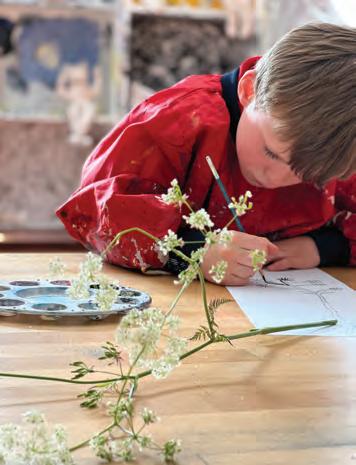
Stepping over the threshold of The Paragon’s art studio is akin to entering Aladdin’s cave –it’s a treasure trove of creations made by pupils past and present, and curated to delight the eye. Head of Art Alex Hucks is a creative genius and known for her sewing prowess,
Girls and boys in Years 3-6 (aged 7-11) are all welcome to attend her energetic one-day classes, which will have Strictly and Musical themes this summer, plus a two-day workshop: Dance through the Decades – from Charleston to rock ’n’ roll to Flashdance to hip hop. No experience is necessary, just an open mind and plenty of get up and go. Parents are invited to come along to a performance at the end of the day – that’s show business!
11 July: Musical Dance Workshop; 12 July: Strictly Dance Workshop; 17-18 July: Dance Through the Decades Two-day Workshop. £50 per day. 9am – 3pm (with an extra half hour for parents’ showcase, finishing at 3.30pm).
All clubs can be booked at www.paragonschool.co.uk/holiday-clubs. The Paragon is an independent school for children aged 3-11 in Bath. www.paragonschool.co.uk
T: 01225 310 837




Forest of Imagination, the event designed to showcase the creativity of the city, is celebrating its 10th year. This year the free event will take place at the Assembly Rooms and will run for a whole month, from 14 June –14 July. Emma Clegg talks to Andrew Grant and Penny Hay about what’s in store...
Bath’s spectacular Assembly Rooms will be the venue for this year’s Forest of Imagination which is marking its 10-year anniversary.The National Trust, who own and manage the Assembly Rooms, this year invited Forest of Imagination to develop a unique event as part of the Trust’s transition plans for the world-famous building, while the charity finalises plans for the future and undertakes building work ahead of opening a Georgian experience in 2026.
Tom Boden, General Manager for the National Trust Bath Portfolio, explains why the two have a good alliance: “There is such a synergy between the National Trust aims and what Forest of Imagination cares about, in particular the importance of enabling nature connection. It feels like a great alignment for local partnership and we’re delighted to host this year’s event. The Trust also owns around 600 acres of countryside around Bath and we have a key role in championing the green setting and making it accessible to more people, which again feels strongly aligned to the ethos of Forest of Imagination.”
Forest of Imagination, which this year runs for a month from 14 June to 14 July, will see the building reimagined as a focus for the community of Bath, as people are invited to ‘Assemble in the Forest’. This theme is inspired by the opportunity to link art, nature and the social life of the city into an experience that takes full advantage of the grand internal rooms and the distinctive outdoor spaces. Spaces inside and outside the Assembly Rooms will be transformed into a series of
playful, nature-inspired art experiences, offering visitors the chance to immerse themselves in multi-sensory installations, soundscapes and sculptures; join artists’ workshops; and explore a whole host of creative and community projects from top local and international artists, designers and businesses.
The event is masterminded and managed by Grant Associates, House of Imagination, Feilden Clegg Bradley Studios and Bath Spa University, working alongside the creative, cultural and educational community of Bath. The idea is to celebrate the beauty and biodiversity of Bath and, as Forest of Imagination has done every year, to showcase the imagination of the community. It also provides an opportunity to shine a light on the importance of forests across the world and what they mean in Bath, especially in response to the climate emergency.
“We are inspired by the opportunity to link art, nature and the social life of the city into an experience that takes full advantage of the grand internal rooms and the distintive outdoor spaces,” says Forest cofounder and director of Grant Associates, Andrew Grant.
The main entrance will be transformed into a welcome pavilion called Birdsong by artist Morag Myerscough, who is fascinated by how colour, pattern and words can change urban environments and people’s perceptions of spaces. A freestanding framed structure will sit in front of the historic building and it will be filled with scented planting, placards and activist messages with solar panels and weather vanes (see Morag’s visualisation opposite).
Having entered the building with the sensory scene established, visitors will then encounter a series of experiences in the corridor leading towards the Ballroom. As Andrew says, “We want to populate the key spaces on the ground floor with things that are going to make you think.”
If you are not thinking by the time you get to the Ballroom, the host of feathery grasses that will fill the room and the winding pathways through them may take you by surprise, creating a powerful counterpoint to the grand architecture of cornices, columns and elaborate chandeliers above.
“Bringing in living material to a place like this is not without its challenges,” says Andrew. “But it will be a transformative experience, so people will come here and see the room differently. There will also be audio recordings and devices for the children so they can engage with the installations.”
The Ballroom will also tell a story about a 250-year old tree that was cut down last year from the garden of Margaret Heffernan, entrepreneur and Professor of Practice at the University of Bath, which will be used in the space in different ways. Penny Hay, artist, educator and co-founder of Forest of Imagination, says, “We are keen to emphasise the relationship we have as humans with the non-human world. We are nature, nature is inside us and so we have an effect on nature. Our DNA is in the forest.”
The Grand Octagon space will tell a story about beavers, once extinct in Britain, but which are now thriving on the banks of the Avon and along Bathampton Meadows. “The central installation will be an attempt to make a beaver lodge beneath the chandelier –so there will be this organic, messy structure against this incredible symmetrical piece.” There will also be headsets for people to see virtual tours of the beaver enclosure at Holnicote Estate in Exmoor where the Trust has reintroduced beavers in a managed way. “Our challenge is to make this place messy,” says Andrew looking up at the magnificent soaring curves of the ceiling.
The Card Room will become the Documentation Room, providing an opportunity for the artists and creative professionals to document what they are doing with children, families and schools, so it will be like a live exhibition. There are plans for a rainforest in the background and an installation by local florists. Penny says, “Concepts like imagination and creativity can sometimes be tricky and by showing what it means we are inviting people to think about being imaginative. Our approach to learning is all about nature connection, imagination, creativity, wellbeing and belonging.”
The Tea Room will reuse the temporary gallery walls created for the Holburne’s Unlimited exhibition. This space will reflect the different aspects of Bath’s landscape. Visitors will discover the work of Bathscape, which is dedicated to exploring, understanding and restoring Bath’s Landscape; the National Trust’s presence in Bath; the Rainforest Concern charity, a global initiative that is based in Bath; engage with some of the familiar trees of Bath and with a history of Forest of Imagination, which each year re-imagines a familiar space in Bath to highlight the importance of nature and imagination in our lives.
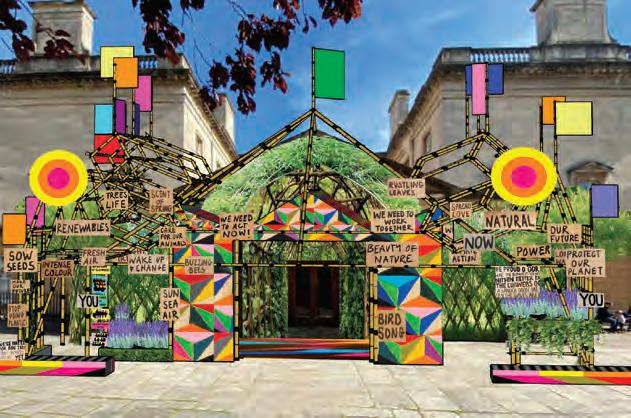
As always the work of many artists will be included in Forest of Imagination. One is Frances Gynn who produces immaculately detailed drawings of animals and then rubs them out in what she calls a Public Erasure, where observers get the real sense of an animal and a potential species being lost from the world. Another artist, Clare Day, will inhabit a quiet, dark space and will project an image of one of her ceramic moons on a wall –this is intended as a contemplative space. “This is a really beautiful, poignant work, reflecting on the concept that we all see the same moon. How it brings humanity together but also connects us strongly to nature,” says Penny.
The Rabbit Holes Collective will also be present, a group of artists exploring adaptive podcasting to create unique content and invite people to metaphorcally ‘fall down a rabbit hole’ to connect more deeply with nature. And harpist Kate Petty will be visiting at the weekends to add extra atmosphere from the Assembly Room balconies.
Outdoors in the North Garden younger visitors will be able to take part in workshops in the garden for messy clay and paint work or water play.
Over the last 10 years, more than 60,000 visitors have attended Forest of Imagination and over 100,000 have interacted with the contemporary arts event online. And every year around 20 local schools, five partner universities and 50 artists and creative professionals help grow new branches of the event.


This is an ambitious project that has been organised with vision and dedication by volunteers. Designed to take over the elegant Assembly Rooms of Bath, it will make us see the building in a novel way, inhabited by the natural forms of the environment with trees, meadows, beaver lodges and the moon. And the best bit? It’s free for everybody. n
Forest of Imagination at the Assembly Rooms, 14 June–14 July. To find out more about the programme visit: forestofimagination.com
Photograph by Michael WharleyAll around the world people use forests as places to find respite, either individually or together
Rachel is a compassionate and experienced Rapid Transformational Therapist and Coach. For 20yrs she has coached clients to release limiting beliefs and transform their lives.

Rachel’s work is focused on the mind / body connection.Linking physical pain to emotions, Rachel's therapeutic process helps clients to go beyond the physical symptom and look at the emotional anchor. People live with their headaches, gut problems and more serious chronic conditions, not realizing that they can face these physical problems at an emotional level. Blocked, suppressed emotions don't just burden the mind, they weigh heavy in the body.
Using techniques that work on the conscious and subconscious layers of the mind, Rachel helps clients to shift unresolved, stuck feelings, enabling them to experience a new level of mind and body freedom. The approach is fast paced and empowering and can have life changing, positive results.
A free discovery call allows you to connect with Rachel and explore how her approach could be of help. Rachel will take you through an enquiry process and recommend a way of working together. Rachel has specific training to support clients with cancer. To book a discovery call, visit Rachel's website: www.rachelbraggcoaching.co.uk
Appointments are available at her Bath clinic or online.

“I have made genuine peace with unresolved grief, guilt, loss, all of which I’m certain has had an impact on my emotional body and my cancer. I’ve gone from having an inoperable tumour to surgery being an option which is incredible. Some conventional treatment has contributed but I know how much of an emotional burden I’ve been carrying too. Working with Rachel in her calm, compassionate, reassuring way has helped me on so many levels to release & resolve the pain. I’m hugely indebted to her for her part in my healing.”
www.rachelbraggcoaching.co.uk
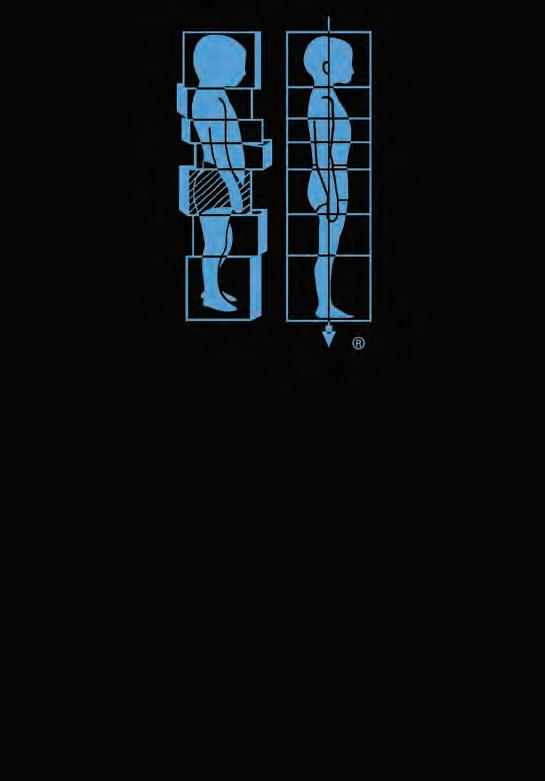
YOGA THERAPY
IN BATH & STANTON PRIOR
Do you suffer aches, pains, stiffness, difficulty walking or making simple movements?
Structural bodywork will release strain patterns, change postural alignment & ease chronic pain
Yoga Therapy will tailor make a practice to encourage correct movement patterns & neuromuscular re-education
A GREAT COMBINATION OF MAKING CHANGES AND GROWING INTO THEM

Flawless skin in a matter of seconds
Removes unsightly skin tags, warts and age spots for that perfect finish



• Swedish massage
• Aromatherapy

• Hot stone
• Indian head massage
• Pregnancy care
• Menopause wellness


Scientific skincare that really makes a difference
Outsanding results for all skin types and all ages
Non-invasive body sculpting treatments to help reduce cellulite, lift, firm and tighten the skin and help break down body fat.

This month Andrew Swift revels in the tiers of crescents that grace the northern slopes of Bath. The first one is the breathtaking sweep of Norfolk Crescent built on level ground, and the last is Camden Crescent, named after the Earl of Camden, which was never completed and where subsidence resulted in some houses collapsing

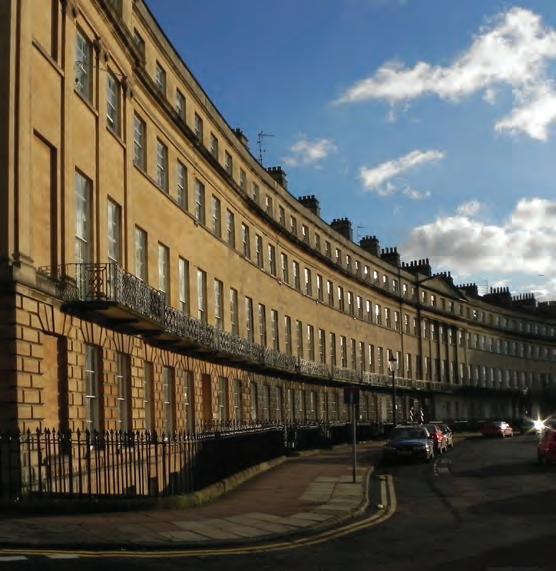
This month’s walk explores Bath’s northern slopes, where tier upon tier of crescents arose in the late 18th and early 19th centuries. The walk starts, though, by Churchill Bridge at the bottom of Southgate Street, from where we head west, along the north bank of the river. After 450m, follow the riverside path as it rises up to head through Green Park, and carry on under a large road bridge. A little further on, just after going under a pair of bridges leading into Green Park Station, turn right up steps, continue along a road and turn left along Great Stanhope Street.
At the end, you are confronted with the breathtaking sweep of Norfolk Crescent, started in 1792, but abandoned due to a financial crash a year later and not completed until 1822. The original architect was John Palmer, but when work resumed the plans were revised by another architect called John Pinch. One delightful touch is the Greek Revival watchman’s shelter, based on the Choragic Monument of Lysicrates in Athens.
This is the only one of Bath’s crescents built on level ground at the bottom of the valley. However, it was beside the river, and the prospect of green fields on the far bank must have been delightful. It wasn’t long, though, before those fields disappeared under railway yards and factories, later to be replaced by a supermarket car park. Hence the trees that now block the view.
Turn right along Nile Street, cross the zebra crossing and turn left along the Upper Bristol Road. Turn right up Marlborough Lane and after 200m you will come to a pair of sphinxes guarding the entrance to Royal Avenue. The Greek Revival gateways opposite date from 1830 when Royal Victoria Park was opened; the obelisk beyond them was erected in 1837 to celebrate the accession of Queen Victoria.
As you carry on uphill, Royal Crescent comes into view on the right. This is not only one of the great set pieces of Georgian Bath but also one of the most instantly recognisable buildings in the world. Built by John Wood the Younger between 1767 and 1775, nothing like it had been seen before. It was not just the design that was new, it was the way Wood the Younger forged a new relationship between that design and the natural world, creating a building that fitted into the landscape and commanded the sort of view you might expect from a country mansion. It was, in effect, an urban building reinvented as part of the landscape, and the template for the crescents that followed.
Marlborough Buildings, on your left, started as a stand-alone development of three houses (Nos. 13–15), before being extended in both directions.
At the top, cross to continue up Cavendish Road. After 200m, you come to Cavendish Place, built by John Pinch between 1806 and 1816. Beyond it, after passing the entrance to Cavendish Lodge (built in 1996) turn right to walk around Cavendish Crescent. Also by Pinch and built between 1815 and 1830, it was Bath’s last Georgian crescent, the final flowering of a style that had epitomised gracious living for over half a century. Until his death in 1874, Sir William Holburne lived at No. 10, where he squirrelled away the paintings and objets d’art now on display in the Holburne Museum.
At the end of the crescent, carry on uphill. Doric House, on your left, was built for the painter Thomas Barker in 1805. On the other side of the windowless wall is a vast mural by Barker depicting the massacre of 25,000 Greeks by Ottoman troops during the War of Independence in 1822.
At the crossroads, cross and head up steps to Somerset Place, designed by John Eveleigh, Bath’s most maverick architect, and a crescent in all but name. Work on it started around 1790, but was abandoned when Eveleigh went bankrupt in 1793. Although work resumed some 15 years later, it was never completed, leaving an uneven number of buildings on either side of the central feature. It was badly damaged by bombing in April 1942, and the three houses at the west end are total rebuilds, while much of the rest was rebuilt behind the façade as student accommodation in the 1950s. In 2006 it was bought by developers and converted to townhouses and apartments.
Head along Somerset Place and, as you carry on up the astonishingly steep slope of Lansdown Place West, Lansdown Crescent comes into view ahead.
Surprisingly, for such a monumental achievement, the architect is unknown, although it has been attributed, on rather flimsy grounds, to John Palmer.
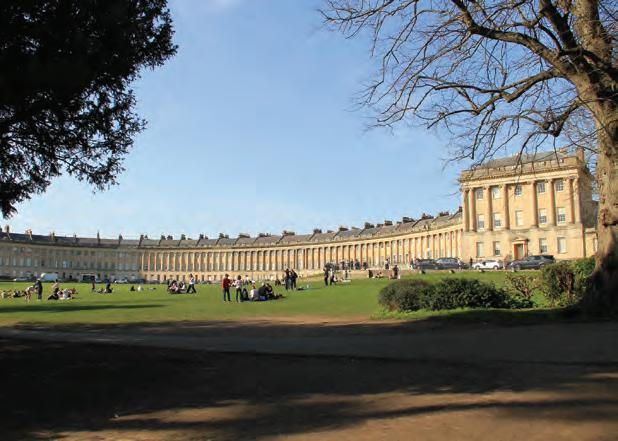
The archway linking Lansdown Place West to Lansdown Crescent was not part of the original design, but added by William Beckford, who occupied the houses on either side. The house with the full-height bay at the other end of the crescent – No. 1 – was built by 1786 as a detached villa called Lansdown Place. Three years later, it was decided to continue building westward and create a crescent, and the whole development was complete by 1795.
Carry on down Lansdown Place East, cross Lansdown Road and head downhill. Turn left by the Lansdown Grove Hotel, whose central
section dates from around 1740, when it was known as Sandpit House. At the top, turn right downhill. and follow the road as it curves left. After another 100m, follow the road as it doubles back downhill. At the bottom turn right to emerge on Camden Crescent, which was built – as Camden Place – by John Eveleigh. It was named after Charles Pratt, Earl of Camden and Recorder of Bath, whose crest, an elephant’s head, can be seen over the doorways.
Work on it started in 1787, but it was never completed. To the left of the central house, there are another ten houses; to the right of it, however, there are only four. This is due not to the money running out, but to subsidence. There were to have have been six more houses, and the end one, on an outcrop high above the valley, was all but finished. When work began on the ones in between, however, the ground gave way. The end house survived for a few years as a romantic ruin, until it too collapsed one night in a thunderstorm, along with the promontory it stood on.
After walking along the crescent, carry on down to Lansdown Road, where a left turn will lead you back to the city centre.

Many more walks can be found in Andrew Swift’s Country Walks from Bath published by Akeman Press; akemanpress.com
Distance: 3 miles
Difficulty: Some steep uphill and downhill sections; two uphill flights of steps; otherwise all on pavements or tarmaced surfaces



Jim Lawrence is a British manufacturer of iconic, traditional lighting and home accessories. All the products are designed, assembled and finished in-house using traditional techniques. Here we ask the team some crucial lighting questions...
Jim Lawrence was set up from the kitchen table of Jim and Sheena’s Suffolk farmhouse in 1994. Starting with a small range of candlesticks and chandeliers, gates, railings and curtain poles followed to cater for the demand for stylish, designer quality fixtures and fittings, made with natural materials. When a customer asked if Jim’s candlesticks could be made electric, the lighting side of the business began and this now accounts for 60–70% of the company’s sales.
Q. Are there challenges to finding good lighting solutions in period homes?
Period homes are often unique and need a thoughtful approach to lighting to match their character. Many of our lights were originally designed with Jim’s family farm in mind. Appreciating that our customers face similar challenges (whether that be low
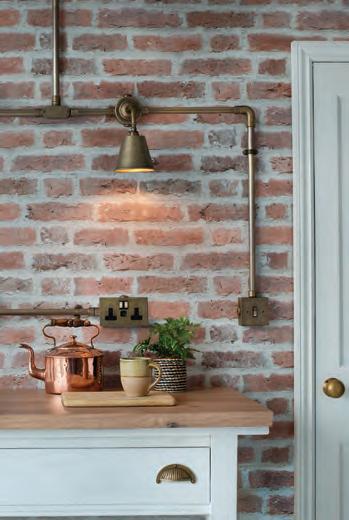
ceilings, solid walls, or quirky electrics) we have adapted many of our designs to solve these common dilemmas or make a feature out of them where possible.
On a basic level, all our cable and chain can be shortened at home or ordered with a longer length depending on ceiling height. At the other end of the spectrum, we design a Universal Conduit Kit –ideal for introducing heritage, industrial style to a property or where solid walls prevent customers from hiding electrics in a cavity. We also recently added Plug-in Wall Lights to our collection, allowing customers to enjoy our best-selling Wall Lighting designs without the need for an electrician.
Q. Why are different levels of lighting in a room recommended by designers?
Layering your lighting is essential for adding depth and modifying the energy around you. Bringing in pools of light from different sources like table lamps, wall lighting and pendants is the key to a balanced atmosphere while giving you the option to dial the cosiness up or down depending on the mood or time of day. With us there’s ample choice and, where lampshades are involved, an extensive catalogue of fabrics to bring a little texture and colour to your home too.
Q. What approach to lighting would you advise for a multi-functional space?
Rooms that are multi-functioning such as a kitchen, bathroom or utility room, will require more light than a bedroom or living room. In a kitchen diner you might need brighter light for cooking, a more subdued look for hosting an evening meal and something in-between for everyday use.
Centrally placed ceiling or pendant lights will throw their light all round a room so are better for general tasking purposes, whereas a wall or ceiling-mounted spotlight can be angled towards you to give bright, focused light, or away from you onto a wall or ceiling to add to the general ambience.
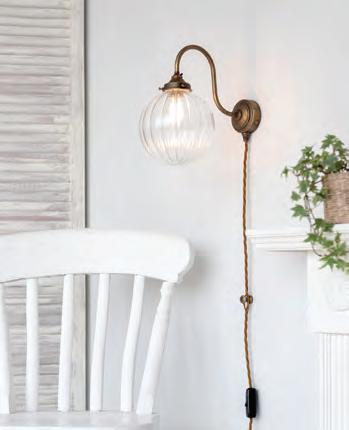
Q. Can you calculate the level of light required in different sized rooms?
While there are no strict rules, you can work out the approximate level of light you need by calculating your room size in square metres and multiplying it by 19 for LED or CFL bulbs and by 15 for halogen bulbs.
For example, if your room measures 4m x 5m it has an area of 20 square metres. If you are using LED bulbs, multiply this by 19 (20 x 19) giving a total of 380 watts, or 3800 lumens. The lumen level will vary depending on the bulb so check the lumen level of each bulb to ensure you reach your overall target.
Q. Should the direction of windows affect people’s lighting decisions?
Absolutely. North-facing rooms tend to be cooler and darker than south-facing ones which are typically warmer. East and westfacing rooms vary throughout the day.
If you get a lot of sunlight during the day you may only need ambient low lighting to relax with at night. In turn, a shady room may require a few lighting options to maintain a lovely light throughout the day.
Q. What restrictions are there with bathroom and kitchen lighting?
Great care must be taken when considering bathroom lighting. Featuring hand-blown glass and specially designed fabric shades, our collection of bathroom lights is IP rated for use in a wet environment and made from the highest quality natural brass and steel to ensure their quality and durability. What this means in practice is while retaining the style and vintage of old-fashioned light fittings, each design is carefully constructed to meet the latest British standards.
If you’re unsure about IP ratings, there is more information on our website but don’t hesitate to pop in and ask us in the showroom for further advice.
Q. How have lights and lighting design adapted around sustainability?
Our lighting designs have always been sustainable as they are made of solid, natural materials such as brass and iron, which can last a lifetime if treated well. They are also infinitely recyclable as both materials can be melted down and used again. Probably, the biggest impact on sustainability has come from the move to LED bulbs as they use a fraction of the energy of old-fashioned halogen and incandescent bulbs.
Q. What do you advise for outdoor lighting?
Whether you embrace cottage-garden style, favour the contemporary or are chasing a traditional look, we have many outdoor lighting solutions to suit your style. However, for those after something a little different for a central source of light and an authentic rustic feel, our hand-cast iron Fire Bowl creates a stylish focal point for outdoor entertaining, as well as a great source of warmth and light on those cooler evenings. Our Hurricane Candle Sconce will also add magical light to a patio, courtyard or barbecue area or wherever you would like to enjoy flickering candlelight where wiring is impractical. n
Jim Lawrence Lighting and Home, Bath Showroom, 114–116 Walcot Street, Bath; 01225 430691; jim-lawrence.co.ukTask, mood and feature lighting
Task lighting refers to the places where you work the most so need the brightest lights, such as kitchen worktops, home office desks and bedside reading areas. These might be in the form of pendants, spotlights, or other more directional forms of wall lighting.

Mood lighting is used to enhance the room beyond the main source of lighting. Wall lighting, floor lamps and table lamps are an excellent choice for adding depth to your room with pockets of layered light. Dimmer switches can be used for further control.
Feature or accent lighting might be used to highlight artwork or shelving. Designated picture lights are lovely in traditional homes, but smaller down-facing wall lights are another option for more contemporary styles. Feature lighting can be applied to statement pendants that split up different zones by drawing the eye. A series of pendant lights or a unique piece above a dining table will help differentiate the dining space from the kitchen’s work zones.





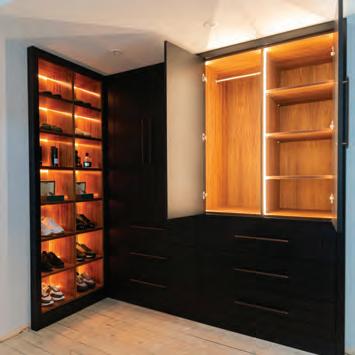








“Now that summer is arriving, take the time to sit back and enjoy the sensory experience that a garden offers,” says Elly West, who this month lets us in on the best ways to engage all five senses...
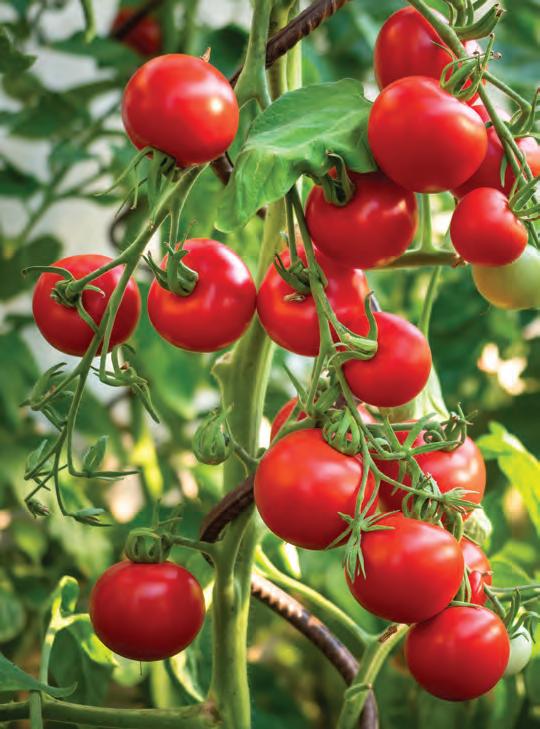

The experience of being outside and in the garden connects us to nature and is undoubtedly good for our wellbeing. One of the reasons may be because it is such a sensory experience, encouraging us to engage with ourselves and our immediate surroundings, rather than with the stresses of the outside world. Four of our five senses come to the fore when gardening, without any effort whatsoever. Sight, touch, scent and sound are there for the taking. The last, taste, is there as well, if we grow our own food or just want to nibble the end of a blade of grass as we go. Or maybe that’s just me.
All gardens are sensory, but some more so than others. The more senses we engage, the richer the experience. ‘Sensory gardens’ have become a thing, particularly in schools and other community spaces, such as care homes, hospitals, parks and retirement homes, where they can provide an educational, stimulating or calming experience to promote relaxation and good mental health. These gardens can also be used for therapeutic purposes, particularly for people with sensory impairments, such as blindness or deafness.
When designing a garden, it’s well worth thinking about how our senses will engage with the space, as this brings extra pleasure, sometimes on a subconscious level. Many of my clients will ask for scented plants, particularly near a seating area, but ones that cry out to be touched and stroked encourage a further interaction, allowing us to connect more fully with the space.

When choosing plants, think about texture. Lamb’s ears, Stachys byzantina, are especially loved by children with their silk-fur leaves. I can’t walk past certain grasses without instinctively reaching out to touch their fluffy seedheads or rake my fingers through the leaves. Even a clipped box hedge calls me to run a hand along the top and feel its springiness. Trees with shiny bark, such as Tibetan cherry, with its polished rings, or the gnarly-ness of a crab apple trunk can be experienced through our fingertips. Sometimes we need to wear gloves
in the garden, to protect from thorns and brambles for example, but mostly I prefer to garden without gloves on so that I can feel as I go. Sound comes to a garden without deliberate action, birdsong for example, bees buzzing, or leaves rustling in the wind. But we can think about how to bring in more of these natural sounds with the plants we choose. Some flowers are particularly attractive to bees and the buzz that accompanies them, such as lavender, echinacea, rudbeckia, Liatris spicata and honeysuckle. Trees and hedges provide safe spots for birds to perch. Choose plants that rustle in the breeze such as tall grasses, and airy trees such as silver birch.
We can also bring in other chosen sounds to our garden, such as a water feature for the gentle and relaxing flow of running water, or wind chimes. Although keep in mind that the latter have been known to annoy neighbours, so careful positioning could be key as not everyone enjoys their musical tinkling. Scrunching along a gravel path can also be surprisingly satisfying, or the soft thud of feet on grass. Scent is one of the most powerful stimulators of our senses, as it goes straight to the limbic system, the parts of the brain used for emotions and memory. The smell of tomato plants takes me straight back to my grandparents’ humid greenhouse, for example. Likewise the thick leaves of pelargoniums. Think about including plants that
When choosing plants, think about their texture. Lamb’s ears, Stachys byzantina, are especially loved by children with their silk-fur leavesThe striped Bark of Prunus serial x serrulata tree, or the Japanese and Tibetan Cherry Tomato plant Liatris spicata flowers
will provide year-round fragrance, not just summer flowers. Sarcococca, also known as Christmas box, is one of my favourites for winter fragrances, along with witch hazel and wintersweet. Throughout summer there is plenty to choose from when it comes to fragrance. Roses, lavender, jasmine and honeysuckle spring immediately to mind, but also try Cosmos atrosanguineus for its chocolatey flowers, or the towering white Nicotiana sylvestris (tobacco plant) for late-summer evening scent. Indulge your passion for fragrance more fully by creating a herb garden, and be sure to include somewhere to sit where you can be surrounded by the leaves and flowers. A herb garden satisfies taste, another of our senses, and there’s nothing nicer than picking a few fresh leaves of basil, mint or a sprig of rosemary to add to a meal.
Sight is one of the most obvious senses that we use when assessing a garden, and is probably the most straightforwardto analyse. How a garden looks is probably the first thing we notice. The colours, the sense of order, the design, the materials, and the mix of hard and soft landscaping, are all instantly processed when we take in the view, building a picture of the type of garden and how the space is used. Colours, like fragrance, can also affect our emotions. Greens and whites evoke calm and tranquility, while hot, vibrant reds and oranges are much more energising.

Sight is also the sense that we use when we enjoy our gardens from indoors. Consider the view from the kitchen window or main living space for example, as this may be where you spend the most time looking at the garden, or perhaps from an office if you’re working from home. So, now that summer is arriving, take the time to sit back and enjoy the sensory experience that a garden offers, and surround yourself with scent, sound, texture and colour. n
ellyswellies.co.uk
Stipa tenuissima, commonly known as Mexican feather grass or ponytails, is a popular ornamental grass valued for its graceful appearance and soft texture. It has silvery-green leaves and feathery pale-blonde seedheads that sway in the breeze, and can be used in a variety of garden styles, from contemporary to cottage gardens. Dot it around the border for accents and breathing space between the flowers, and to help unify an existing scheme, or en masse to create flowing swathes. It also works well in gravel gardens or in a naturalistic or prairie-style border. This grass is easy to care for, drought-tolerant and unfussy about soil type, although it might struggle on very heavy clays as it doesn’t like wet roots in winter. It prefers a sunny spot, but will also grow in shade. Neat and compact, it’s good for smaller gardens and containers, and reaches around 60cm in height.

60+

Holidays

Providing




Trusted,



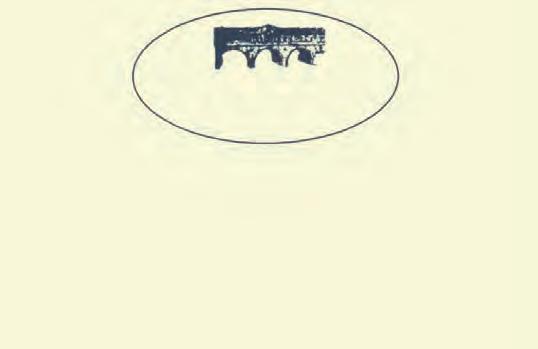

Asubstantial 5-bedroom, detached family home, positioned beautifully in large well-established gardens which has been renovated and improved. Set in an elevated position in a sought after ‘horseshoe’ of 56 desirable homes on Bath’s eastern fringes.


17 High Bannerdown is approached by a generous parking apron giving access to the front garden where there is scope for a detached garage/carport STPP.
Inside the house, the renovation that has been undertaken is clear – it plays to modern family living with ample storage in the hall, light and airy reception rooms, open plan kitchen/dining /family room all opening onto brand new raised decking with bi-fold doors and overlooking the private, and near-level garden. The kitchen itself boasts bespoke units along with a breakfast bar island.
The ground floor is completed by a cloakroom, utility room and useful reception hall. Upstairs there are 5 bedrooms with the largest and second largest occupying both ends of the house and both having ensuite shower rooms. The other bedrooms are all doubles served by a refitted and classy family bathroom.
To the front of the property there is a driveway and hard standing giving parking for 4/5 vehicles. The beautiful and established south facing rear garden has a new raised decking area, ideal for entertaining. It has countryside views and is enclosed to all sides.
Cobb Farr, 35 Brock Street, The Circus, Bath; Tel: 01225 333332
•5 bedrooms, 3 reception rooms
•Large kitchen/breakfast room

•Separate utility room
•Opportunity to develop the plot subject to the necessary planning consents
•Plenty of free-standing parking
•Fine elevated position with lovely views
•Sought-after residential location
Guide Price £1,495,000

OIEO £450,000

An attractive and well-proportioned lateral 2 bedroom city apartment with a stunning courtyard garden, located in a prime central position, close to the world-famous Pulteney Bridge and within 2 minutes walk of Bath city centre.



• 2 bedroom city apartment
• Beautiful, award winning courtyard garden

• Formal drawing room with attractive central fireplace
• Vaulted utility room
• 2 minutes walk from Bath city centre
£1,250,000

An attractive, generously proportioned, semi-detached 3 bedroom riverside property, located in the heart of Bath with a pretty sun terrace, a mooring ring, lovely gardens, private garage and gated off-street parking.
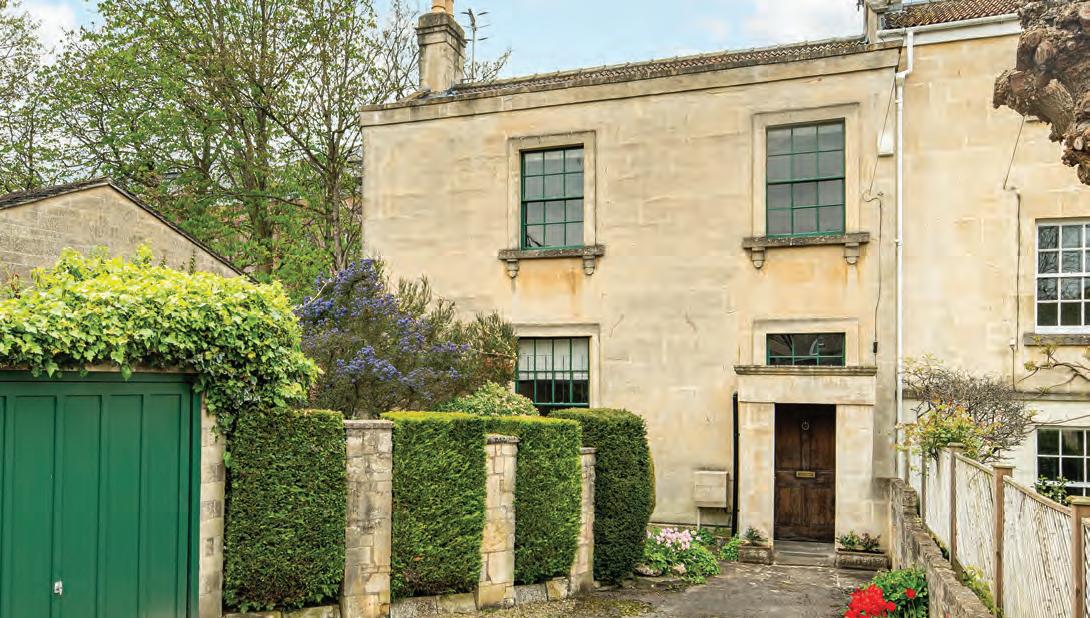
• Beautifully proportioned drawing room

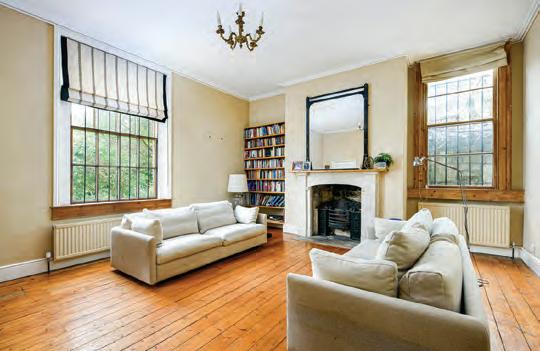
• Kitchen/breakfast room/utility room
• Riverside sun terrace and mooring ring
• Well stocked gardens
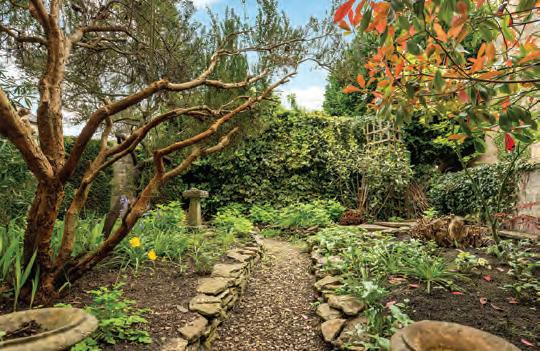
• Private garage and off-street gated parking
01225 333332 | 01225 866111
We






Whether you are looking to let a stunning Georgian property, a purpose built 1970s abode or a sleek modern build, they all have something very different to offer. As a landlord, at the top of your consideration list has to be presentation: prospective tenants want an exceptional home, and you don’t want to give them an opportunity to doubt your offering. As Nicola explains “We encourage all first-time landlords to redecorate their apartment, get it professionally cleaned and add quality finishes. You want a prospective tenant to walk into your apartment for the first time and be wowed – you don’t want them to focus on any negative elements. The more exquisitely presented the apartment the better quality of tenant you will attract.”
When it comes to presentation you also need to consider compliance, and this means looking forward and not just in the here and now. Prospective tenants are really energy aware: they know the difference between an apartment with an E EPC rating and one with a C and what that can mean to their energy bills. Although you are currently compliant the Renters Reform Bill potentially will be looking at a property being required to achieve a C rating by 2025. Therefore, you should always be looking at what small changes you can make to your property to make it future proof.
Bath is a unique city; it is one that has a heart and soul and a wealth of amenities to offer. It is no wonder the people that move here love its variety as well as its strong community feel,” states Nicola Wilkes, Lettings & Property Investment Manager. Just as this city is unique so is the lettings market, and, especially in this difficult time, we wanted to give landlords an honest perspective on what is happening, what to consider and, also, what prospective tenants want. It all comes down to price, presentation and pets being the key to the Bath lettings market.
Landlords, you will be pleased to hear that demand is still high, enquiries have not wavered. In fact what has changed during the last 6 months, in what was a price-sensitive market, rents are strong again. There is no doubt that the cost of living crisis was going to have an impact, and what we are seeing at The Apartment Company is applicants making offers on a property but certainly close to the listed rent. “We are still getting very good rents,” explains Nicola. “Rental incomes being achieved is still higher than those in 2020. The market was always going to get to a point where rents would level.”
Landlords are still investing in Bath and seeing the value which this city and its apartments can deliver. Nicola also suggests that there are opportunities within the sales market at the moment, and we would recommend anyone thinking of investing in Bath to give Nicola a call.
There has been a slight shift in the market with a notable increase in properties that are furnished, although 80% of our rentals continue to be unfurnished. That being said, furnished properties must be high quality, and this brings us to presentation.
The pandemic saw around 3.2 million UK households bringing a pet into their home, according to figures last year by the Pet Food Manufacturers’ Association. This means that there are now 17 million pet-owning homes, and we know this includes many of Bath’s renters. As a landlord, you are no doubt sympathetic to this plight, as we know many of you have discussed options with us to allow pets within your properties. The Renters Reform bill which has recently been put forward to Parliament states ‘tenants will have the legal right to request a pet in their home, which landlords cannot unreasonably refuse’ That being said, on many occasions your hands are tied.
New landlords may not be aware of the need to check the Head Lease for the apartment building – within its various clauses, which sometimes include how the property can be let, will be a clause on pets. We believe there is often a misconception that it is the landlords’ decision not to allow pets when, in reality, it can be the head lease that is sadly preventing such lets.
Having a deep understanding of Bath and its unique property market enables Nicola and her team can help ensure each of our landlords’ investments are the right ones to achieve their goals. If you would like to know more about investing in Bath’s apartment market, contact Nicola today on 01225 303870.
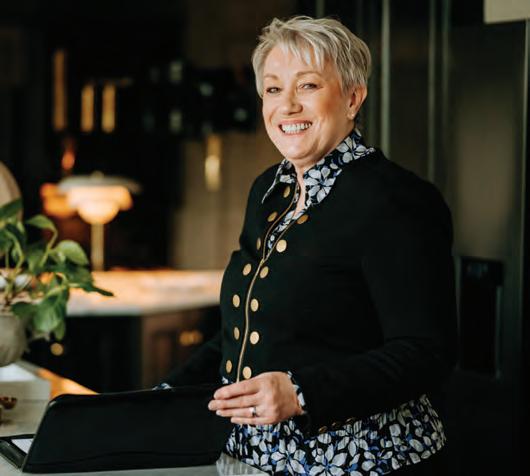


Georgian · Grade II listed · Ground floor ·
bedroom · Open plan sitting room/ kitchen · Period features · Central location · Approx. 526 Sq. Ft.
SOLD
Georgian · Listed · Central location · Double bedroom · Second floor · Stylish interior · Approx. 428 Sq. Ft
SOLD
Detached Victorian mansion apartment · Ground floor with private entrance · Reception hallway · Sitting room · Kitchen · 2 double bedrooms · Bathroom · Village location · Canal walks close at hand · Lovely views



Bladud Buildings
Grade ll listed · Georgian · Top floor apartment · Two double bedrooms · City centre location · Great views · No chain · Approx. 724 Sq. Ft.
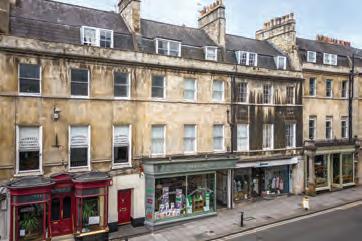


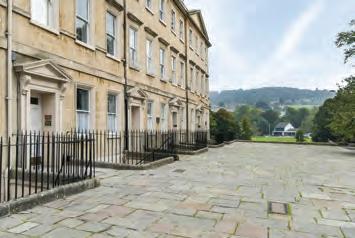
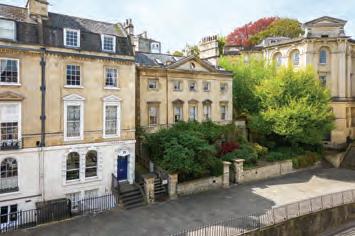
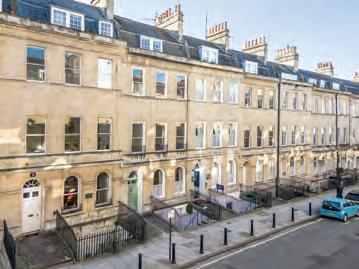
O.I.E.O £240,000
Top floor · Stunning views · Modern kitchen and bathroom · Open plan · Great investment opportunity · Residential area · Level walk away from the city centre · Approx. 478 Sq. Ft.
Battlefields House, Lansdown £1,300 pcm
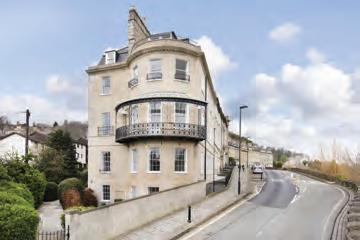


Unfurnished · Courtyard apartment · One bedroom · Two vaulted rooms ·

Parking & garage · Communal garden · Council Tax Band C · EPC Rating D
Green Park £1,600 pcm
Unfurnished · Two double bedrooms · Sitting room · No sharers · Spacious property ·
Mezzanine floor · Council Tax Band D · EPC Rating D
Philip House, Southgate £1,700 pcm
Available now · Fully furnished · Two double bedrooms · Suitable professionals ·
Bike store · Southgate development · Council Tax Band C · EPC Rating C
Queens Parade £1,750 pcm
Available 1st July 2023 · Fully furnished with everything · Georgian apartment · Two double bedrooms · Flexible tenancy length 6 or 12 months · Council Tax Band D · EPC Rating E


Fully furnished · Available 1st July 2023 ·
Open plan living room/kitchen · Two double bedrooms · Minimum tenancy 12 months · Suitable two professional sharers · Council Tax Band C · EPC Rating C
Camden Crescent £2,250 pcm

Available now · Redecorated and new carpets throughout · Three bedrooms · Unfurnished 1100 sq.ft · Stunning views from bay windows · Luxury bathroom · Council Tax Band E · EPC Rating D


Palladian, Riverside £1,500 pcm
Available 12th August 2023 · Unfurnished ·
Open plan living/kitchen · Appliances in kitchen · Two double bedrooms · Community heating scheme · Suitable for 2 sharers · Council Tax Band B · EPC Rating B
Sorry no students · First floor apartment · Two double bedrooms · Newly fitted shower room · 12 month tenancy (minimum) ·
Suitable professionals · Council Tax Band B · EPC Rating D
Bladud Buildings £1,300 pcm
Available 14th July 2023 · Furnished · Two double bedrooms · Stunning views · Luxury bathroom · Sorry no student applications · Council Tax Band A · EPC Rating C
